Golden Jubilee
On October 1, 1969, Don Duco laid the foundation for the collection that is now managed by the Amsterdam Pipe Museum. It all started with the discovery of a remarkable number of clay pipes in the Amsterdam soil. In fifty years, Duco has achieved an enormous amount in bringing the history of the pipe to life. The beautiful collection now offers a complete overview of smoking culture around the world. On various other pages on this website you can get an idea of the collection as it is now, such as under Highlights, or Browsing the collection, or to really see everything, Search the collection.
In addition, Duco has done a lot of research in archives and in the museum's rich library, but mainly researches based on the collection itself. This has resulted in the books that are now regarded as standard works and hundreds of articles. Many of his illustrated articles can be read on the Curator's Articles page.
In the anniversary year 2019-2020, we want to bring the museum closer to the visitor by adding more personal information to this website. Below you can read fifty excerpts from Don Duco's diaries. Together they give an impression of the special moments over the past fifty years that have determined the development of the museum.
Enjoy reading!
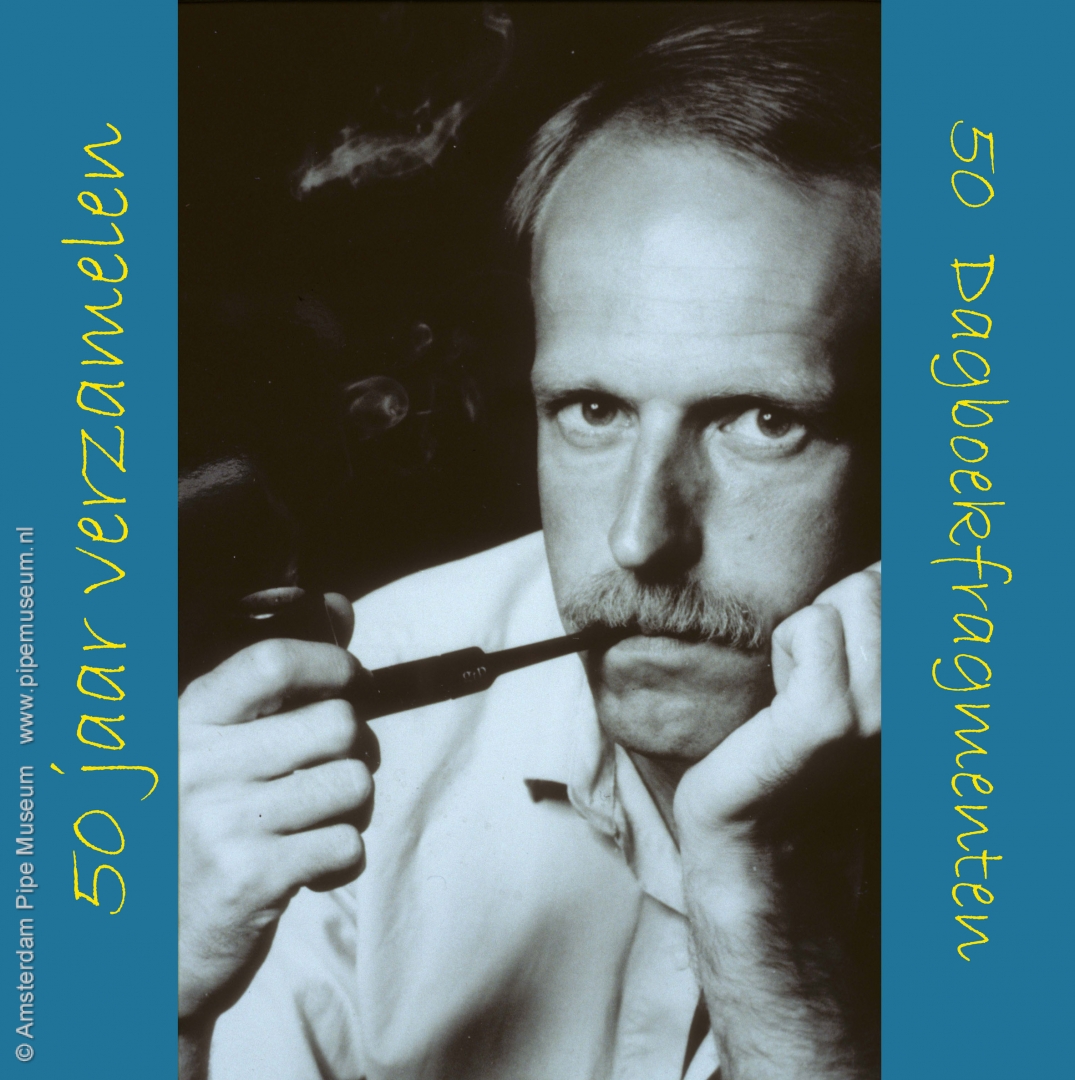
Diary excerpts by Don Duco
Fifty years of active collecting not only yields a serious collection, it is also a period in which you experience adventures as a collector. Every find is a happening in itself. Digging for clay pipe fragments or going to an antique market or auction offers the chance of a trouvaille. Later you discover how special it is to buy an ethnographic smoking instrument on long journeys, still warm from the user. All this, often at unexpected locations and with special people. In a series of posts on Facebook and the website of the Amsterdam Pipe Museum Don Duco publishes diary fragments with memories from the past fifty years. This gives the collector behind the museum a human face. Follow the episodes in this true soap for over 50 weeks. On our website this series is listed in full.
_______________________________________________________________________________________________________________________________________________________
Diary excerpt 1: October 1, 1969
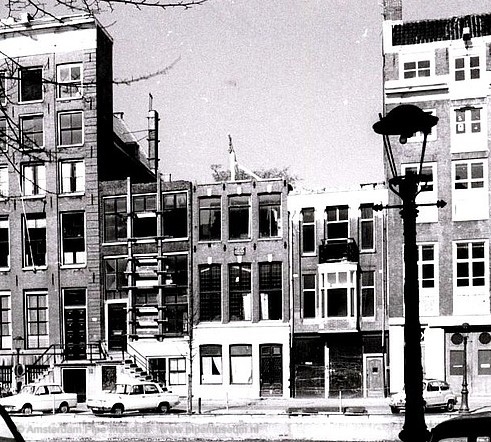
A gaping hole on the Keizersgracht where three rather unsightly buildings used to be and where access is now blocked: a roaring excavator is scooping up dump trucks. Sometimes the truck drivers are lenient and tell you where they are going, not this time. So no other option but to follow them on bike. That is not easy because they go through the IJtunnel into the western harbour area. Anyway, looking out from Basisweg this afternoon and yes: there was one. Quickly following on bike. That brought you to a new piece of reclaimed land along the Hornweg with only the Mobil-Oil on the horizon line. There the black sludge from the trucks is dumped. A free territory where a bulldozer scatters heaps of dark soil. With every push you hear the cracking of the breaking shards, the shivers run down your spine. When the bulldozer is gone, you can enter the terrain, but be careful, at the end it turns into quicksand. Then it is not difficult to pull ceramic shards, glass fragments and especially clay pipes from the pitch-black ground. The waste of the Golden Age once deposited in a large rectangular cesspit. Really, your bag is filled in an instant. It has never been this easy. Tomorrow again!
_______________________________________________________________________________________________________________________________________________________
Diary excerpt 2: March 16, 1970
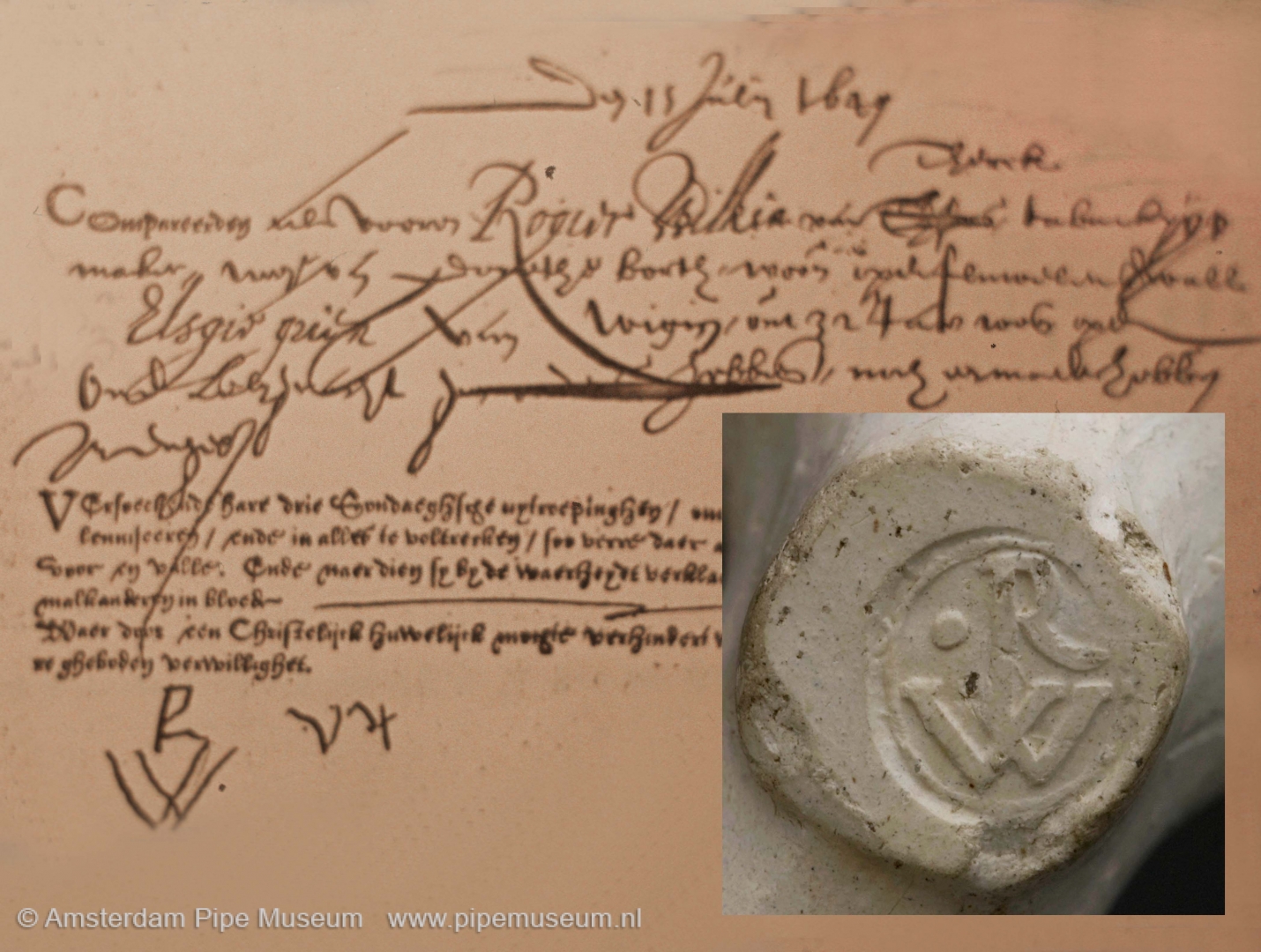
Under the spell of the archive work, today I spent my time again at the Municipal Archives. A modern building with large windows overlooking the Amstel river, a floor that smells of fresh linoleum, and large bookcases in which hundreds of Amsterdam booklets sum up the names of all Amsterdammers from the past centuries. Maarten and I have now discovered that professions are often mentioned. You can then request the book with the original deed to find out more. That is the assignment this afternoon. Combine and deduce with the hope of linking the initials on the pipe bowls to those paper persons from the archive. Bingo! Rogier Wilkin van Therck, widower on the Fluwelenburgwal, married Elsgie Grien in 1649. He is illiterate and therefore signs with his pipe maker's mark RW monogram, exactly as printed on the pipe bowl. The proof has been provided: Amsterdam had its own pipe industry! An archive find and a found marked clay pipe bowl are now of inestimable value.
_______________________________________________________________________________________________________________________________________________________
Diary excerpt 3: November 6, 1970
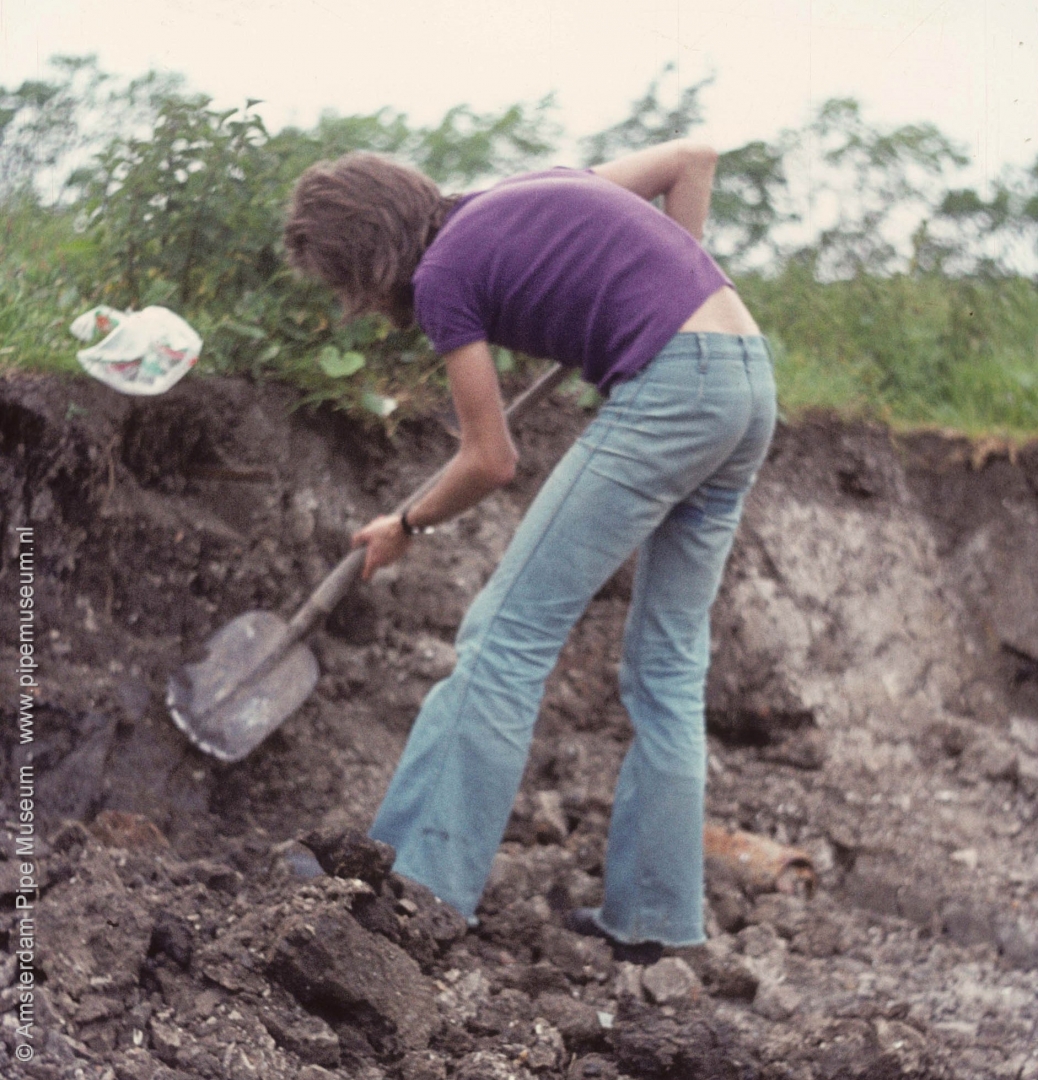
The Bijlmermeer is hot for the Amsterdam amateur archaeologist. Endless white sand is sprayed on and then covered with dark top soil against sand drifts and to stimulate rapid vegetation. The finds are hidden in that black earth. We walked on such a small piece of land today, on an elevated field, apparently in the future the slope of a road. For the sake of convenience we refer to our terrain as the crowned E because half of the found pipe bowls carry that heel mark. By the way, the best find of that day was a silver shoe buckle, but the intriguing question that remains is why we always find the same pipe mark here. Next time back again to find the second buckle; a pair is a pair, isn't it? There may also be an answer to the question of the unexpected frequency of that pipe maker's mark.
_______________________________________________________________________________________________________________________________________________________
Diary excerpt 4: August 9, 1973
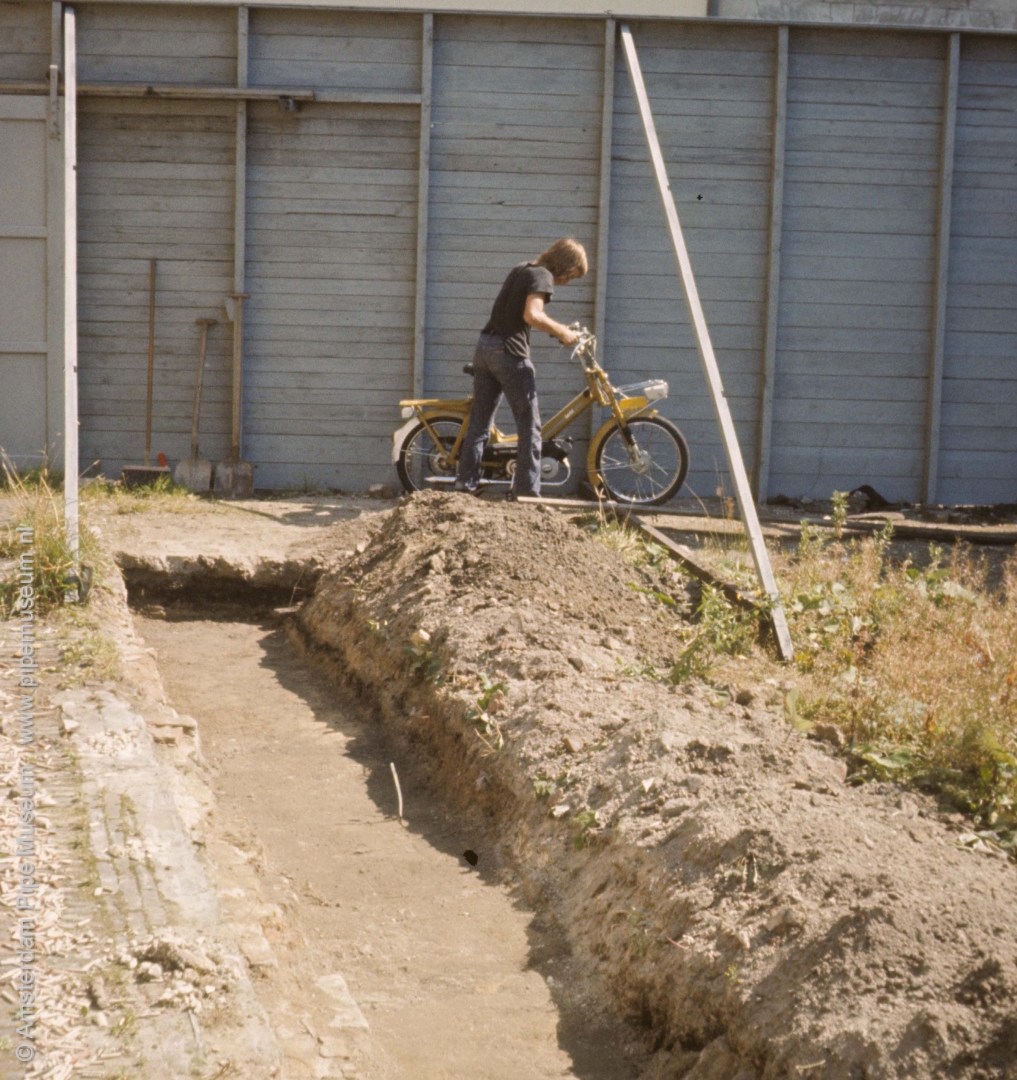
Manufacturer Dirk van der Want handed me the key to the Zenith company’s. Wedged between an elongated warehouse on the left and the public soup kitchen (Volksgaarkeuken) on the right in the Gouda Keizer Street, a somewhat overgrown piece of land extends there. In the past, two pleasant eighteenth-century buildings stood here, furnished as a pipe factory for centuries. Due to their dilapidation, they were demolished with the plan to rebuild them one day in the same style. I got the key to dig on the site into the unsuspected history of the pipe making firm P.J. van der Want Azn., who has worked there for generations. Peter, my digging buddy, and I are the first archaeologists ever on this site. We set up a tent in the middle area, where you certainly don't expect to find anything. Today already plotted a first trench as with a real excavation along the former side wall. See what kind of tracks are emerging with the ardent hope of well-filled waste pits or landfills with factory waste. A warm job in the scorching heat of the August sun. The neighbours reward us that evening: we are allowed to eat in the soup kitchen. Certainly not summer food but sufficiently nutritious for ground workers. By the way, that soup kitchen is an exceptionally cozy loft full of interesting old Gouda people. Set sail early after a day outside.
_______________________________________________________________________________________________________________________________________________________
Diary excerpt 5: June 18, 1975
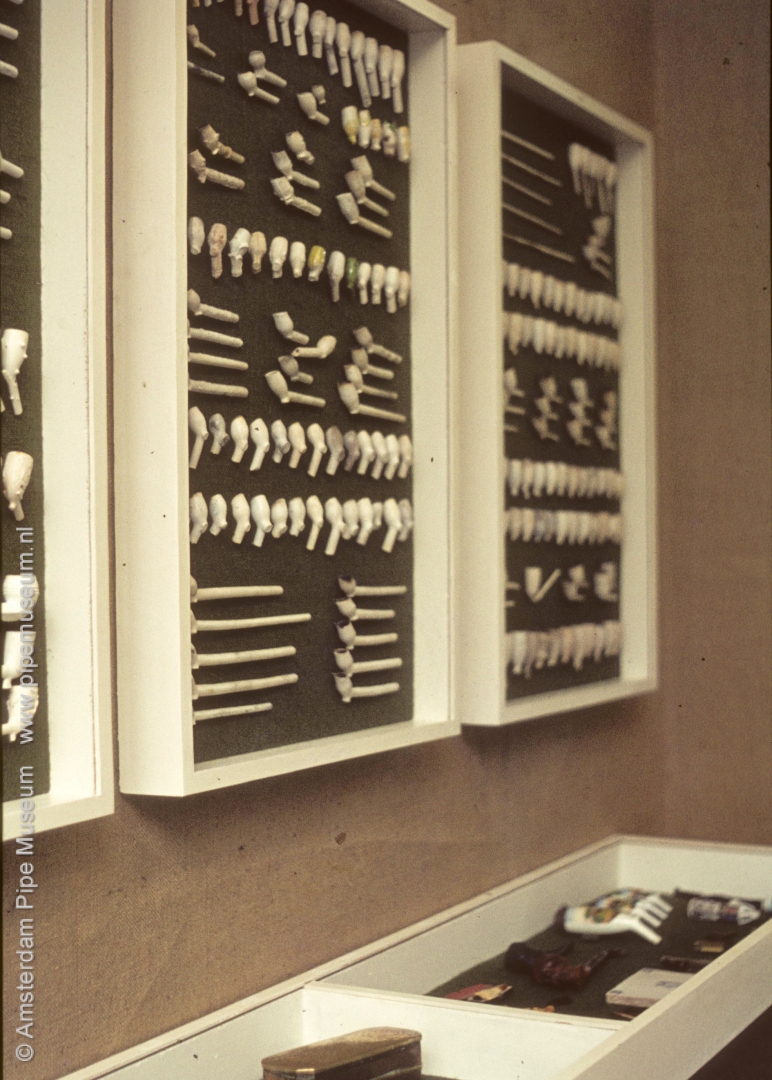
The arrangement with Niels Augustin was quickly made to set up a real Pijpenkamer in the back of his Icon antique market and art gallery on Amsterdam's Frederiksplein. Niels is a man who makes plans easily and with whom it is simple to come up with activities. Nevertheless, a few things were disappointing in the preparation. Filling about twenty square meters with clay pipes is quite a task if it starts with building the display cases, painting and upholstery and only then the actual pipe arrangement. Anyway, today the opening was announced to the press. And of course, it is not completely finished, but it looks nice. The walls of the room are covered with natural jute, on which the contrasting white display cabinets make the result almost monumental. The cabinet interiors lined with green jute are extremely suitable for the white and coloured clay pipes that are sewn on very neatly. Several collectors come by to admire and spread praise. For now, the press is more important, it must ensure general awareness. Well, you don't know to what extent that will work, most of them are journalists at the level of door-to-door newspapers. Very curious what this publicity campaign will bring in the coming week.
_______________________________________________________________________________________________________________________________________________________
Diary excerpt 6: November 19, 1975
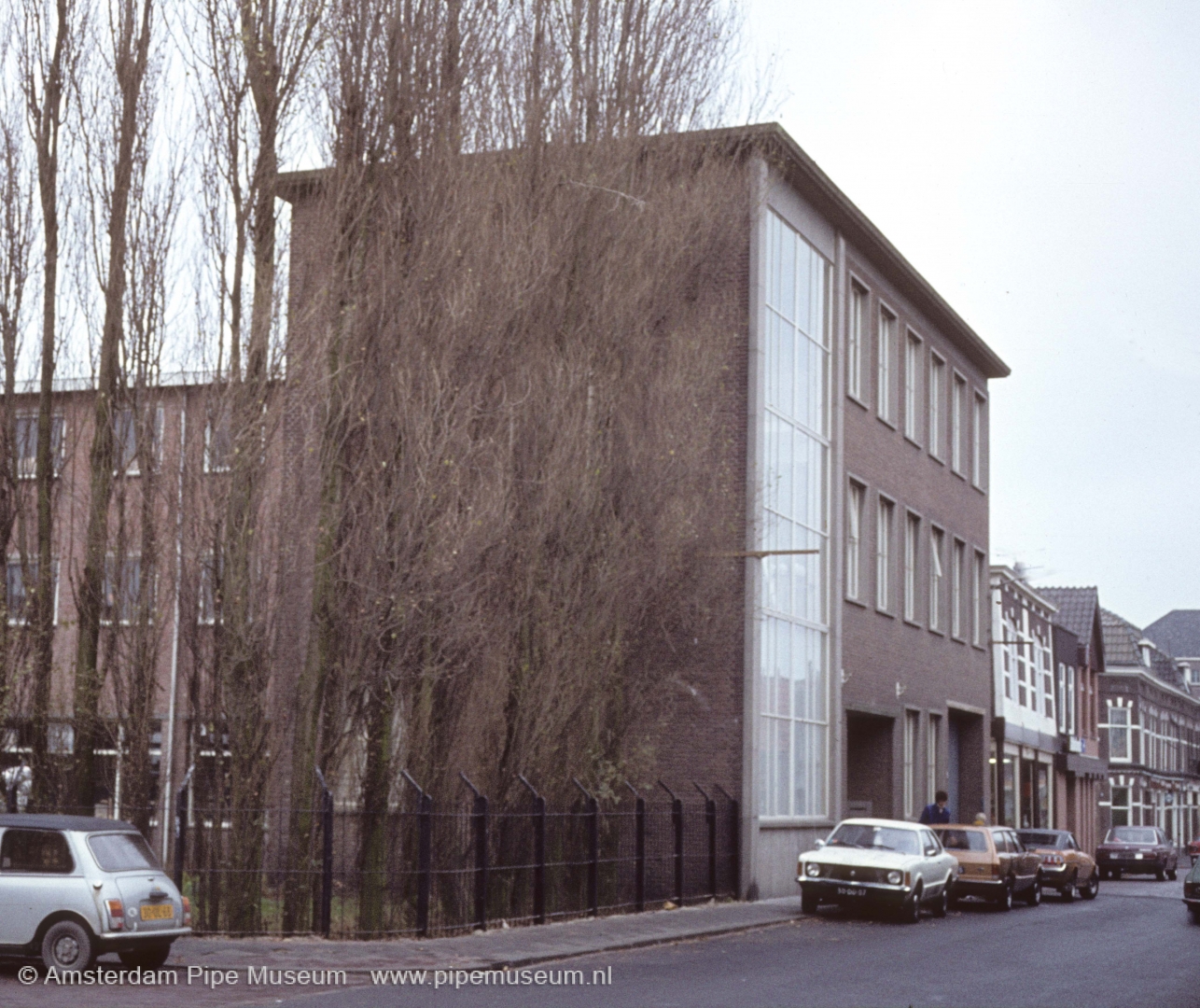
I was cordially invited to attend a lecture held especially for the custodians of the Gouda Municipal Museums. The initiator is Dirk van der Want, who as a pottery and pipe manufacturer is deeply involved in the history of the pipe industry. This is how the idea arose to tell the museum staff more about the functioning of the pipe factory. Visitors to the Gouda museums would thus be better informed about the history. The lecture will be held in the hall of the factory building, where a slide screen and projector are set up. After coffee with stroopwafels as a welcome, the lecture starts. Dirk van der Want turns out to be a gifted and enthusiastic speaker with a loud and clear voice and with constantly shining eyes. From the first to the last generations of pipe makers, all are included in his talk, in which the manufacturer's challenges, the importance of the pipe brand, the shape development and the struggle for existence are linked together in an unconventional way. The museum crew listens attentively and I get filled with new points of view. And as a suitable closure of a men's evening: a glass of gin from the typical square bottle. That loosens up the tongues so that I had to hurry for the last train.
_______________________________________________________________________________________________________________________________________________________
Diary excerpt 7: June 6, 1977
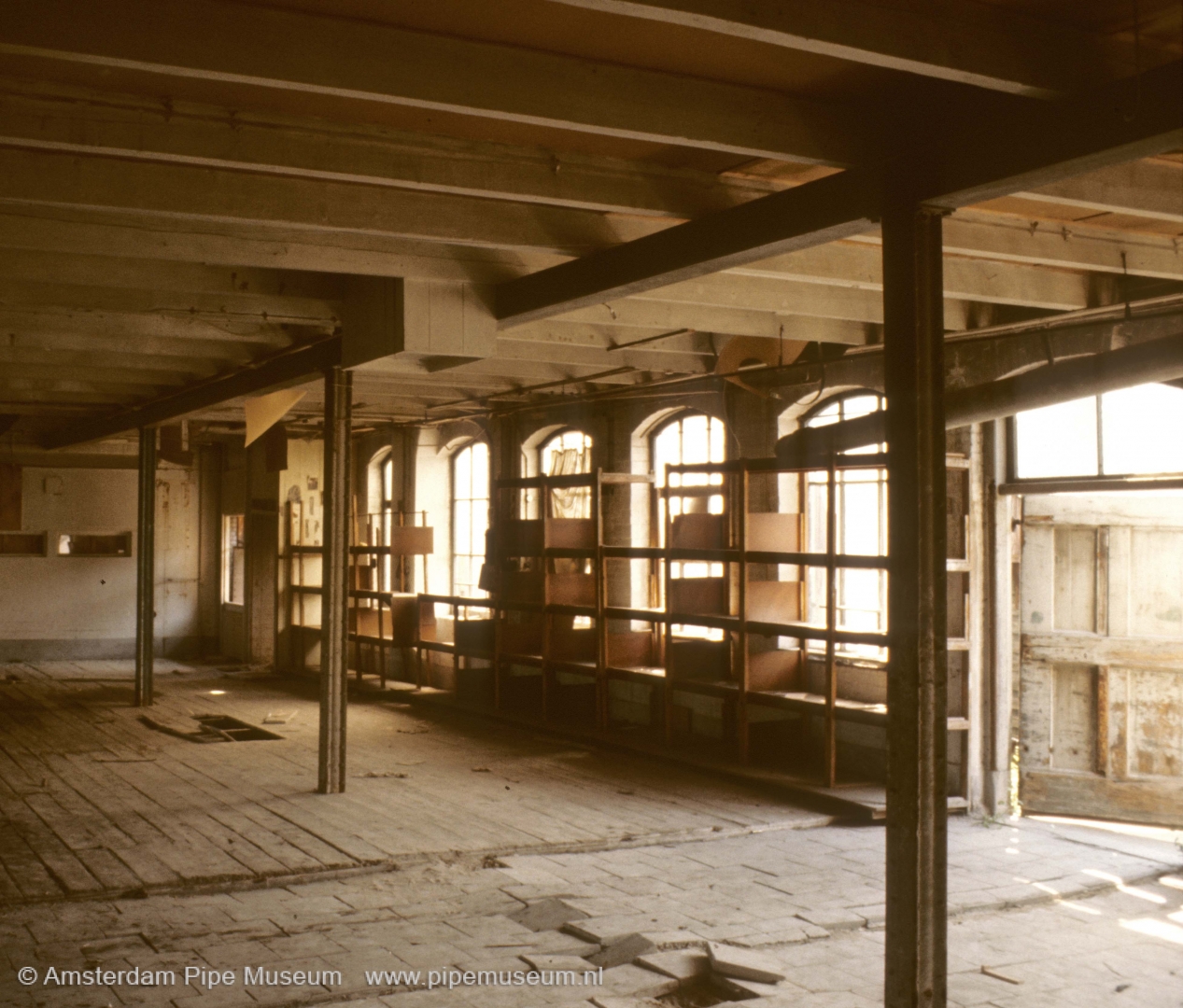
The Goedewaagen factory is moving. The immense building on the Jaagpad was sold years ago and is now being ceded in parts. Most of the inventory has to be removed, only what is still needed for production in Nieuw-Buinen is put on transport. Director Aart Goedewaagen cordially invited me to fish whatever I desire from the inventory. A man called Van Schaik is my point of contact and guides me through the different rooms; I hardly know where to start. All kinds of crates and boxes contain objects from old ceramics to mother moulds and disassembled machine parts. This afternoon I select from the ancient mark stamps all different specimens, one of each. In itself it is surprising that this historical material is still present in the inventory after such a long period of disuse. It soon became clear to me that the Gouda factory is not a company where tidying up was high on the priority list. Of course that now greatly benefits my greed for collecting. While the small tools have been lost at almost all factories, it will therefore be preserved for posterity from Goedewaagen. That will be my task for the future.
_______________________________________________________________________________________________________________________________________________________
Diary excerpt 8: July 19, 1977
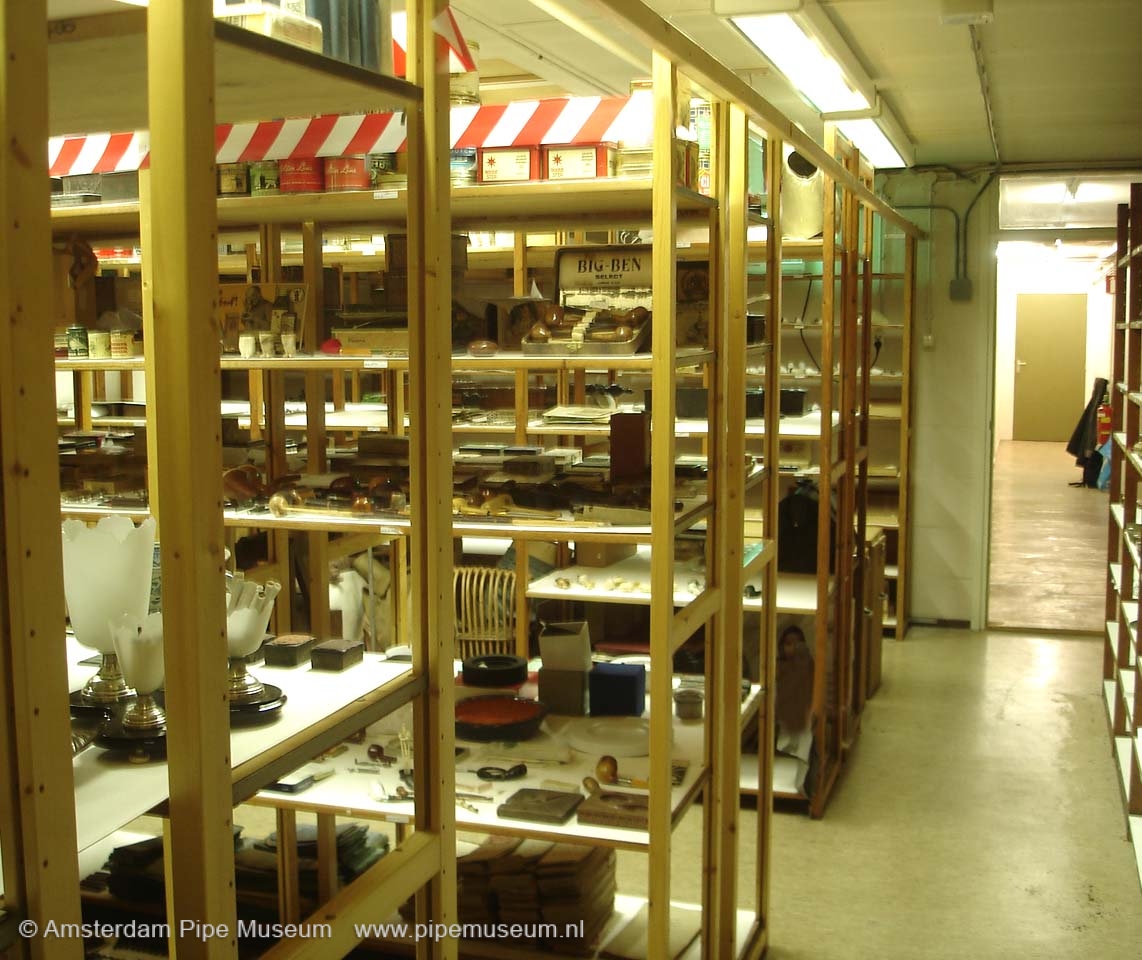
Appointments with Mr. Brongers always take place in the museum reserves in Dorus Rijkers Street, along a dead end road behind the mighty Niemeyer factory in Groningen. Usually he opens the door himself, sometimes also the photographer Middel, because together they man this last house in that lonely street. The spacious reserves are a true el dorado for enthusiasts, so a visit is something I can always look forward to. It is about objects and their history. Large shelves contain literally everything that cannot be seen in the museum and that is a lot. In addition to being an authority as an author, Georg Brongers is an eminent conversationalist and has a story for everything. While it's a getaway for me, my host usually has some work to do. This varies from preparing a loan request to handling correspondence, and in the latter he takes advantage of the occasion to elicit knowledge from me as well. For a collector who has not been on the road for very long, this is a great opportunity to showcase facts, but above all to gain information. So very interesting for me to be able to walk behind the scenes - practically an internship during an afternoon.
_______________________________________________________________________________________________________________________________________________________
Diary excerpt 9: July 2, 1978
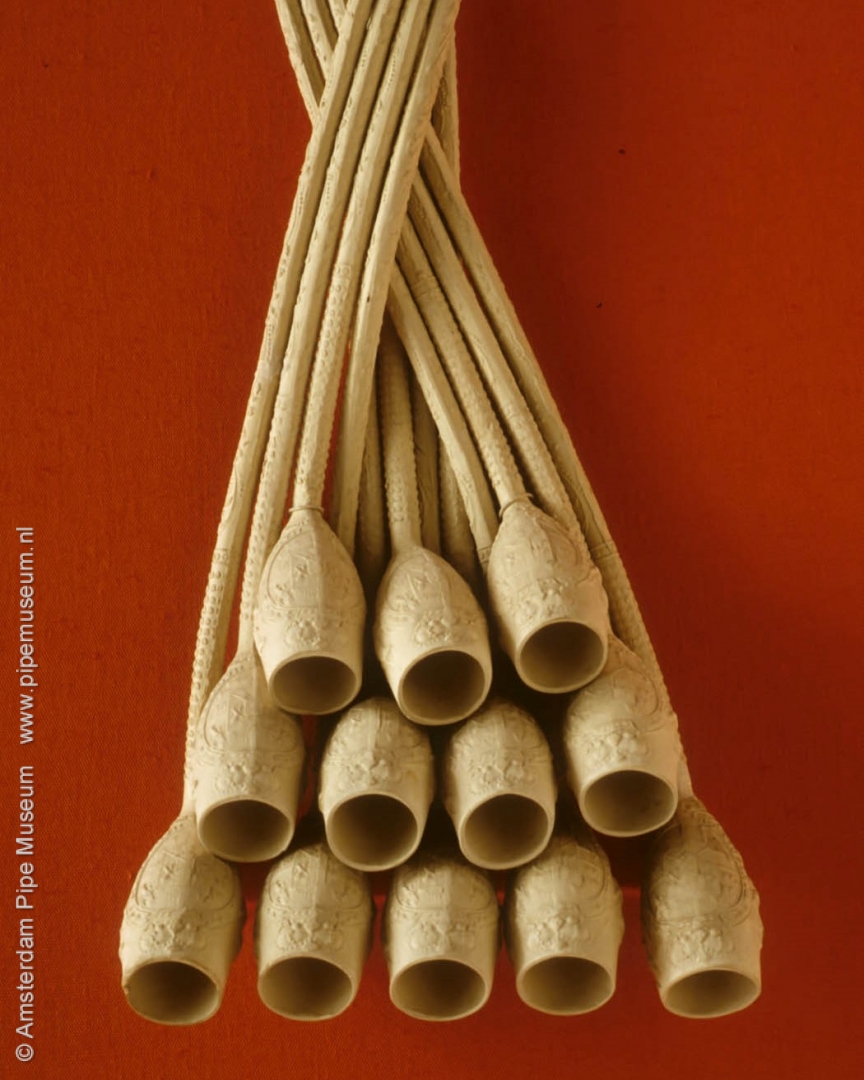
In the past year my historical collection has grown tremendously thanks to the clearing of the Gouda premises of the Koninklijke Goedewaagen. The factory has since moved to the other side of the Gouwe and has settled in the De Producent building. I was very happy when Aart Goedewaagen asked me some time ago to take over the so-called Artwork of Pipes (Kunstpijpwerk). It concerns a panel on which twenty pipes of one meter each have been brought together, the stems of which are woven into a kind of work of art. The Gouda Museum was not interested in this item; through director Josine de Bruyn Kops, Mr Goedewaagen was told that the museum reserves are not intended as storage for the Goedewaagen factory. In the Pijpenkamer in Amsterdam, this unique object would in any case be given a safe place and moreover, it would be visible to the public. Today we picked up the object with a special car with a flat loading floor. It was waiting for us in the director's room, upside down and on edge! Anyway, the object arrived undamaged in Amsterdam. Next Saturday we will start building a display case. The highly damaged golden frame is stored for the time being, it does not seem repairable.
_______________________________________________________________________________________________________________________________________________________
Diary excerpt 10: August 4, 1978
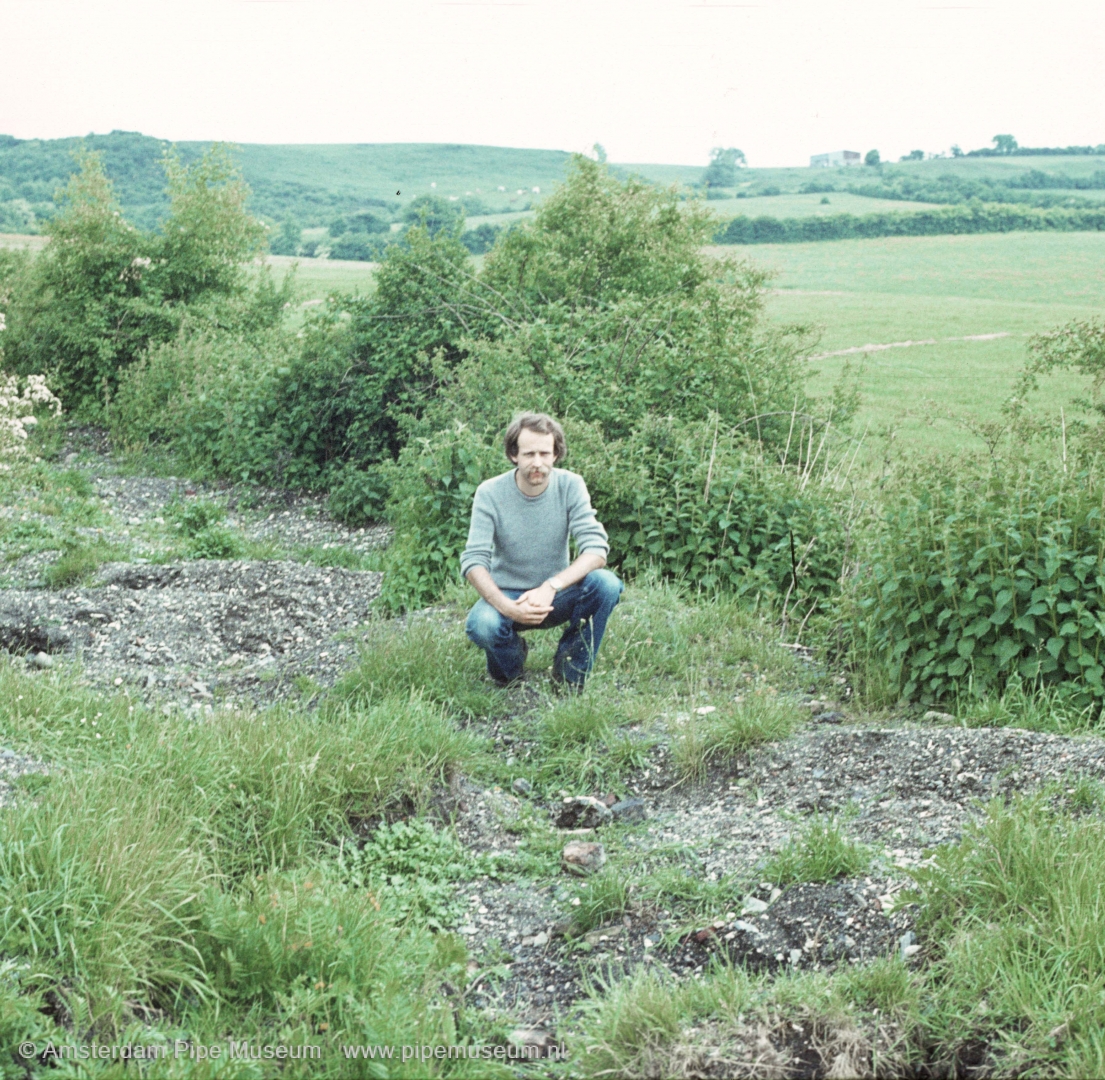
The Gambier factory dump is located on the Route de Famennes in the northern French town of Givet. It is a narrow strip of land where a century earlier a wide ridge ran through the landscape. There, factory workers have brought carts full of misfire and broken material from the factory. Niels Augustin discovered the place, but now it belongs to everyone. Wherever you put a shovel in the ground you will find pipe bowls, luck is with the one who digs just where no one has done it before. Then there is a chance of special finds, although this seems not to work this afternoon. A little later a boy from Givet arrives at the gate along the site on a roaring moped He has found a very nice one and wants to sell it. Chien caniche, or as it says on the bowl Attention, a tall pipe bowl in the shape of a sitting poodle. We talked back and forth and the sale was closed. All finds from that afternoon pale in comparison with the purchase. A second of that calibre is unknown from the factory dump!
_______________________________________________________________________________________________________________________________________________________
Diary excerpt 11: December 25, 1979
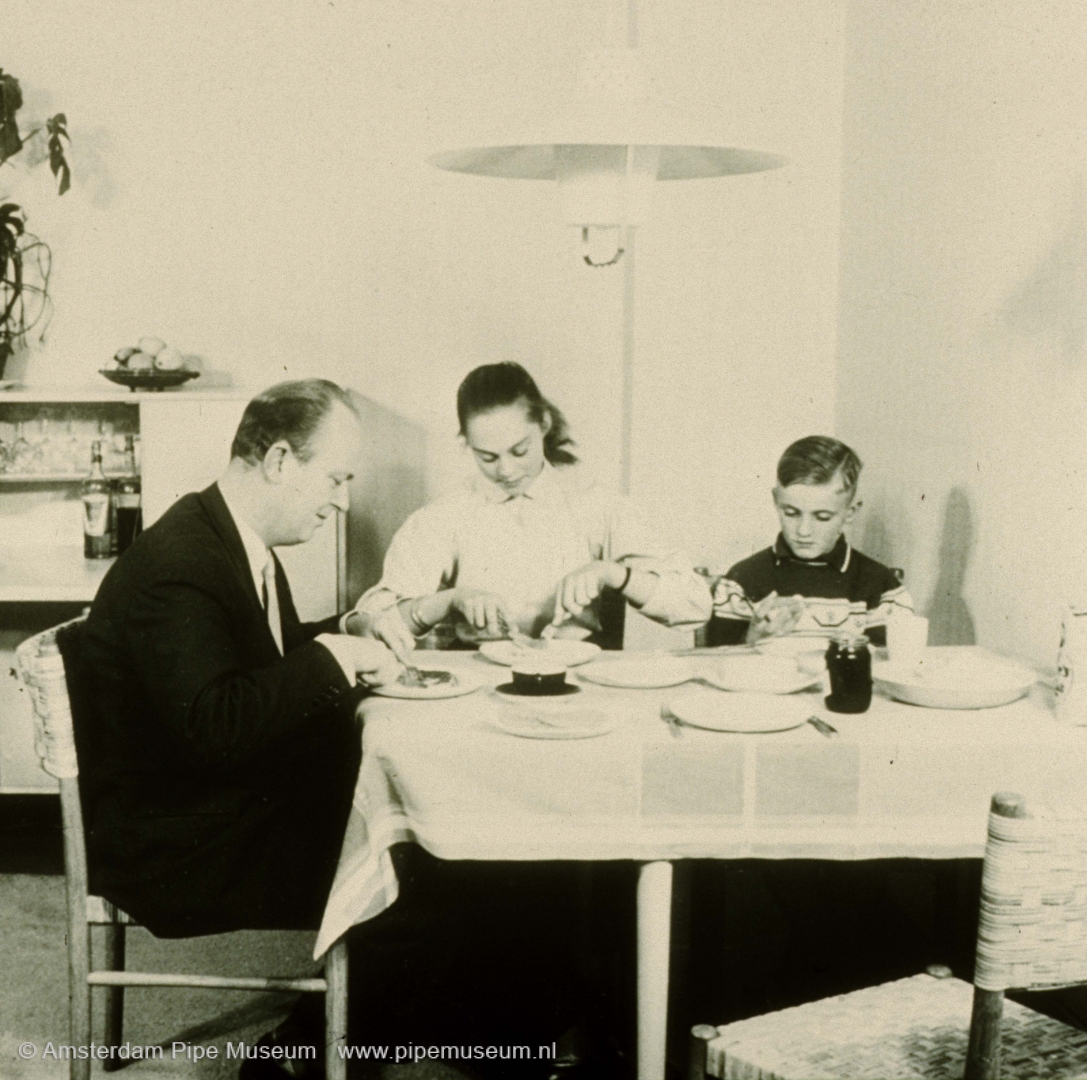
Not for the first time I was invited by the Goedewaagen family to celebrate Christmas. To me, sharing a family party is the ultimate proof of a close bond. Unnoticed, you become part of a family if you have written the genealogy, as I did. Every day I could spend a few hours in the attic of their cosy farmhouse in Drenthe to read archive documents or to browse through photo books. Furthermore, there is the usual family coterie with four children of my age. It feels like I belong to the Goedewaagens, a great honour. The evening meal is the highlight of the day, which is officially called Christmas dinner. Mrs. Goedewaagen is in charge, she devises the menu together with her husband and then organizes everything, including the seating arrangement. If a close family bond is something that you have not inherited from home, such a Christmas party is a very special experience. A family at the table, gathered as a matter of course, the world passes in the conversation Mutual understanding is the starting point, nothing more than civilization the foundation.
_______________________________________________________________________________________________________________________________________________________
Diary excerpt 12: September 28, 1982
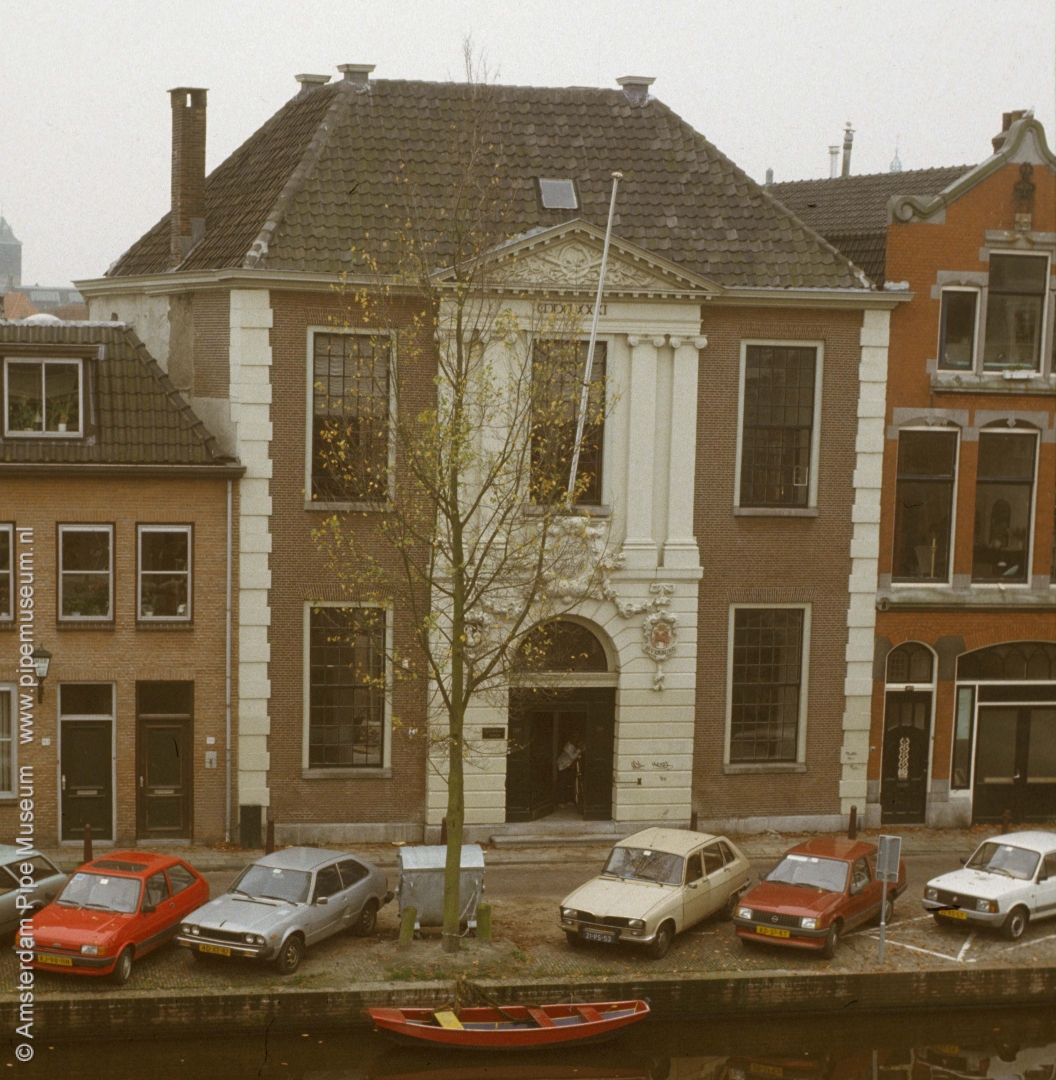
We have worked very hard over the past week to finish the last leftovers tasks on time. Tomorrow is the official opening and book presentation. Today is the preview to get comfortable by showing friends and acquaintances our achievements. We are very proud: our pipe collection is on display in Hof Meermansburg. In the impressive Regents' Room, under the benevolent pair of eyes from the mighty sun in the stucco ceiling and watched by ancient regents from framed portraits along the red velvet walls. It looks good, in self-made display cases, provided with light at the last minute, literally radiant you could say. In addition to classmates and friends, curious new neighbours and residents of the courtyard pass at the back . Tomorrow mayor Broekens of Gouda and curator Brongers of the Niemeyer Dutch Tabacological Museum would add shine to the official part of the opening of the Pijpenkabinet, but today we will keep it informal. We end up chatting around the table with of course Herma, Chrisje, André, Gerard and a few other fellow students. It seems as if we never stop talking in that enchanting room.
_______________________________________________________________________________________________________________________________________________________
Diary excerpt 13: July 6, 1983
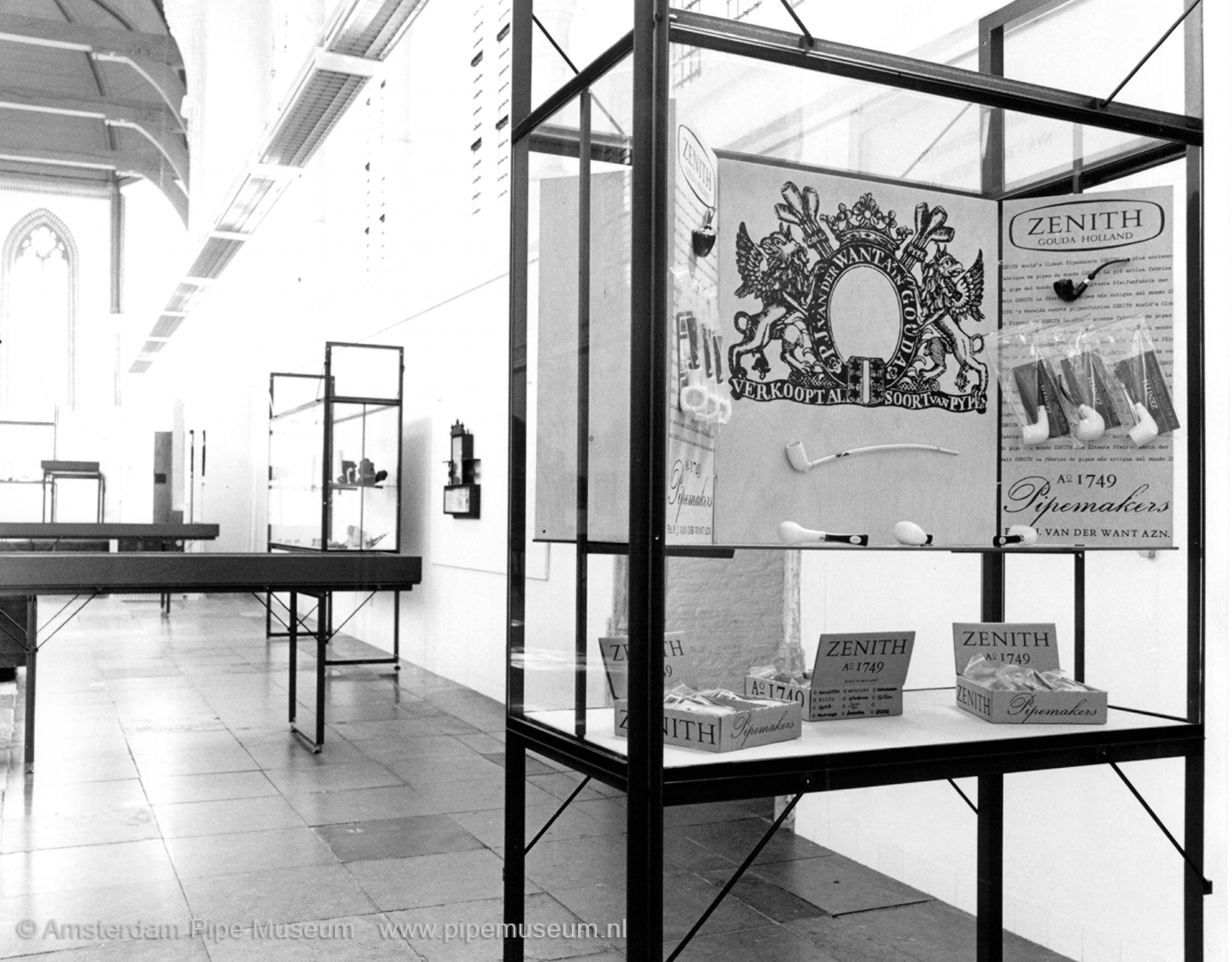
We could only be moderately enthusiastic about the title of our exhibition, but apparently it was impossible to think of a better one: Gouda / once was a / Pipe town. We are proud when the opening starts at four o'clock and the Gasthuiskapelzaal fills up with the Gouda cultural elite. Josine de Bruyn Kops, the director of the Gouda museum, takes the floor and introduces Dirk van der Want, who as the last Gouda pipe manufacturer was delighted to perform the opening act. After a few thank-you’s back and forth - yes, we will not be left unmentioned - the glasses were raised. Compliments are spread and new contacts are made. A festive end to a week of hard work on the arranging of the exhibition, with a much longer time of planning and writing texts. On the way to the train to Leiden, a look in the window of the local newspaper Holland Silhouette, you cannot miss it: the exhibition announced pontifically on the front page of the newsprint. We have again written a bit of history with the Gouda pipe.
_______________________________________________________________________________________________________________________________________________________
Diary excerpt 14: October 14, 1983
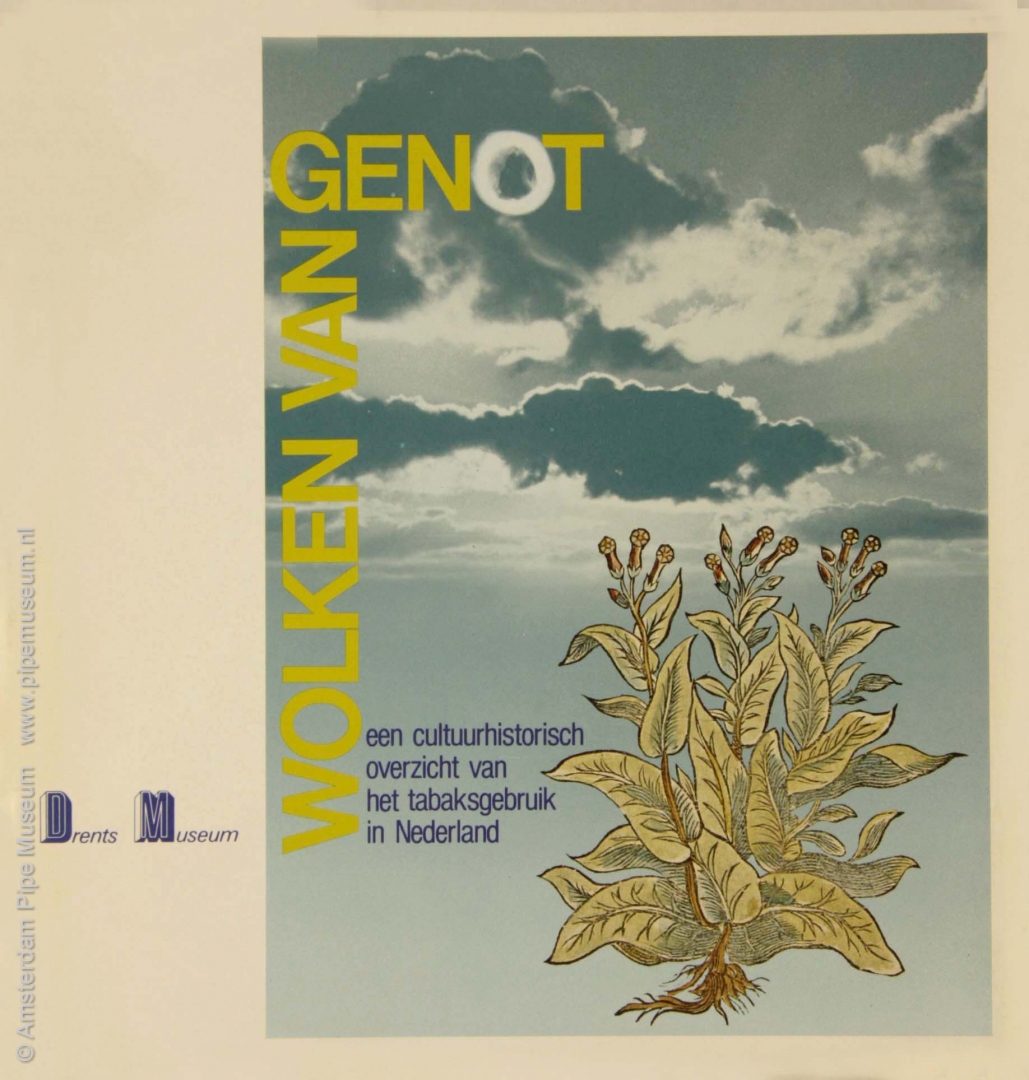
Harry Tupan has come up with a wonderful title for his exhibition: Clouds of pleasure. It will be opened today. And it is not only an exhibition, also a book will be presented. The chosen storyline of the exhibition is chronological and takes you through the relatively small rooms of the Drents Museum in Assen. There, quite a few aspects of the versatile Dutch smoking history are highlighted. Many visitors will think that it is a collaboration between Brongers and Grippeling, two curators with an eye for traditional subjects. In reality, it is about Harry's work. He selected the objects and wrote the texts. Yes, promising for someone in his mid-twenties. I have been able to closely follow the work of my fellow student. But now at the opening it is the right time for lots of praise. All the prominent persons are there, several of them also lenders. The museum is hospitable, drinks and savouries are distributed and every visitor gets a clay pipe and a cone bag of tobacco afterwards to take home.
_______________________________________________________________________________________________________________________________________________________
Diary excerpt 15: October 18, 1984
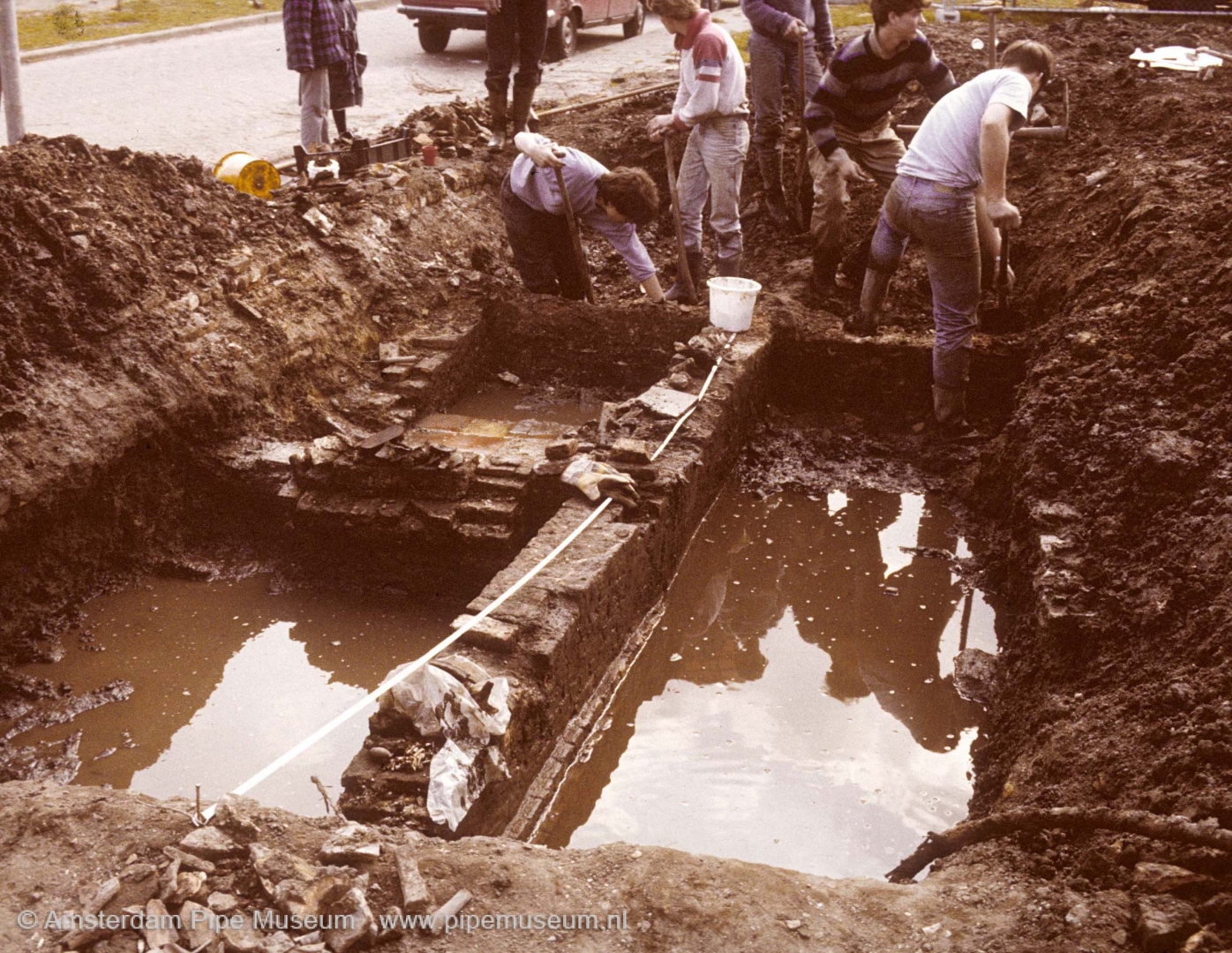
A nice tradition and pleasant change is the annual autumn camp with young people from the Dutch Youth Association for History, which I lead together with Benedict. The third day of this camp dictates further digging on the clearing of the Nobel Street in Gouda. Completely unexpectedly, under the foundations that we largely cut away yesterday, we find a deposit layer with a large number of sintered pipe bowls and especially stems, concentrated in a layer of about a decimeter thick. What exactly happened at the time on the plot where we are now digging, is not yet clear. What we can see, the date of the disaster: somewhere in the years 1630 to 1650. We definitely made a unique discovery, because it concerns a pipe makers’ factory dump of which not so many have been found and certainly not one that mainly resulted in misfires. So, pipe fever, not only among the camp management, but also among the participants. With the rapidly falling darkness of an autumn day we try to dig as long as possible, with magpie eyes we can do that until around eight o'clock. To be continued tomorrow!
_______________________________________________________________________________________________________________________________________________________
Diary excerpt 16: March 11, 1986
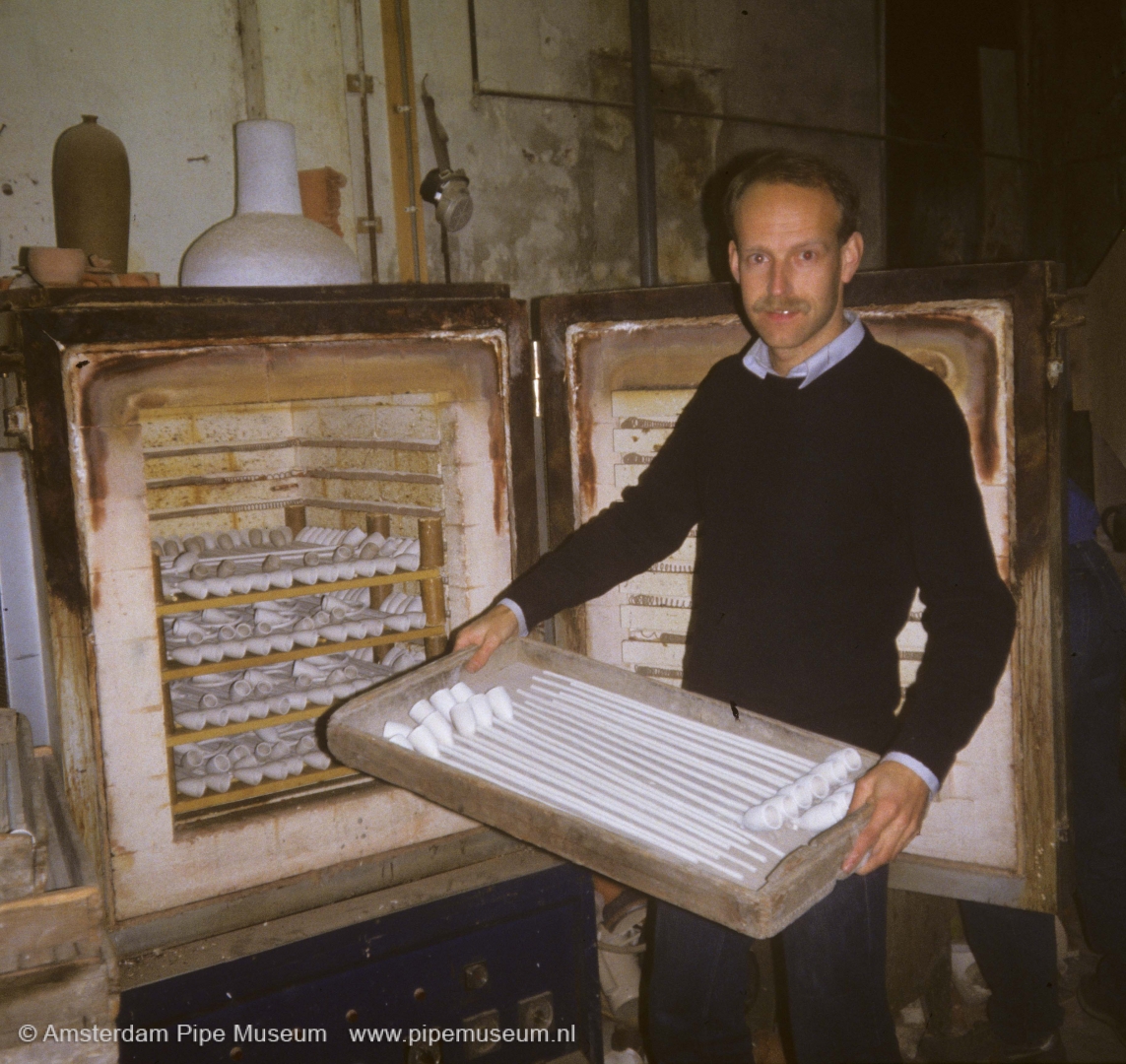
Aart van der Want, the current owner of the Zenith pipe factory, will pick up this year’s gift pipes today. It has been common for Zenith for more than a generation to present its regular customers a historic clay pipe on the factory's anniversary. Since the moment that Steef van Loon no longer moulds pipes due to his back problems, the clay pipes are created by Benedict Goes in the Pijpenkabinet, who presses them in the basement of the museum. This year, Aart has opted for an imitation briar shape, perhaps not the most sexy pipe. The choice of the factory's old pipe moulds is apparently limited. Anyway, they are ready, more than a hundred in the number. They have to show the world that the Gouda pipe industry is still very much alive, supported by the smooth chat of the young director. Few will wonder what that means and no one should know the answer: that industry has disappeared and is now only supported by a museum initiative.
_______________________________________________________________________________________________________________________________________________________
Diary excerpt 17: April 17, 1986
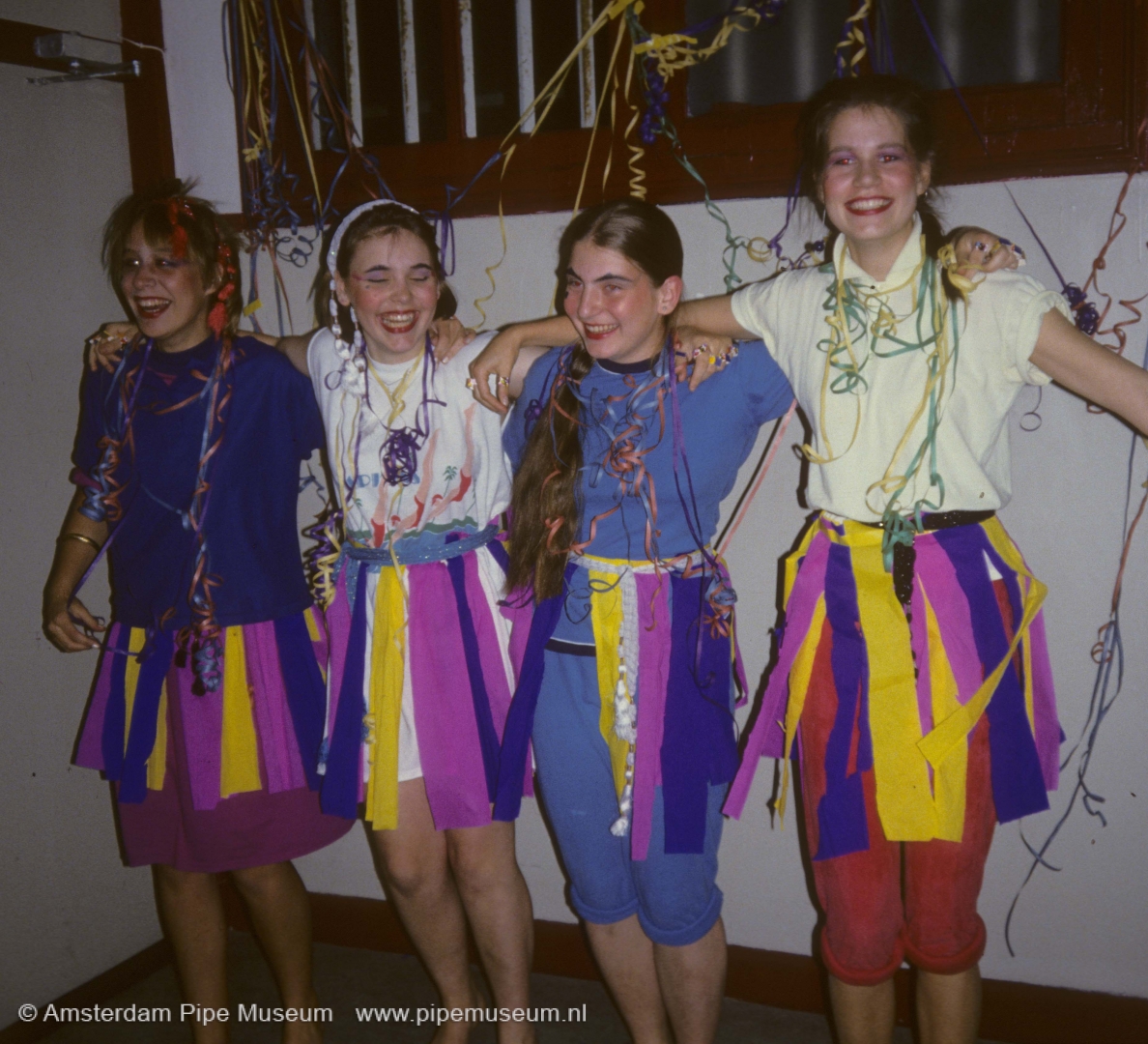
The colourful evening festively marks the end of the Gouda camp for young people between the ages of fifteen and twenty. This year again and now with an endlessly long poem in which a separate verse, by no means always sweet one, is devoted to each and every participant. Also artistic performances by anyone who wants to make a last impression on the group. This time with a real look-a-like Madonna. What for God's sake is the success of these archival weeks, in which people are toiling from nine to five in the reading room of the Gouda archive, on hard-to-read texts that are not always understandable to a teenager. The highlight of the day is a gigantic bag of liquorice on the table, which the entire study room soon smelled of. Be that as it may, Duco's copying class, as the staff calls us behind the scenes, is loved by the archive staff and regular visitors. For them, too, the presence of a dozen teenagers is a complete break from any other week. But the participants are also completely positive, there is quite a lot of laughter. Tomorrow morning we will break up the tents again and everyone will go his own way. We will see the hard core again next time, that's how it has been for years. In the meantime, the Gouda volumes on the shelf are filling up with historical information about the industry and the people who endeavoured to do so.
_______________________________________________________________________________________________________________________________________________________
Diary excerpt 18: October 11, 1986
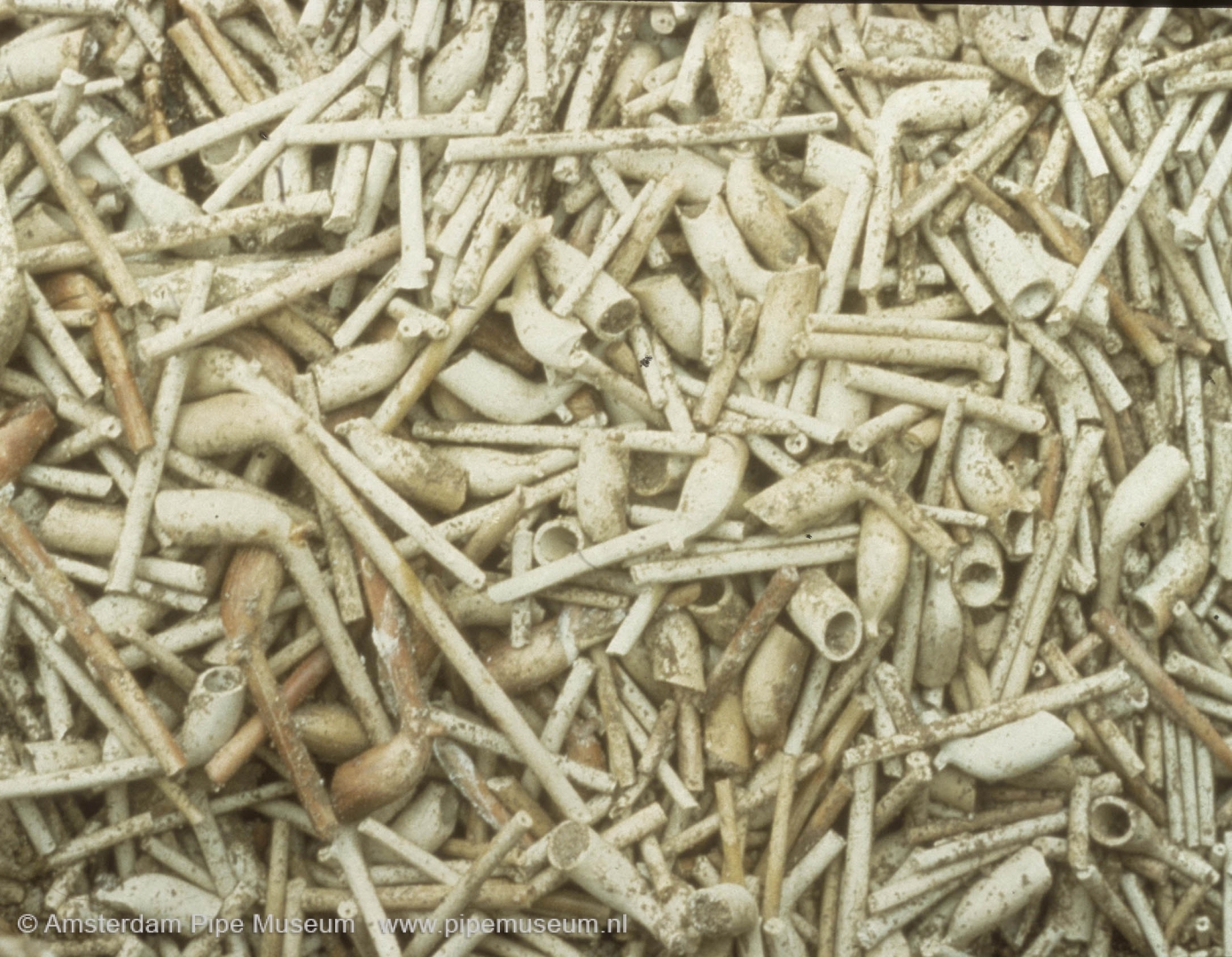
Numerous formalities preceded this exhibition. Loan requests with a lot of paperwork. Today is the big show: my lecture at the opening of Kridtpipor, the exhibition in the City Museum in Stockholm on the occasion of the unique find of, as they say, four hundred thousand clay pipes. The museum shows itself to be exceptionally hospitable by offering me a complete program for the week visiting historical places, including meals at the homes of curators. The lecture is certainly not the best I have given, not because it is in the English language. The slide projector is obstructive and apparently lacks the necessary cooling. If I discuss a picture for a little longer, you will see the slide burning away on the screen. Actually very beautiful, as the image dissolves from the centre with a beautiful colour spectrum, but still very distracting for the speaker. Well, of course that makes you nervous, speaking quickly is crucial. Anyway, after that the official opening will take place and our loans at the exhibition are presented splendidly. Furthermore, the opening is a soiree on a level that seems only possible in Stockholm. Fantastic savouries, superb wines and a lot of hospitality. And all this concluded with a dinner in a historic house, specially hired for the curators with me as a guest of honour. Incidentally, all thanks to the financial support of the Swedish tobacco monopoly. Björn, Lotta, Elisabeth and Inga, thank you very much for this wonderful souvenir!
_______________________________________________________________________________________________________________________________________________________
Diary excerpt 19: October 8, 1987
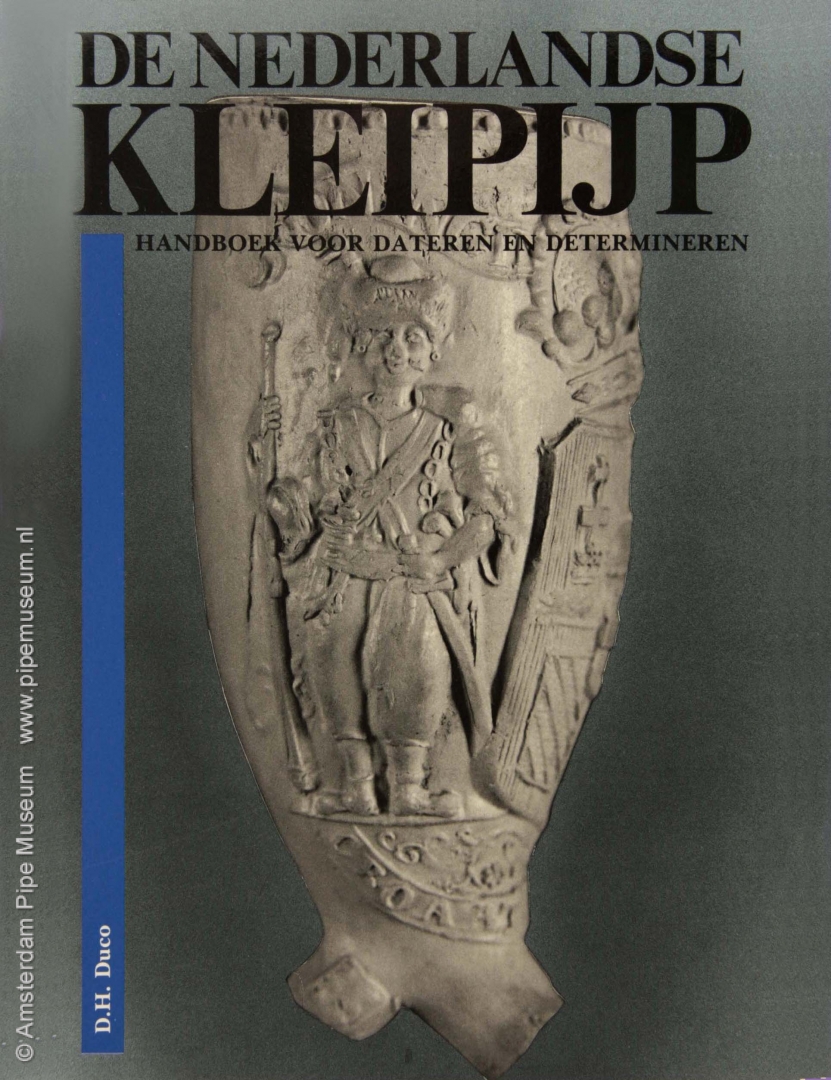
Just in time, the manual was delivered yesterday, the book on which I have worked so hard in recent months, today the first copy will be presented. Reception is in our own regent's room from half past four. And packed it is. Many friends and acquaintances, but also countless people from the professional world. The official part is introduced by the mayor of Leiden, Cees Goekoop with some words of praise for the museum, culminating in the presentation of the first copy of the brand new handbook. Professor Louwe Kooijmans receives the book in his position as archaeologist at the National Museum of Antiquities. The mayor next to the nestor of Dutch archaeology. After that, drinks and savouries are carried around and the service boys can barely get through at first. And of course there is a lot of talking. Never before has it been so crowded in Hof Meermansburg, that the three hundred year old beams can bear all this is a miracle. In addition to being proud of this milestone, we are also very curious about what the manual will bring about. In any case, I have put my ultimate knowledge about the Dutch clay pipe into it.
_______________________________________________________________________________________________________________________________________________________
Diary excerpt 20: November 7, 1987
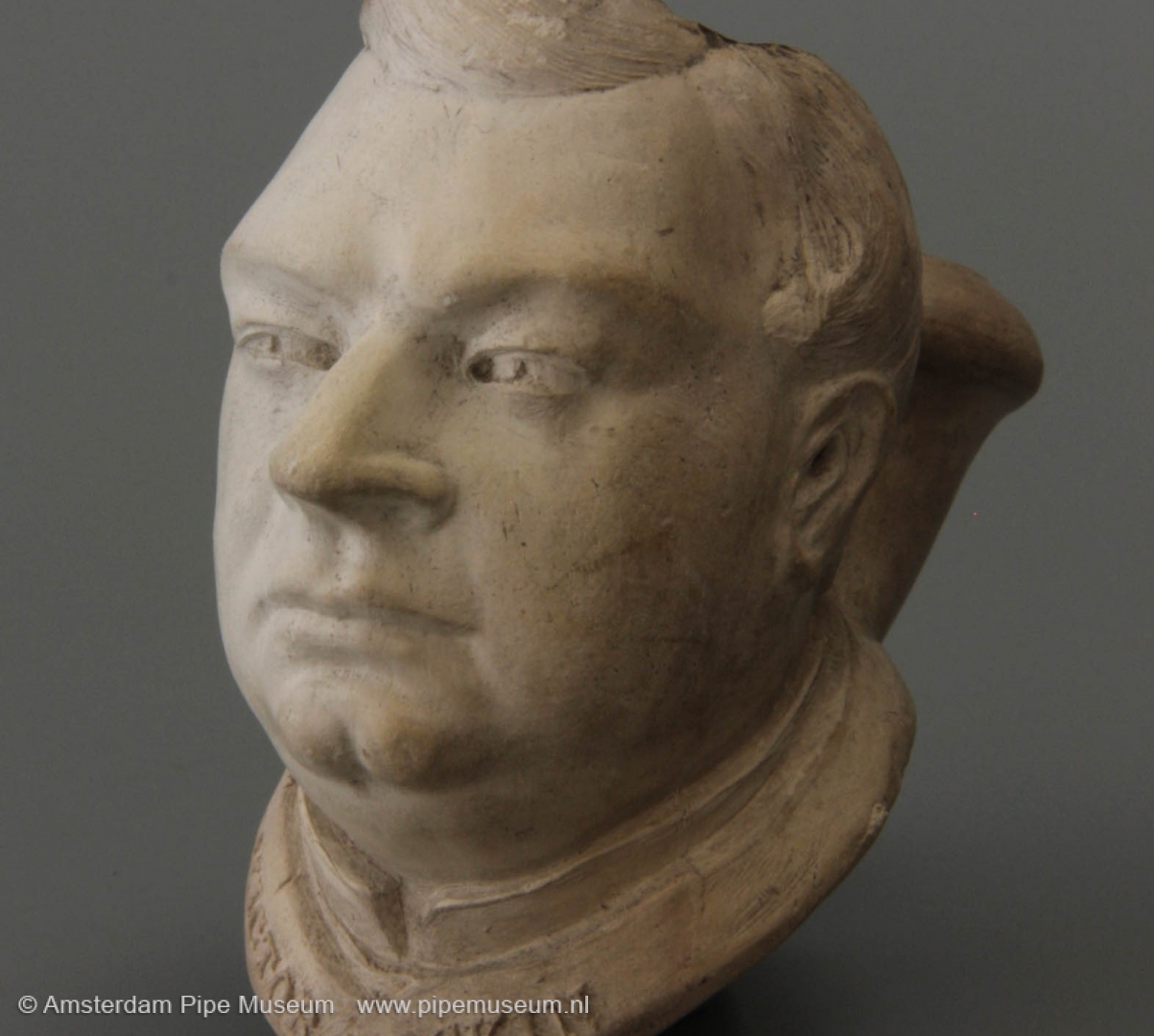
A common course in Paris is a visit to Denise Corbier, an antique dealer specializing in antique pipes. Rue de l'Odeon is therefore almost a guarantee for a special find. In her cosy, overcrowded shop, you will find a lot of jewellery and other typical women's items in addition to pipes. Denise is extremely charming and always greets us like old friends. She has a wonderful circuit of suppliers who apparently know exactly what sells well. And she can sell it. Denise pretends she has withheld something especially for you by conjuring up some antique pipes from a drawer of a secretary. Also this time we buy a series of objects. Most notable is a French-style stub stemmed pipe with the portrait of the singer Victor Raskin. On the bottom it is marked with "NIHOUL A NIMY DEPOSE", so a Belgian pipe. As a folk singer, Raskin was not a bit vain, he had portrait pipes made on his own initiative to hand out to his fans. Those fans were mainly in the old people's asylums in the South of Belgium. A following almost typical of folk singers. Technically, the Raskin pipe is perfect with its well-modeled head with beautiful proportions, so it is a nice acquisition.
_______________________________________________________________________________________________________________________________________________________
Diary excerpt 21: February 19, 1988
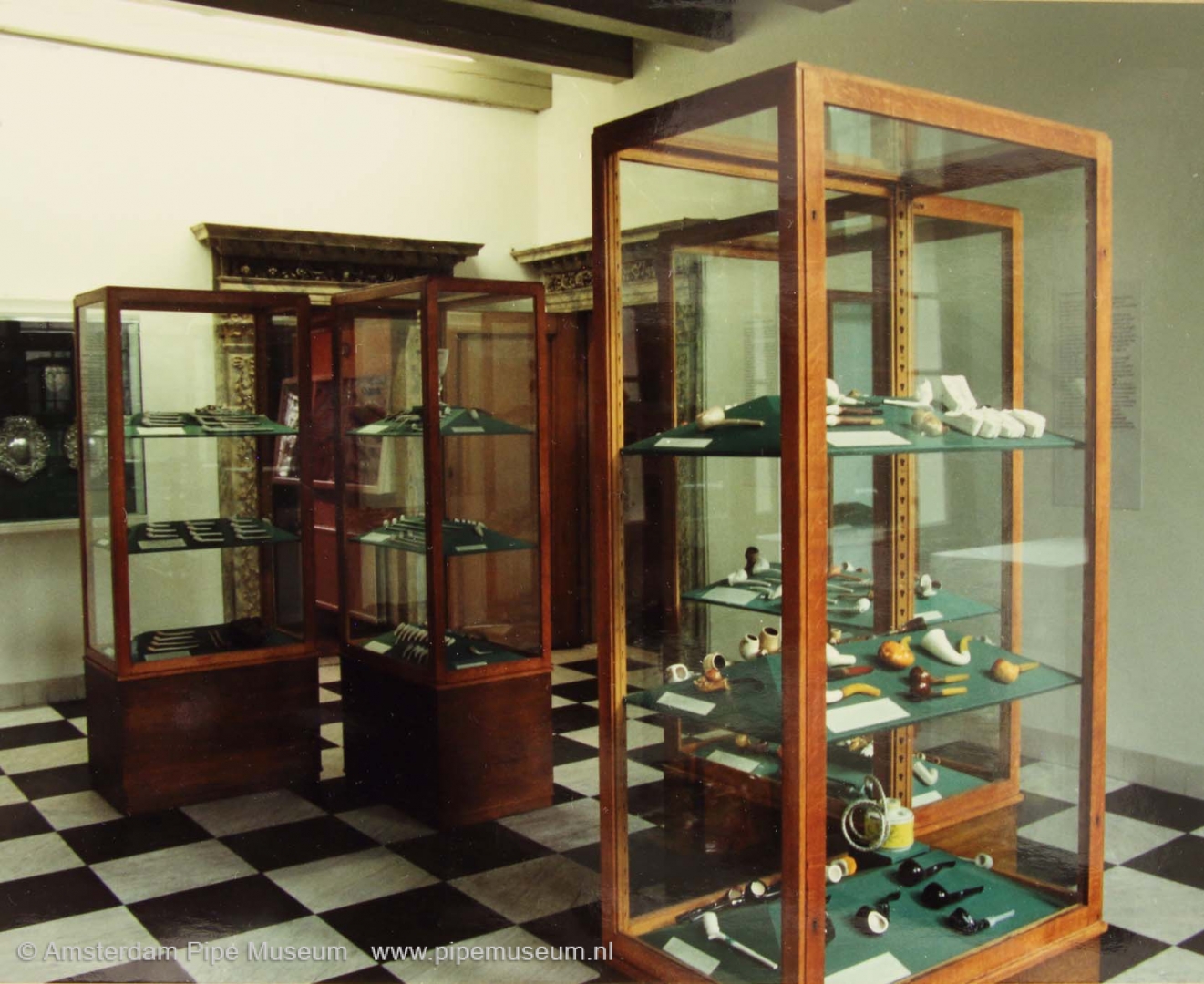
The fiftieth anniversary of Museum De Moriaan is the reason for a celebration, but above all to revise the museum and drastically modernize the presentation. I was asked to redesign the presentation about the clay pipe. Our mission is clear. A permanent exhibition of the history of the Gouda pipe should be placed in the Van Beuningen display cases, an exciting challenge. For the opening today we are honoured by the presence of Gijsbert Helbers, who founded De Moriaan as a museum fifty years earlier. This former museum director is a good speaker, but he keeps it short. With a tap on the lectern, he declares the refurbished museum to be reopened. Within the limited resources, I am very satisfied with the new presentation. It is transparent and well-arranged, with balanced accents for each period. It has become a nice but concise introduction to the matter. Helbers, however, is more a man of rooms stuffed with curiosities and does not seem very charmed by the redesign when touring. And it is true, De Moriaan has largely been cleared out. Yet when entering the museum's main room, his look of recognition of his old love brings a smile back to his frail face.
_______________________________________________________________________________________________________________________________________________________
Diary excerpt 22: November 9, 1988
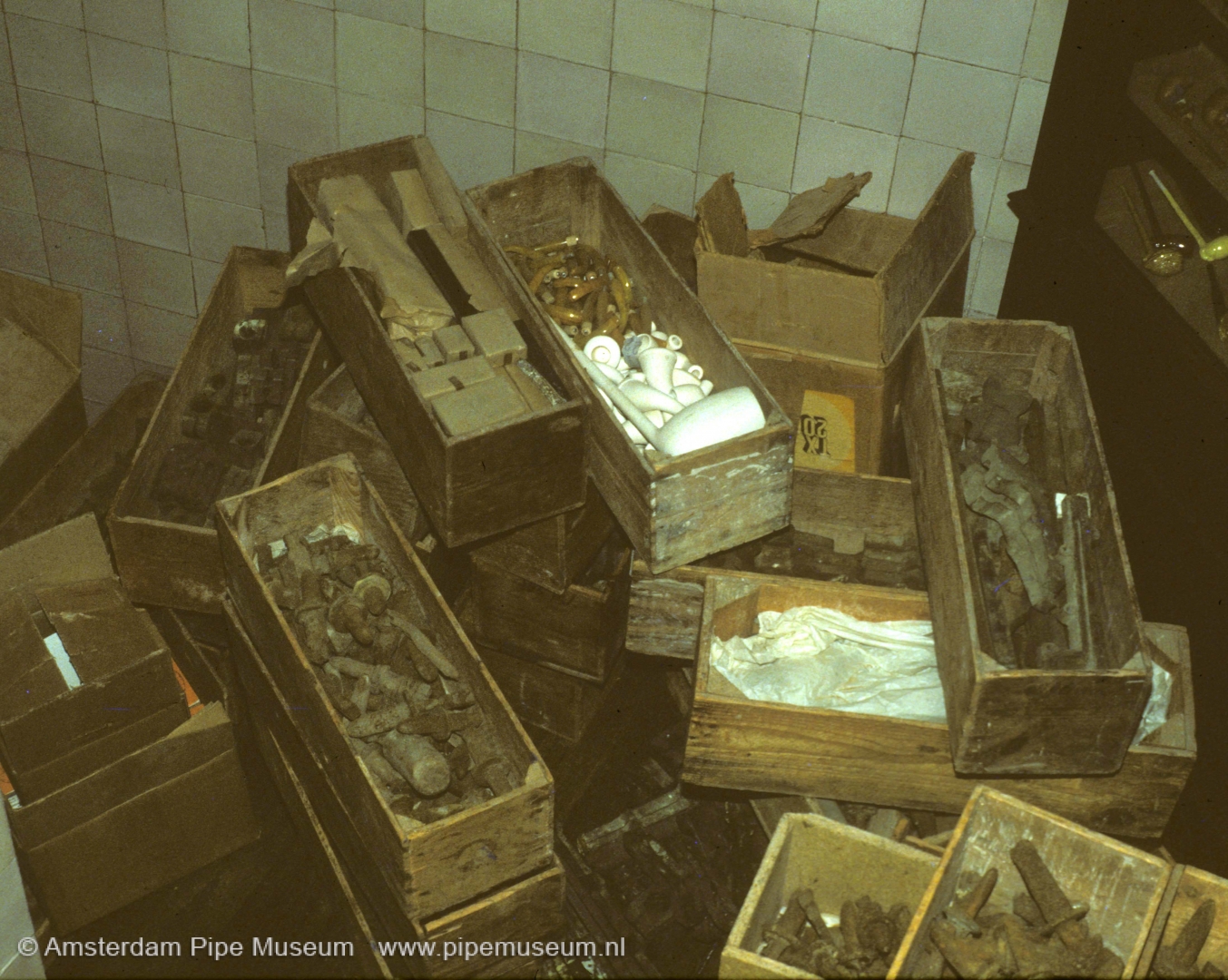
After several dealers and auction house Sotheby's had provided their expertise, it is up to us to make a fair offer on the historical inventory of the Koninklijke Goedewaagen factory. As serious candidates we have been negotiating this unique collection of tools. Today we are one step further, the material has been awarded to us and we are invited to sign the contract and make the deposit. This happened in the office of father and son Kamer, management and owner of what is now called Royal Goedewaagen. Speaking softly, the secretaries in the next room are not supposed to know about this transfer. Anyway, we quickly agree on the content of the contract, it is typed out, signed and we pay. Then comes the sorting of the material and packaging for transport. The first car with trailer is loaded at six o'clock, we are heading to Leiden heavy loaded.
_______________________________________________________________________________________________________________________________________________________
Diary excerpt 23: December 12, 1988
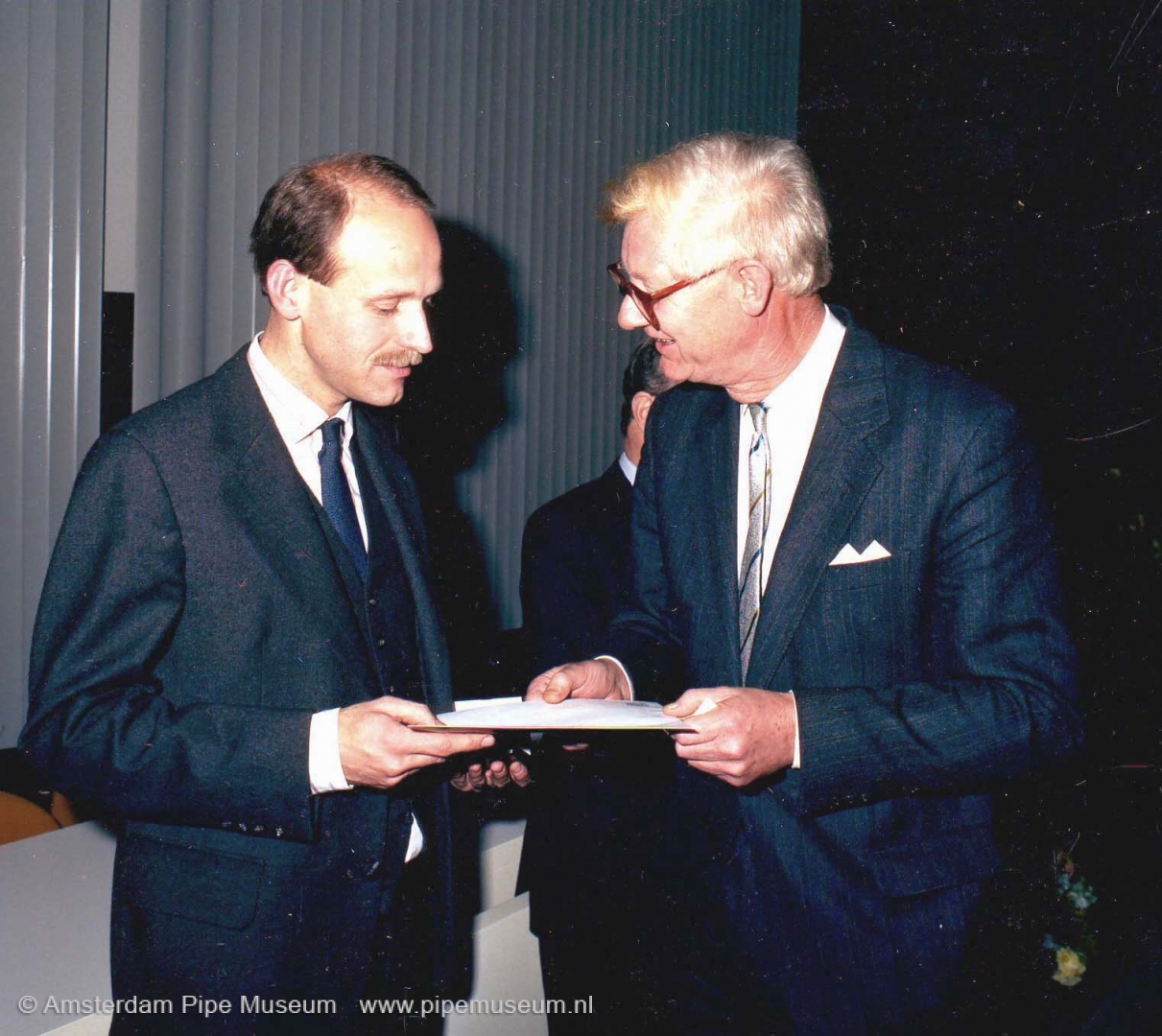
The granting of a scientific award had already been announced over the telephone a few weeks ago. Now it is the official day in the building of the Royal Dutch Academy of Sciences. Unfortunately not in the impressive palace on the Kloveniersburgwal, but in the 1970s new construction next to it. Upon arrival, the laureates, that is what you suddenly are, were taken separately for a photo session. There we are, five men neatly dressed in suits, the box with the coveted medal opened in front of the chest for a snapshot to be remembered. Then we’re led to the front row with reserved seats. Some speeches follow from the podium and then each of us is called forward to receive the laudation that goes with an award. And then the reception with the endless handshakes. Friends and acquaintances, even people who just want to congratulate. After this hustle and bustle, we settle down in a restaurant in the Utrecht Street, still a bit dizzy from the homage, Marianne and Jeroen, Benedict and me. The medal as proof of the event is safely stored in the inner pocket. We eat away time reflectively.
_______________________________________________________________________________________________________________________________________________________
Diary excerpt 24: March 15, 1990
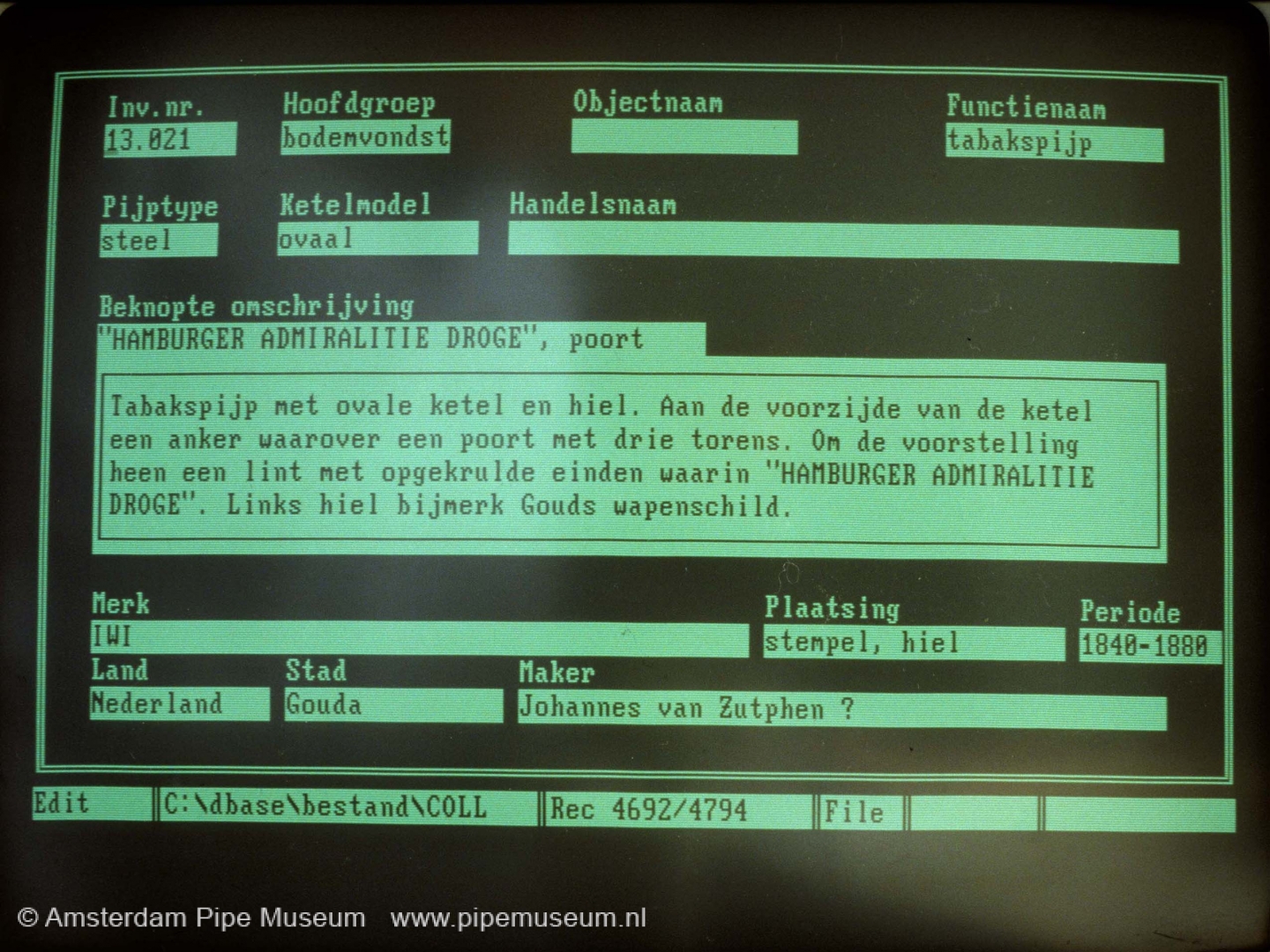
Thanks to the new computer, purchased for the preparation of the handbook three years ago, we have smoothly entered the digital era. The collection registration system based on D-Base IV will start true revolution in the registration of our collection. For twenty years, I wrote everything on paper, more than 25,000 file cards in a drawer cabinet, now that work will be done entirely on the computer. A tailor-made digital file card has been designed in which the main fields for the description of a museum object are predefined. And then it is just typing, a heathen job to transfer the data of more than ten thousand objects. And of course, while working you will discover that there are still great wishes. For example, it would be great to include an image in that card for quick recognition of the objects. Unfortunately, pictures in a computer system is not feasible because then the system becomes too slow. The future will provide a solution for this. For the time being, there is still task ahead to be done on this basic registration.
_______________________________________________________________________________________________________________________________________________________
Diary excerpt 25: June 13, 1992
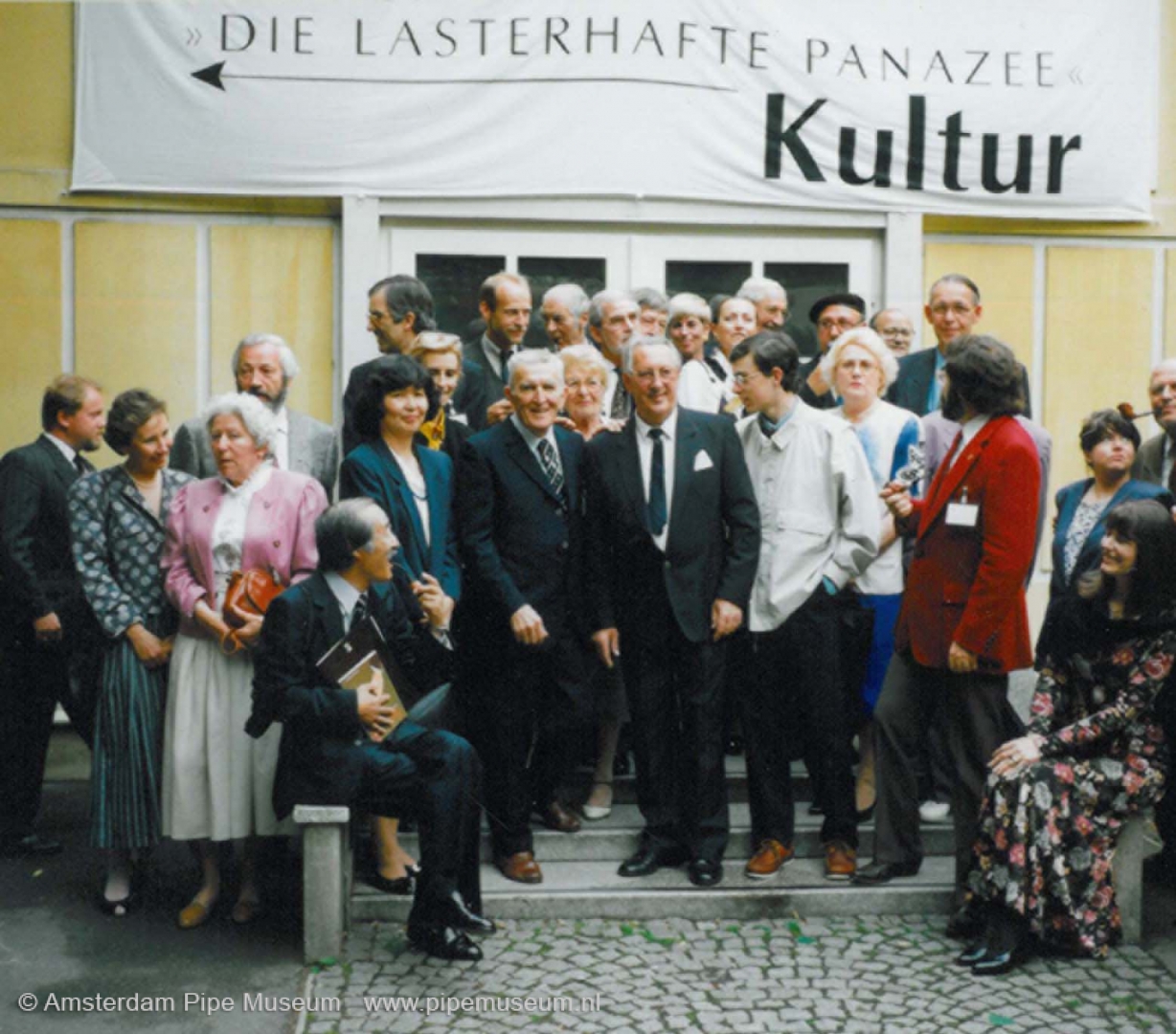
I arrived in Vienna a few days earlier, but the real program starts today with the preview of Die Lasterhafte Panazee, the exhibition on the occasion of the 500th anniversary of the discovery of America. For me this is also the official entry into the illustrious fellowship of the Académie Internationale de la Pipe. I couldn't become a member for a long time because only two members are allowed per country, that's how exclusive the circle presents itself. As a matter of fact, the members are no strangers to me, I already gave a lecture at their conference in 1987. The first activity now disappoints me a bit. A lot of work has really gone into the temporary exhibition and it relies heavily on the merits of various members of the Académie. Yet the tour turns out to be very old-boys' school: no admiration for the objects but instead praise for the contributors, with the anecdotes and tall stories demanding the most attention. At the dining table, an important part of the daily routine at the Académie and undisputedly high quality, Benjamin Rapaport interrogates me about what I expect as the youngest member of the Académie. Do I understand well that the circle's identity is still up for debate?
_______________________________________________________________________________________________________________________________________________________
Diary excerpt 26: July 10, 1992
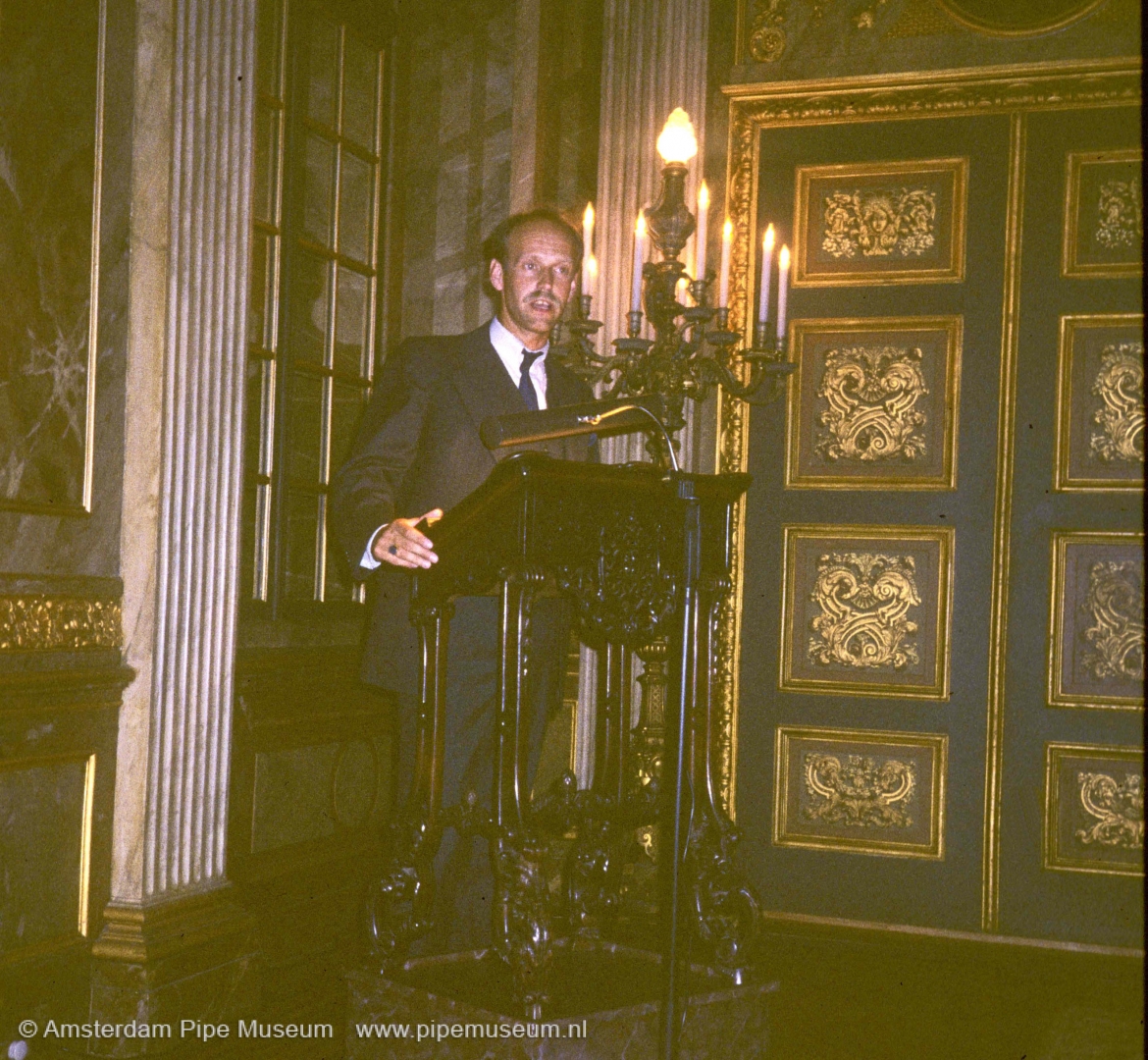
It took a week to mount the ‘Orange pipes’, commemorating the Princely family of Orange, on Nassau blue silk and to prepare panel by panel to furnish a full length of the wing in Palace Het Loo. Lack of time because every working afternoon was interrupted by the head curator for a long luncheon fit for a king in the nearby restaurant De Keizerskroon. It seems as if the entire staff of Het Loo has royal allure. Anyway, the work was completed on time. The opening of the exhibition I smoke Orange will take place in the lecture hall along the front courtyard of the palace. Director Vliegenthart introduced me, perhaps not with the most complimentary words, but I was allowed to make up for that in a short speech. Then we went to the presentation to look with fresh eyes to what we had made the days before. Friends, acquaintances, including our entire year club, they were practically all there, lured from far and wide by the dignified invitation on handmade paper. Anyway, I see that it is all neatly arranged, the story of the Orange pipe has taken shape and we made it known, even in royal circles. We even managed to get Prince Bernhard for the preface in the catalogue, although we have to do without him at the opening of the exhibition.
_______________________________________________________________________________________________________________________________________________________
Diary excerpt 27: November 19, 1992
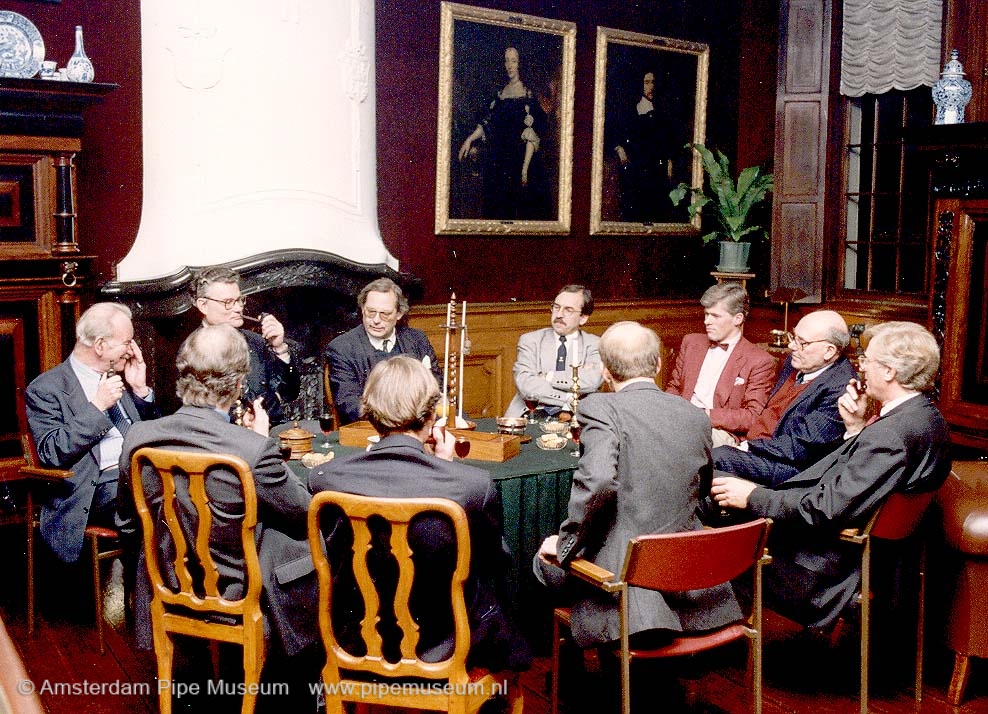
Pieter Kerdel has gathered some of his pipe-smoking friends to have a smoking evening in our museum. Not an ordinary gathering, but something with class and elegancy to result in a support group for the museum that can help make the future more secure and the foundation more solid. And indeed, it will be a special gathering. Influential people from business, banking, politics, they all share one thing: they are pipe smokers and they immediately feel connected through the pipe. The ice breaks upon entering, not only through the glasses, the warm bond with the smoking culture does the rest. Kerdel is an eminent chairman and during the evening sketches the plans for the museum, with room for opinions and thoughts, in a most inspiring way. And furthermore, the enchanting Regents room with its beautiful colours and orderly furnishings is the best atmosphere to get people enthusiastic about the culture of pipe smoking, especially when the catering is top-notch and exclusive drinks flow. This will make it a memorable evening. We are very curious about the direction of this steering group and what this can mean for our museum.
_______________________________________________________________________________________________________________________________________________________
Diary excerpt 28: May 3, 1993
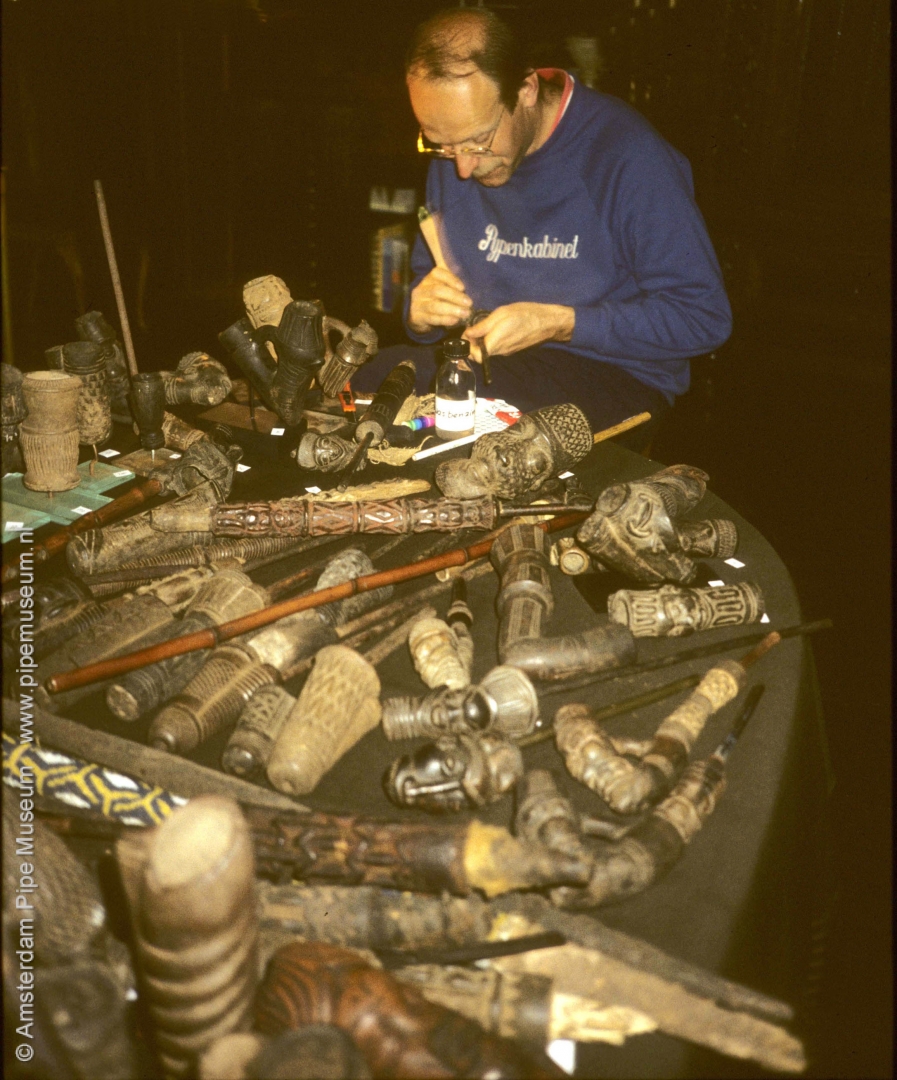
After Gerbrand Luttik collected African pipes for decades, the material unexpectedly ended up with the Rotterdam gallery owners Cathy van de Pas and Steven de Raat. They organized an exhibition of it and we bought a series of attractive and representative pieces. After this successful exhibition, we were invited to make an offer for the surplus. This did not only consist of the left overs of the exhibition, but also included a group of pipes that have not been on display. Luttik's collection had simply been too large to exhibit them all. Well, encyclopaedically as we think, upon arrival at Watergeus Street we find a wide variety of antique African tobacco pipes and as usual we cannot refuse. The material passes to us in its completeness. This gives us the opportunity to select quietly and to investigate what is and what is not important to include in the collection. In any case, this seems like a special broadening of our African collection, which proves normally difficult to expand.
_______________________________________________________________________________________________________________________________________________________
Diary excerpt 29: November 4, 1993
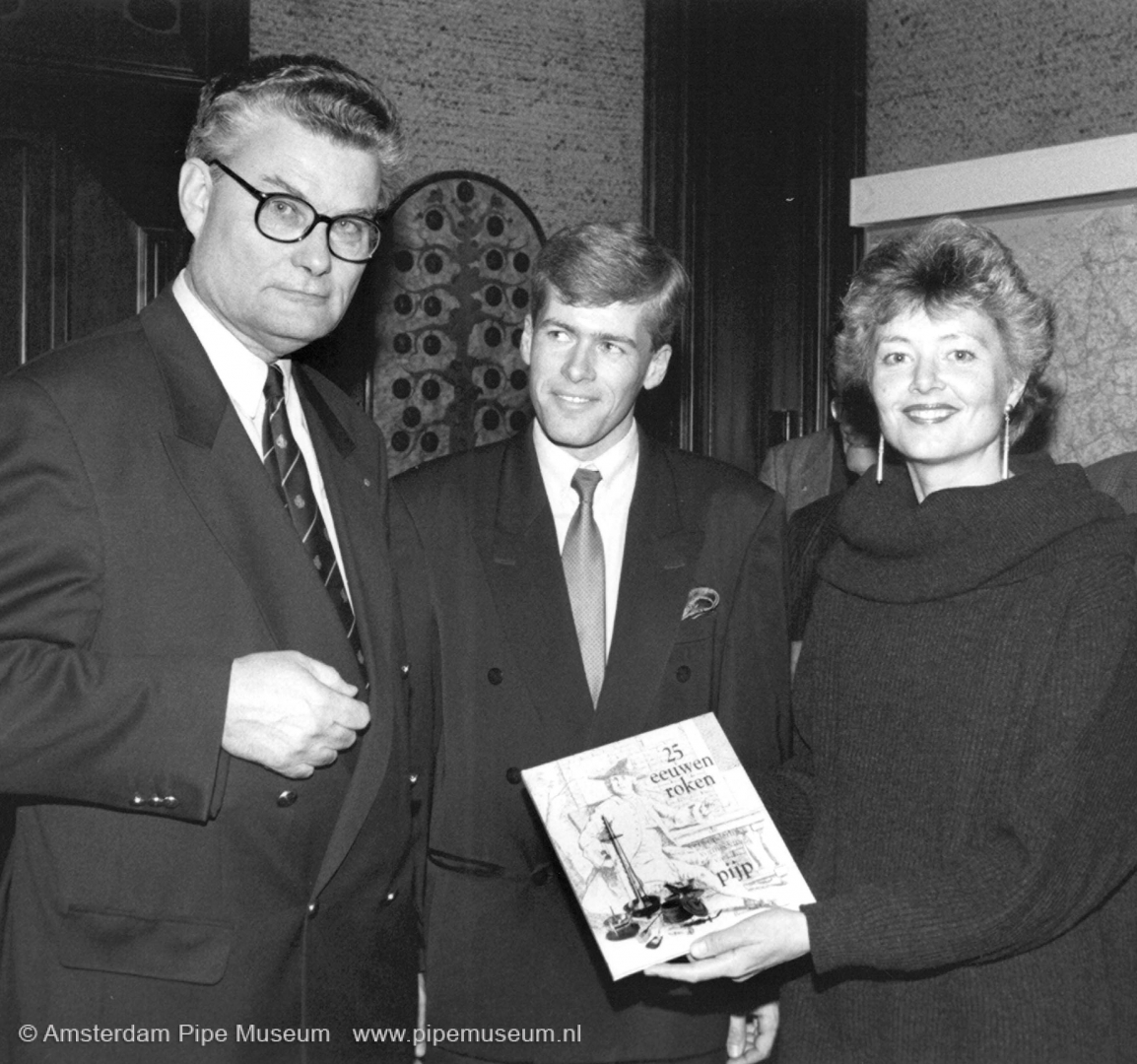
In order to make our collection known to wider circles, we have planned to make a photo book that includes the variation of the tobacco pipe. Arno Hammacher was looking forward to the job, but had no time for the time being. Benedict has therefore set to work himself, both with writing and with photographic work, you can say energetically. Publisher Uniepers provided the final design and today is the presentation of the first copy. This will be presented at Leiden City Hall by alderman for culture Henny Koek to art connoisseur and pipe smoker Theo Laurentius. It was a pleasant meeting with many acquaintances and sympathizers. What an honour, Aart Goedewaagen had even come and also Dirk van der Want, two dear relations from the very beginning! But countless friends and acquaintances also gave an acte de presence. Our big secret of that meeting: nobody knew that we would be announcing our exodus from Leiden this year! New plans are just around the corner, which cannot really be reconciled with this book edition, because The Intriguing Design of Tobacco Pipes was clearly a Leiden publication.
_______________________________________________________________________________________________________________________________________________________
Diary excerpt 30: March 28, 1994
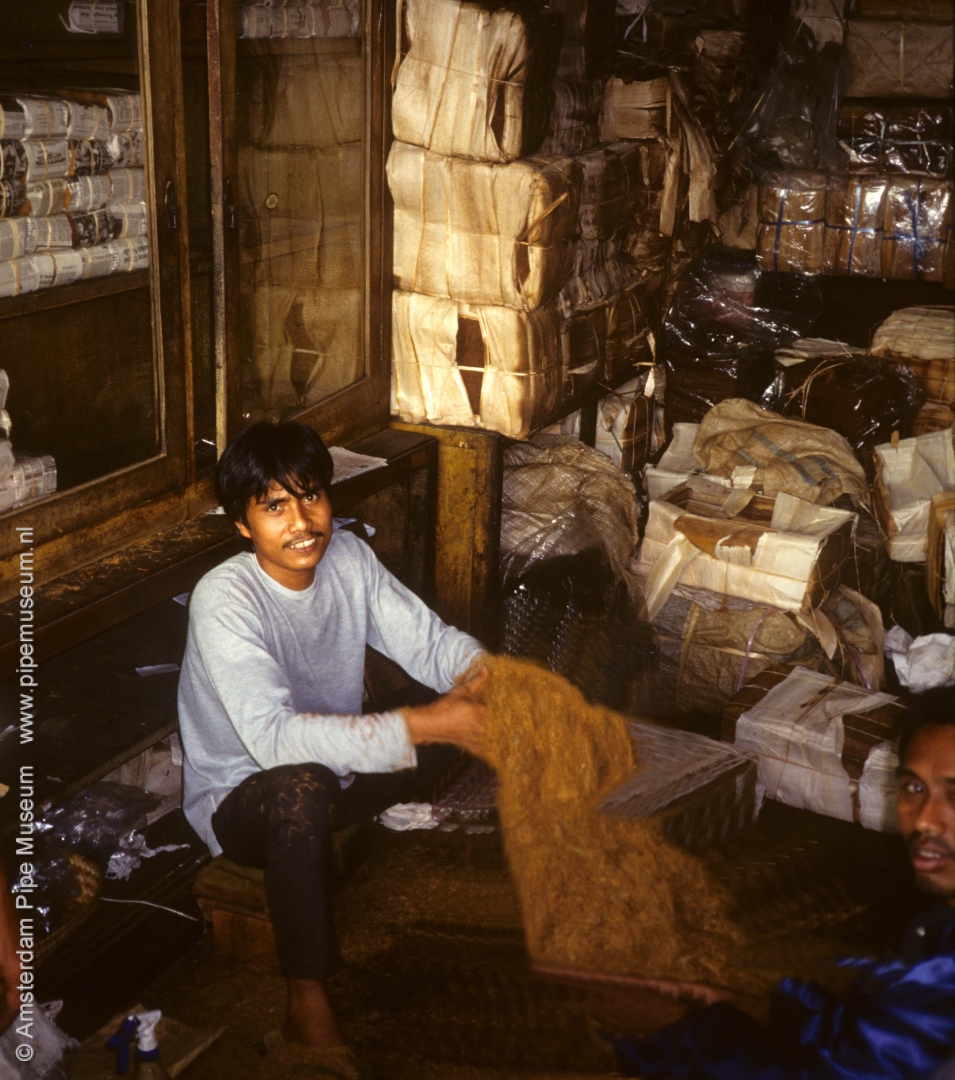
Just found a special shop on Jalan Kebon Sirih Timur Dalam in Surabaya with an inventory of Indonesian antiques, arts and crafts from the islands in the Archipelago up to New Guinea and also archaeological objects from a wider area. They lie there in a display cabinet, waiting for our discovery: five beautiful stone-carved pipe bowls from the prehistoric times of smoking, only God knows the exact date. Beautiful primary shapes and in good condition. In such a case, just look away and focus on something else to make contact first and then start a conversation. Too bad, little English language at the seller and we don't speak Bahasa. Then it was decided to start the conversation on the pipes from the trading stock, of course priceless by Indonesian standards, that's why they were still there. We are lucky that we count in guilders, so we put a whole group of objects together. Wheeling and dealing as a pastime and eventually we get there. Now I have to figure out what I actually bought and whether the verbal information grave field Laos has any grounds for truth. In any case, extraordinarily special, which is instinctively what I am sure of.
_______________________________________________________________________________________________________________________________________________________
Diary excerpt 31: June 23, 1994
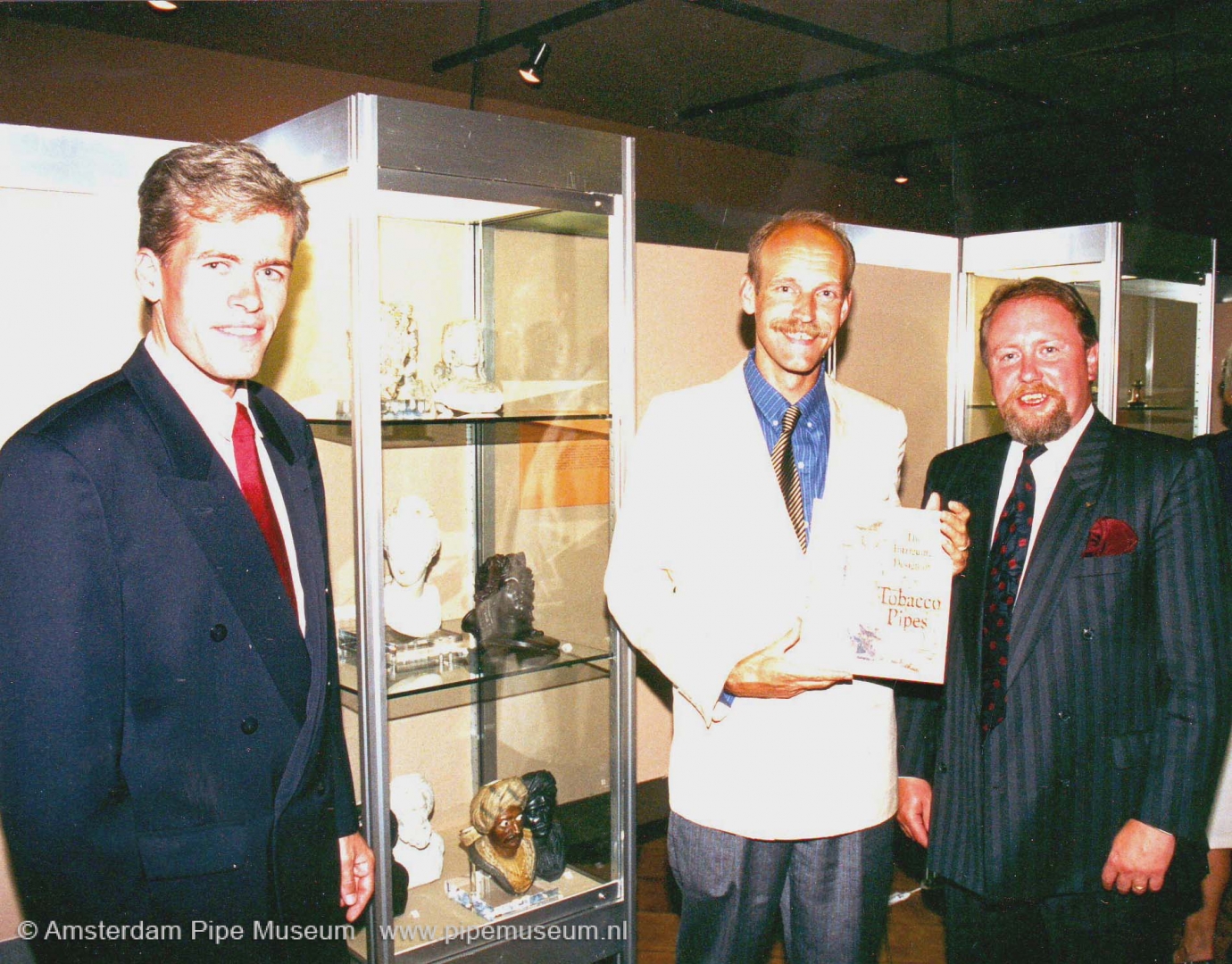
The layout of the exhibition in the Österreichisches Tobacco Museum in the Mariahilferstrasse in Vienna is finished. Today is the opening. Two highlights, the presentation of Benedict's book to director Herbert Rupp and my speech about assembling our collection. Well, that all goes smoothly, even in German. Most impressive is the Dutch dinner that is offered to all invited, the largest ever experienced with over a hundred guests! Fresh herring is in great demand, prepared with beetroot and onion. What the tobacco industry, read the Austrian Tobacco Monopoly, is fit for. And as for the exhibition, it looks beautiful. Over the years, our collection has become more international and that works well on the visitors. The topic is taken more seriously now because it turns out to be a matter of global interest. The idea of marking the continents and periods with colour bands on the floor works well. You are almost forced through the room. In this way presented we get a completely new look at museum objects we are so familiar with.
_______________________________________________________________________________________________________________________________________________________
Diary excerpt 32: October 29, 1994
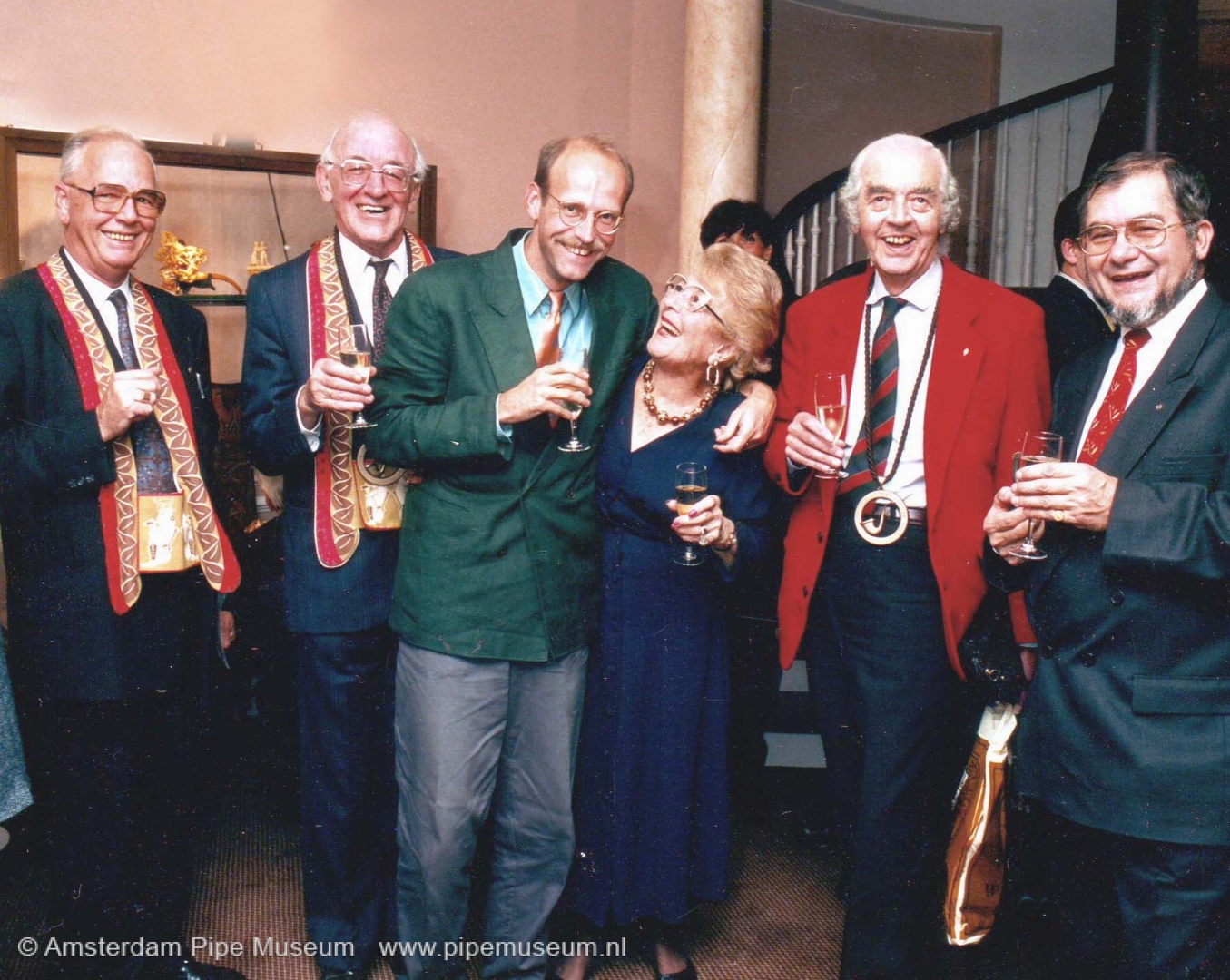
The last day of the meeting of the Académie Internationale de la Pipe always ends with the gala evening. Talking about all kinds of plans for almost three days can arise some bitterness in me. It makes me feel like, shall we stop making plans for a while and just get to work? Anyway, at such an evening you forget about all those conversations or you drown them with drinks and small talk. In any case, the Luxembourg restaurant with the illustrious name Chateau de Bourglinster is excellent and everyone looks their best. It is amusing to see that the wives of (former) factory directors and ambassadors bring a suitcase full of evening dresses and jewellery even when traveling. Beautiful all that sparkle, a pity of course that the ladies are often over 70 so that the beauty has lost some shine. In any case, the conversations this evening are a lot more personal. Tomorrow I will continue my research and writing at home certainly with more energy than normal.
_______________________________________________________________________________________________________________________________________________________
Diary excerpt 33: September 24, 1995
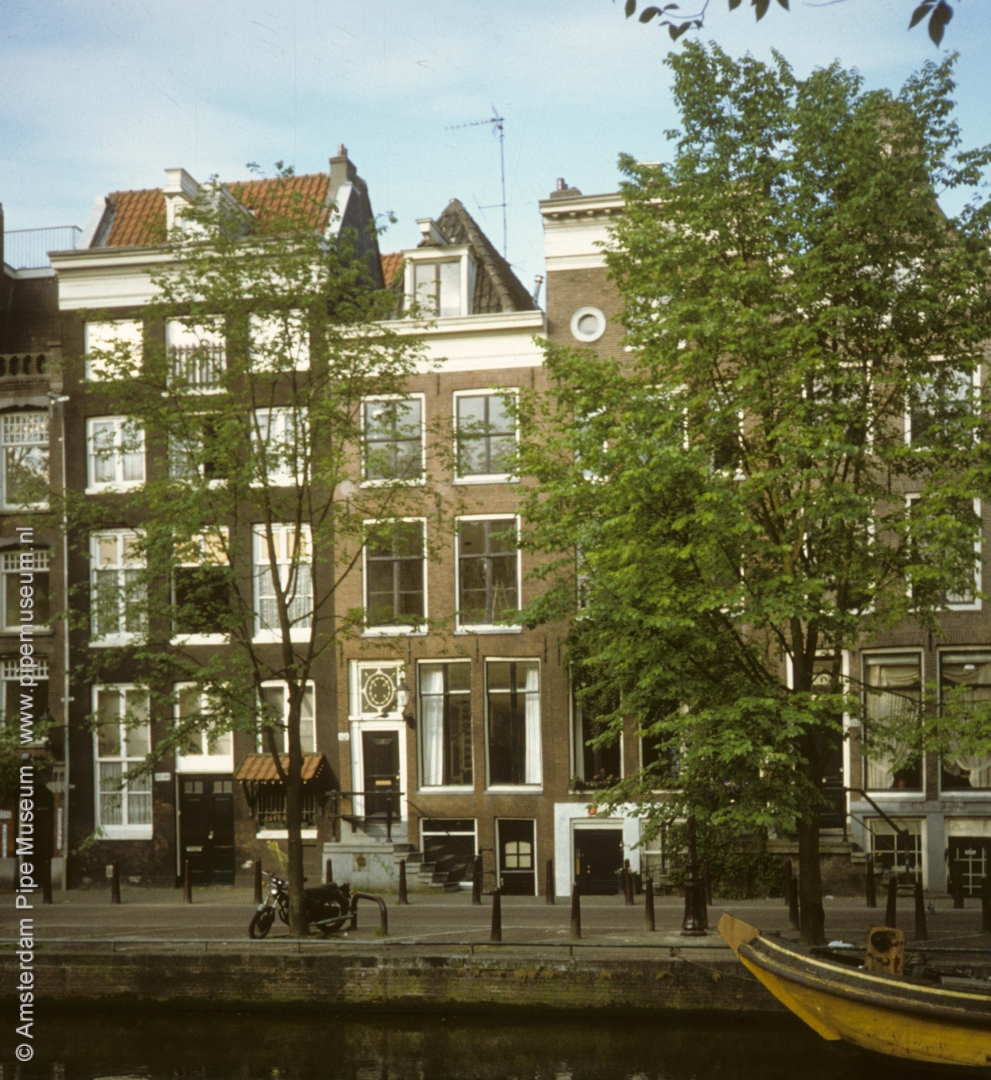
Countless friends called us crazy: to exchange Hof Meermansburg for Amsterdam. Changing the stately, palatial look of a fully furnished museum in Leiden for an Amsterdam canal house that still requires loads of work. Anyway, we are happy to take on that challenge. As an invitation for the house warming we have compiled a special newspaper as a farewell to Leiden and as an introduction to Amsterdam. A sectional drawing of the premises with all floors has sparked interest. It was exceptionally festive today at the open day at the Prinsengracht 488 here in Amsterdam. With almost a hundred people in the house, spread over five floors where nothing can be destroyed at this point. The photo exhibition in one of the former bedrooms is a great success. It is an overview of our life over the past twenty years, with as the main conclusion not that we are growing older, but that we are getting better dressed. Especially the high tea and drink is well attended. The Leiden horde is over-represented; in the end, every resident of Leiden secretly dreams of moving to Amsterdam. They mix cautiously with the Amsterdam minority. Will our guests of today know what we are up to and ... will we succeed in our goals?
_______________________________________________________________________________________________________________________________________________________
Diary excerpt 34: November 26, 1995
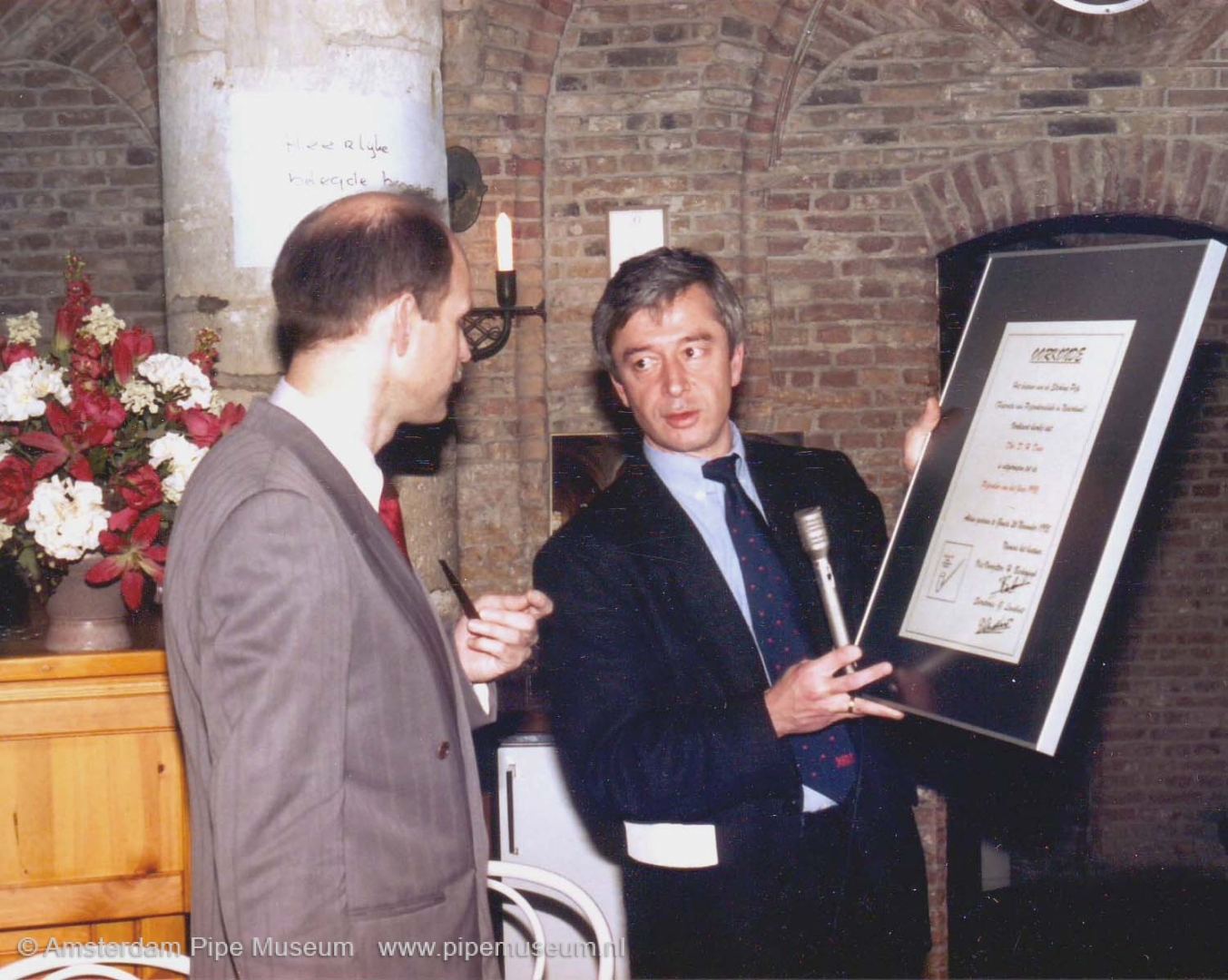
Today is the Dutch Pipe Smoking Championship, held in Gouda this year. From the morning it is a walk-in of clubs from remote Dutch and Belgian towns. Some people with decorated waistcoats, hats or other club outfits. Our own Leiden club Philip Mortimer takes part in this in an appropriate way, recognizable by an orange bow tie with a green jacket. Everyone meets at the prize table as the focal point in the catacombs of the Gouda town hall. Displayed are the articles that you can win as a good smoker. Actually, such a smoking contest is like a kind of bingo, you can try to keep the fire, but in the end it is a matter of luck. Alderman Jaap Warners opens the meeting and announces the Pipe Smoker of the Year. I am selected this year, as curator of the most active pipe museum in the Netherlands. We hope that this honorary title will have a positive publicity effect at our new location in Amsterdam. The certificate for this honourable mention will soon be taken home. Shall we put it up in the shop?
_______________________________________________________________________________________________________________________________________________________
Diary excerpt 35: January 20, 1996
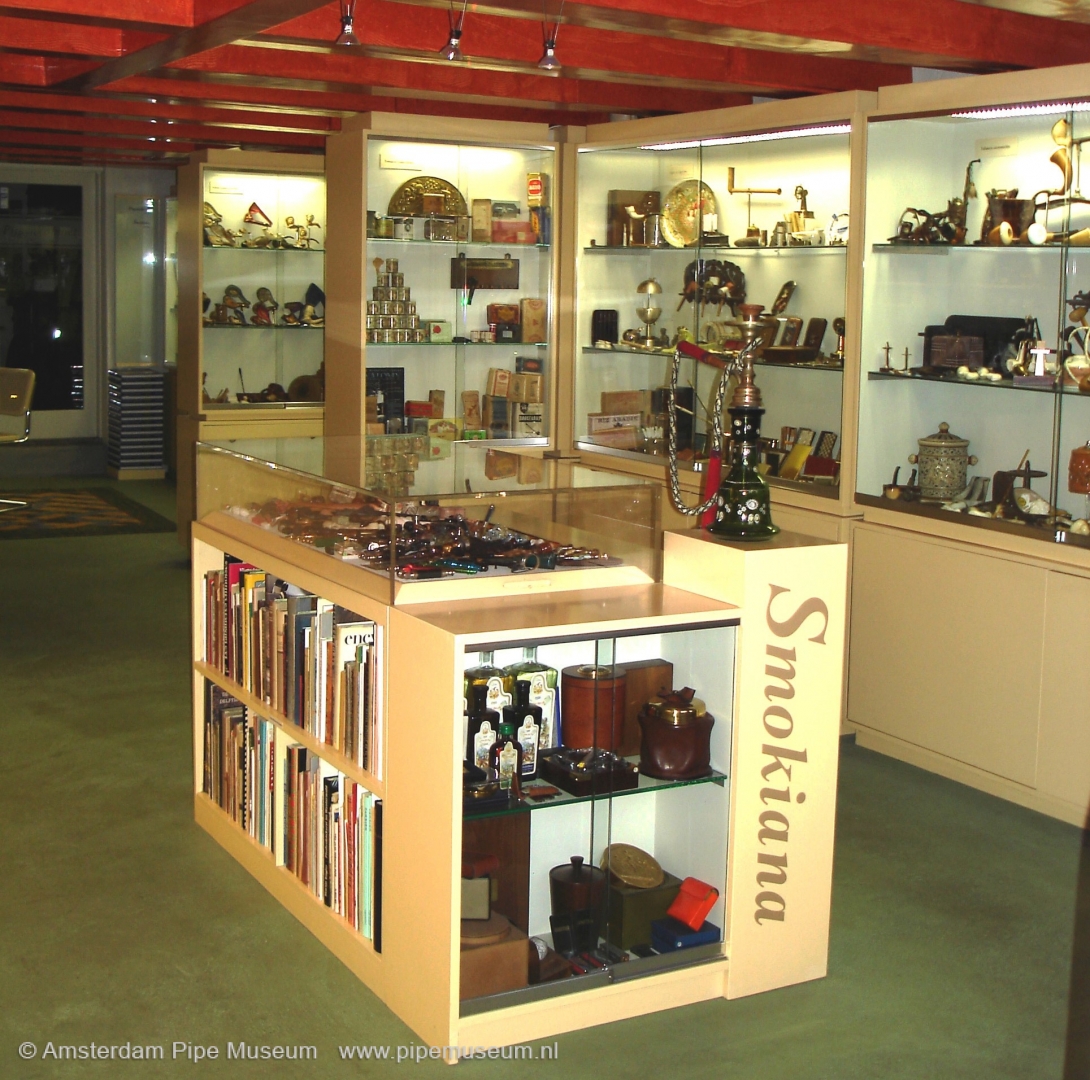
A new year has begun with new opportunities. Phase one of the relocation and renovation of Prinsengracht 488 has been completed. Today we celebrate the opening of Smokiana Pipeshop, the new name of a new store under the Pijpenkabinet museum. The latter is not yet open, a ruinous building cannot be renovated in a few months. Anyhow, in this first part of our business we can relax, chart a new course and recover financially for the next investments. It looks nice, the colours from Leiden also work well in an Amsterdam basement: egg yolk under a Mediterranean orange-mixed ceiling. Even without a museum we got a museum shop, for modern pipes, but also for antiques and tribal stuff. And then the location: perfect in the so-called Leiden quarter near the Spiegelkwartier, the antiques centre. The slogan Pijpenkabinet princely in the Leiden neighbourhood applies to us. The first contacts are made with the neighbours, with the antiques trade, with colleagues and general interested parties. Wondering what the future will bring! Some neighbours across the street already speak of money laundering and believe that we will be gone in two months. Anyway, we can open up again tomorrow, Sunday. We are excited!
_______________________________________________________________________________________________________________________________________________________
Diary excerpt 36: September 24, 1996
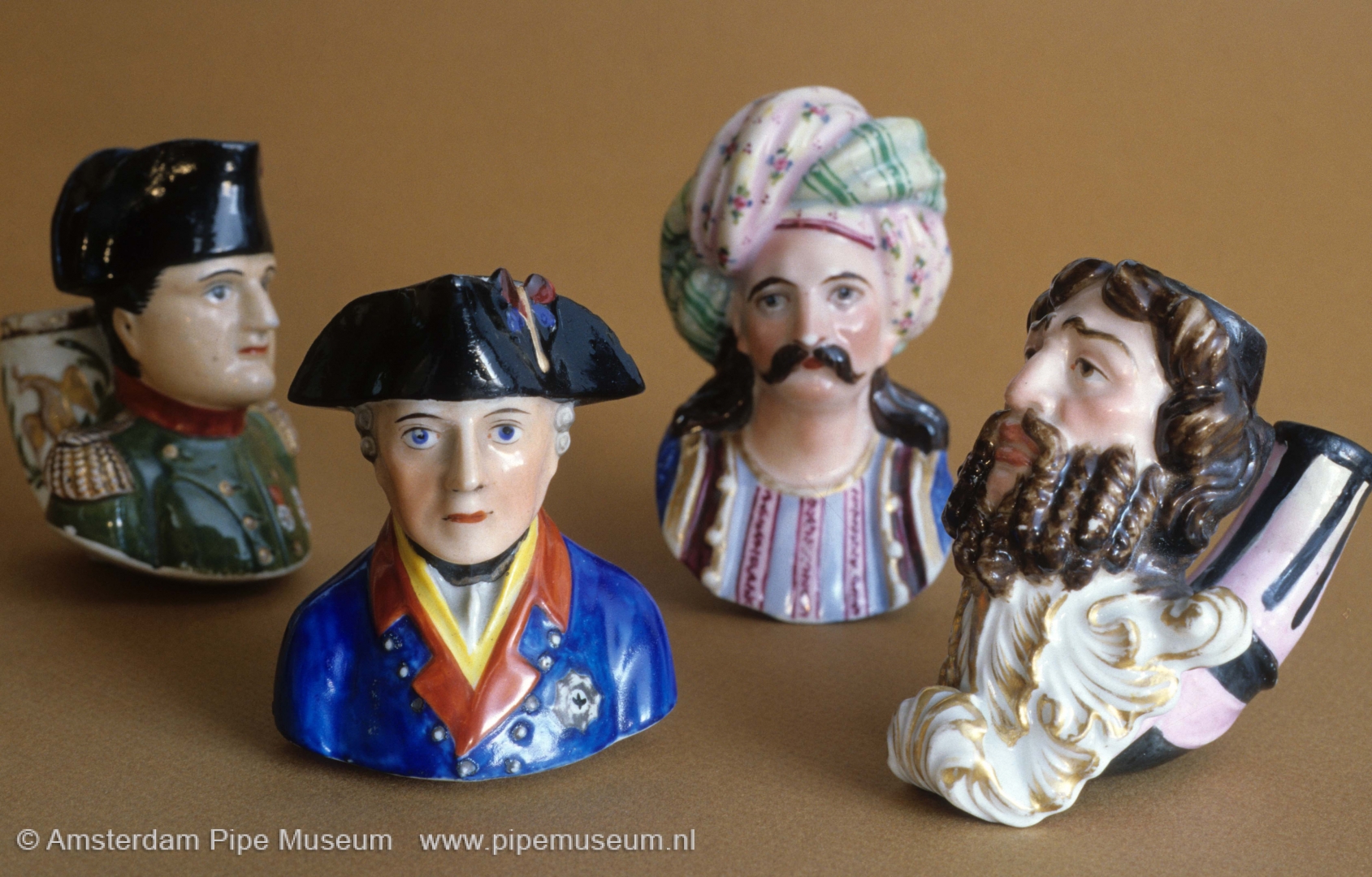
It is a day to fetch things at Lazard in the heart of Paris. The payment for the takeover of his collection has been transferred, now it was time to pick up and go. The moment Bertrand Lazard knows that the sale is definitely going through, he takes the much-discussed 68 pipes to a safe, neatly packed for fear of being burgled at the last minute; he and his wife were back in Israel for some time. Now they come out of the box, one by one, and we write down the provenance that Lazard kept in his booklet. And what a surprise that the beautiful Ehder pipe still has its original case! At three o'clock we say goodbye, Bertrand visibly satisfied with the handover and the right destination. Bizarre next program item: we will continue to Hubert Auffève to view his collection in Brittany. Arrived at his house we were fully unexpectedly questioned about the pipe collection of Lazard that he so longed for, but that Bertrand definitely begrudged him. Hubert knows that the collection has been sold, but is unaware of the actual buyer. Exciting for us, because at that very moment the collection was in the trunk of our car in his own driveway. When will he find out?
_______________________________________________________________________________________________________________________________________________________
Diary excerpt 37: October 3, 1998
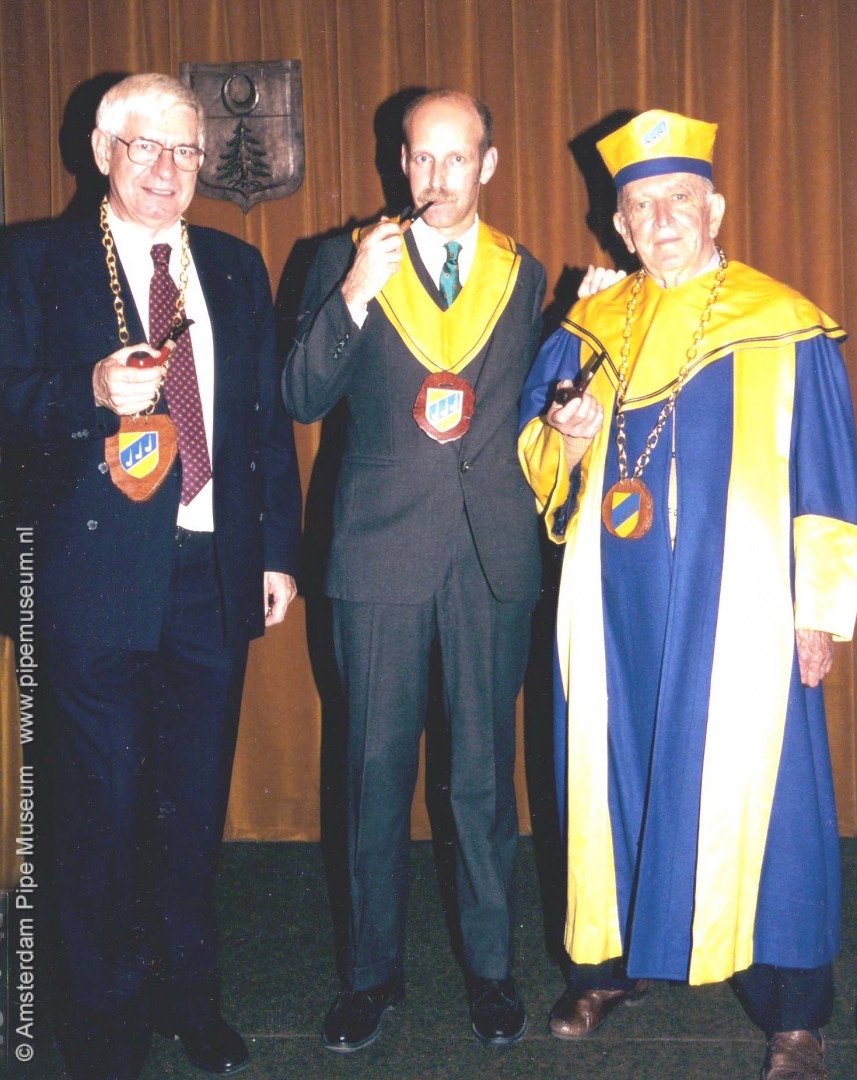
The Confrérie des Maitres Pipers is a distinguished society of men and a single woman who occasionally wear long cloaks in the colours of the city coat of arms of Saint-Claude. They are the ones who represent the pipe industry in the French Jura and annually incorporate various professional brothers from the world of the pipe into the Brotherhood. Several Dutchmen have already received that honour, Prince Bernhard was the first in line. Today it is my turn to illustrate others. It is doomsday, in which you have to show publicly that you are a real pipe smoker. There can of course be quite some discussion about that. Anyway, standing in front of the altar of smoking you have to practically show that you can stop a pipe, light it and smoke it. What a miracle, I also succeeded in this dark, cave-like temple of the institute. As a reward you will receive a ribbon and you can call yourself Confrère from now on. What an honour. Afterwards, you get to sign the big book and your favourite pipe will be on permanent display in the local museum. For eternity.
_______________________________________________________________________________________________________________________________________________________
Diary excerpt 38: October 3, 1999
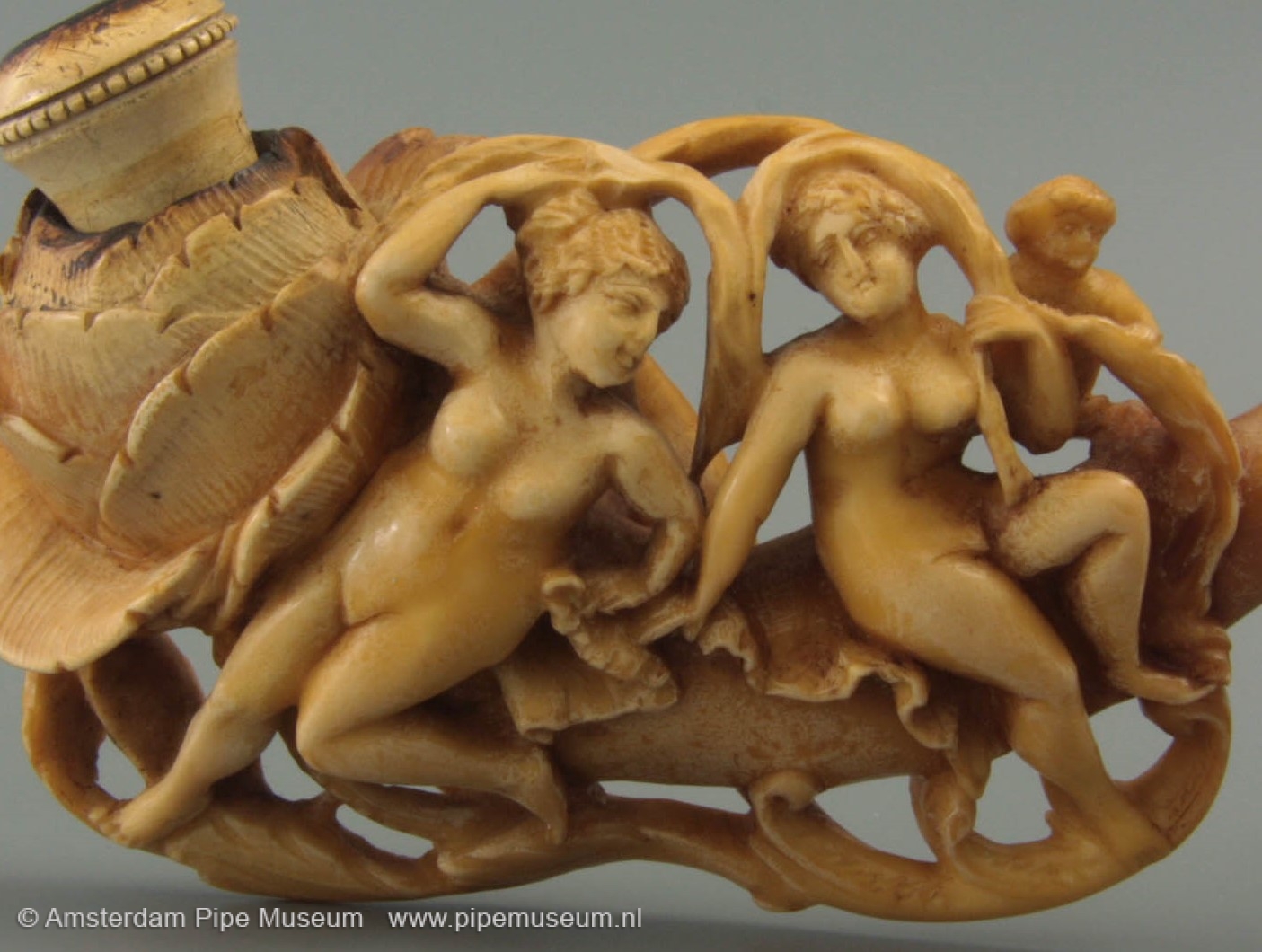
At a lecture in Gorinchem we had met Hugo Perquy, a well-to-do plastics manufacturer from the chic Belgian Hertsberge. Today we are invited to his spacious house consisting of an antique farm surrounded by stables with horses and luxury cars in the courtyard. Perquy is a gentleman and receives us as such. He shows the way and gives a tour through his pipe collection, a passion that has given him great pleasure for years. He has now exchanged this hobby for collecting cameras and the pipes are for sale. Today we are there to choose; always a special moment. His preference lay with meerschaum, but as an omnivore he collected pipes from all parts of the world. We can select and choose especially the more representative pieces, many of which will be placed in the new showcases in Amsterdam. Perquy shares our enthusiasm. We quickly agree on the price, he sees that his objects end up well! Generous as he is, he gives a large box with restoration material on departure. It would serve us even more now.
Diary excerpt 39: June 20, 2000
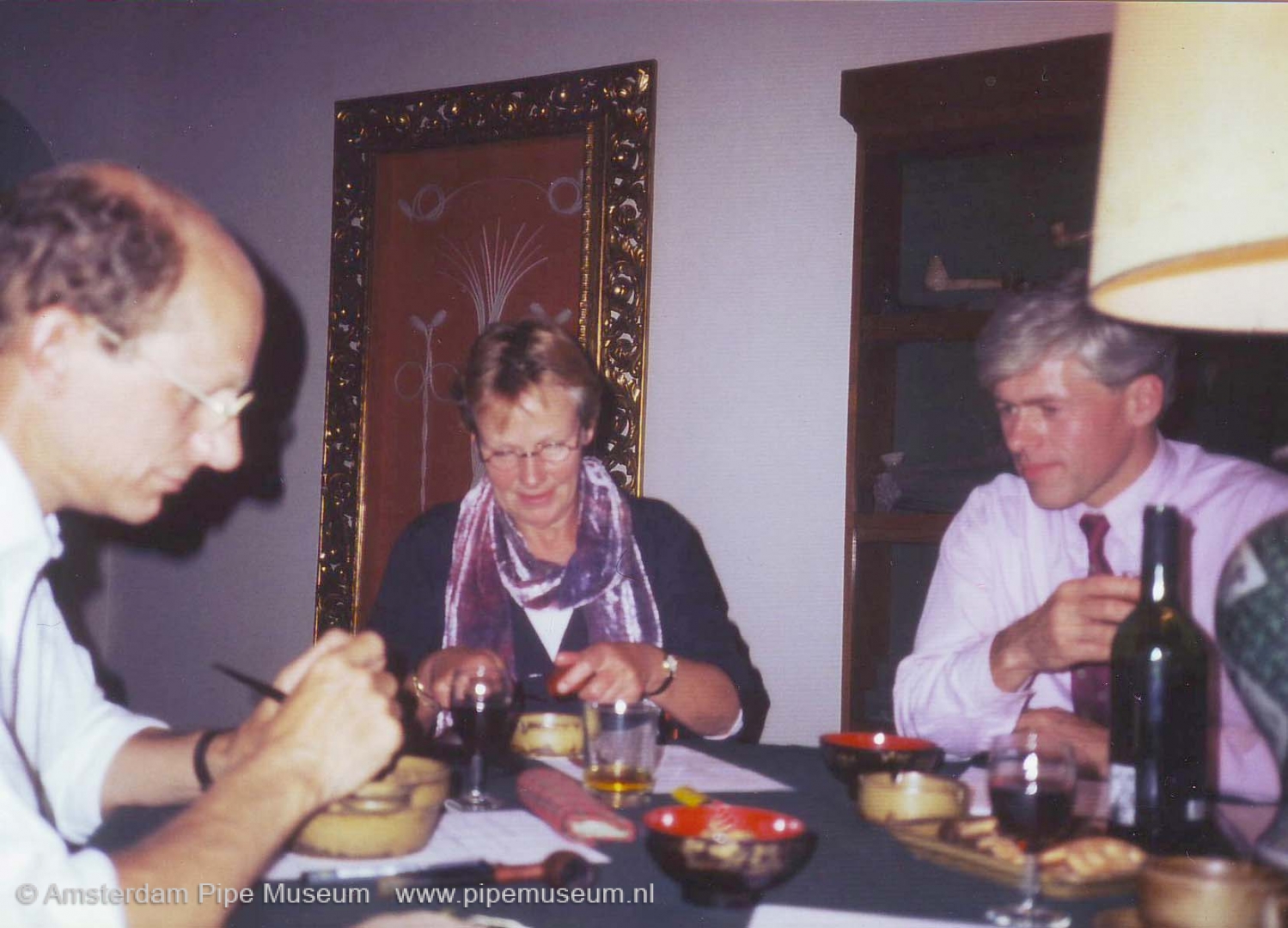
It seems to be a special evening, tonight when we sit around the table with Anneroos Meijboom and Bert van den Berg in our museum rooms shaping plans for a new smoking club. We quickly agree on a profile of such a club. Absolutely no time smoking contests, but purely to enjoy and share knowledge and experiences. About ten evenings a year, here in the museum or at another location. A group of people in between a club and a circle of friends, so entry is exclusively on invitation, with the emphasis on conviviality. Sharing our common hobby with active participation of the members with professional talks or an introduction to a theme of mutual interest. Enjoying pipe smoking, alternating with life matters. Now still recruiting members, who knows candidates and what will be the name? At the end of the evening, we unanimously decide for Amsterdams Pijprokers Genootschap. We are already looking forward to the next meeting!
_______________________________________________________________________________________________________________________________________________________
Diary excerpt 40: October 21, 2000
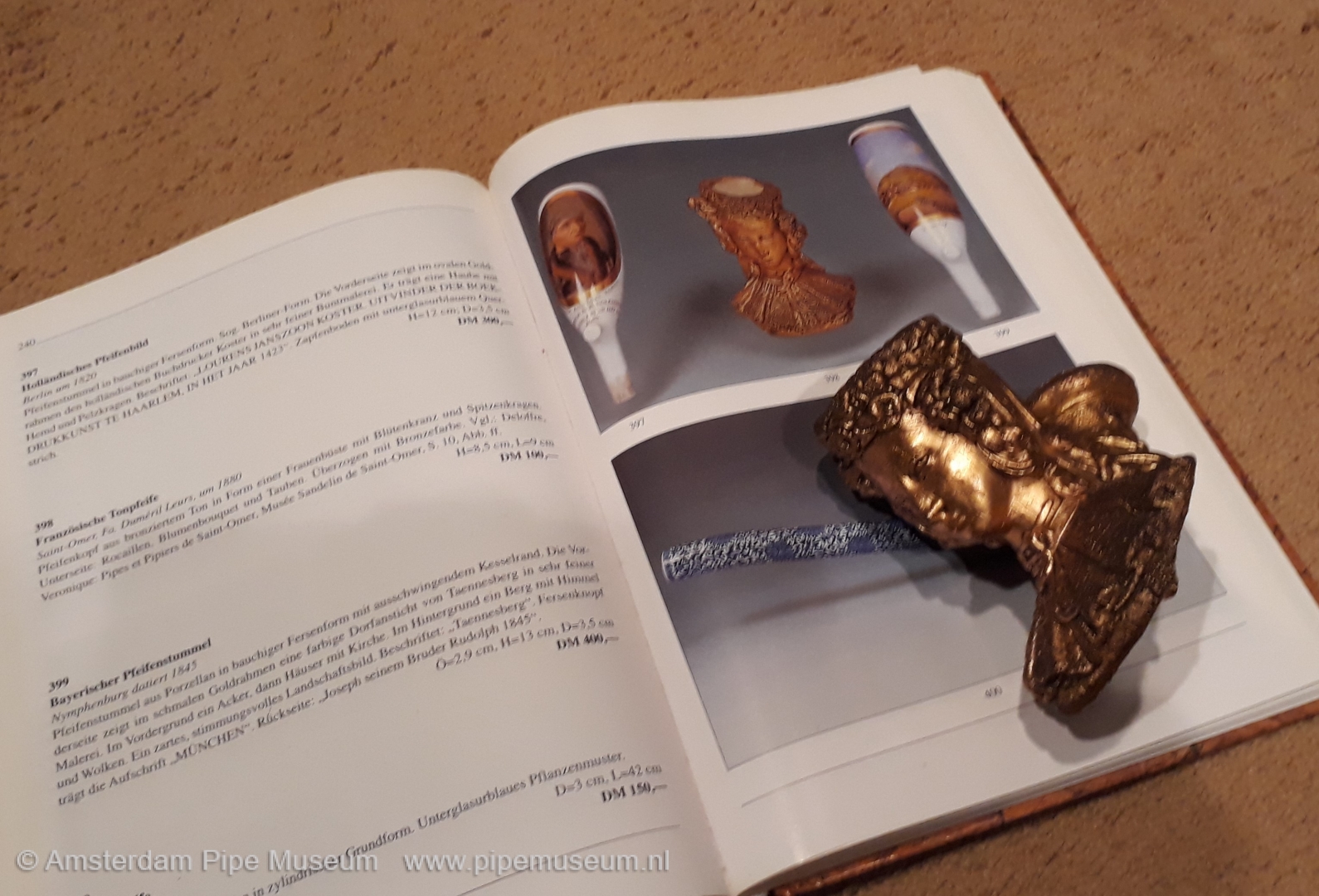
The couple Hermine and Louis Haegeli ran a pipe and tobacco shop in Basel for decades. In that small tobacconist's shop, in addition to modern merchandise, antique pipes were also on display, said to have belonged to the inventory for three generations. But as so often, there was no follow-up in the shop and the family decided to put the collection up for sale. That auction took place today in Heidelberg at Metz Kunstauktionen. The beautifully illustrated catalogue was described by Walter Morgenroth and will become a cherished reminder of this miscellaneous collection. In a marathon session, almost six hundred lot numbers of various kinds passed. High quality and low standard were auctioned one after the other, sometimes for take-away prices, but real money had to be paid for the good pieces. Characteristic in the Haegeli collection was the beautiful selection of antique porcelain pipes, which was also our focus. Ultimately, we ended up with just under fifty pieces representative of the identity of the Haegeli collection. That part will get a new life in Amsterdam.
_______________________________________________________________________________________________________________________________________________________
Diary excerpt 41: November 2001
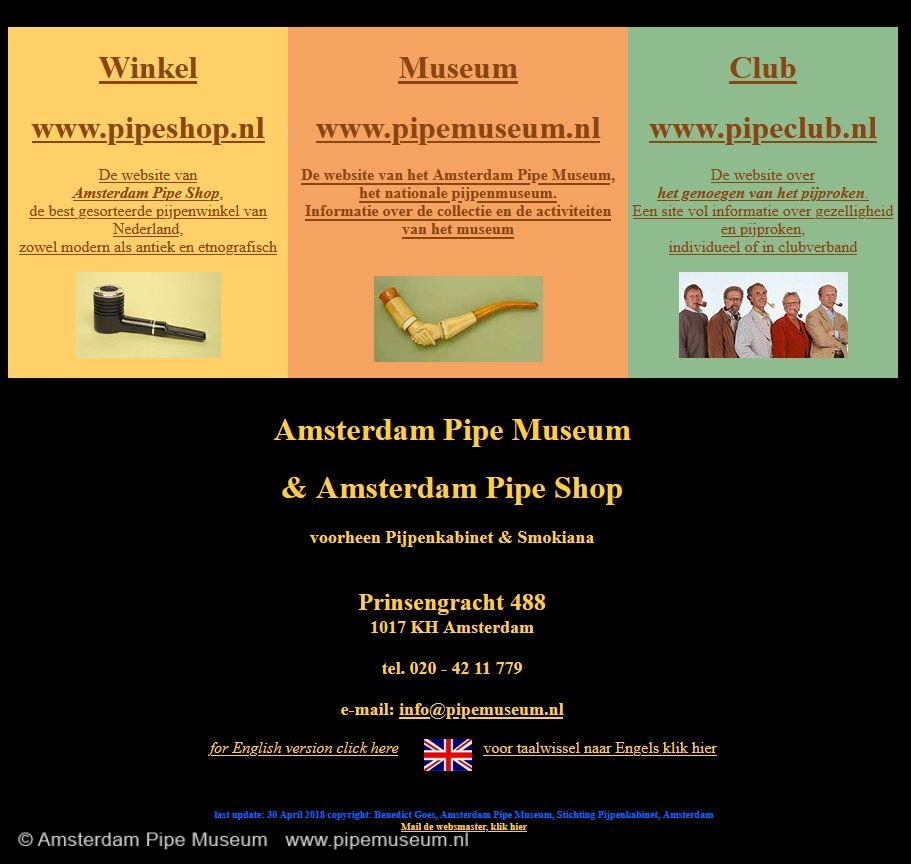
After we started with a simple web page as a digital leaflet a few years ago, today a more serious version as a real website is launched. The site is made up of three sections, in which the museum collection is central. In addition, a separate section has also been set up for the more commercial Smokiana Pipeshop and the Pipe clubs. In this way we hope to generate interest from one area to another through cross-pollination. We will see if it will work. It is amazing to notice how quickly the medium of website has developed and is now a respected source for presenting information. As a museum you cannot lag behind and we didn’t. Via statistics it is even possible to find out how large the number of visitors is and how much time they spend on the website. Nothing seems impossible with this medium.
_______________________________________________________________________________________________________________________________________________________
Diary excerpt 42: March 25, 2003
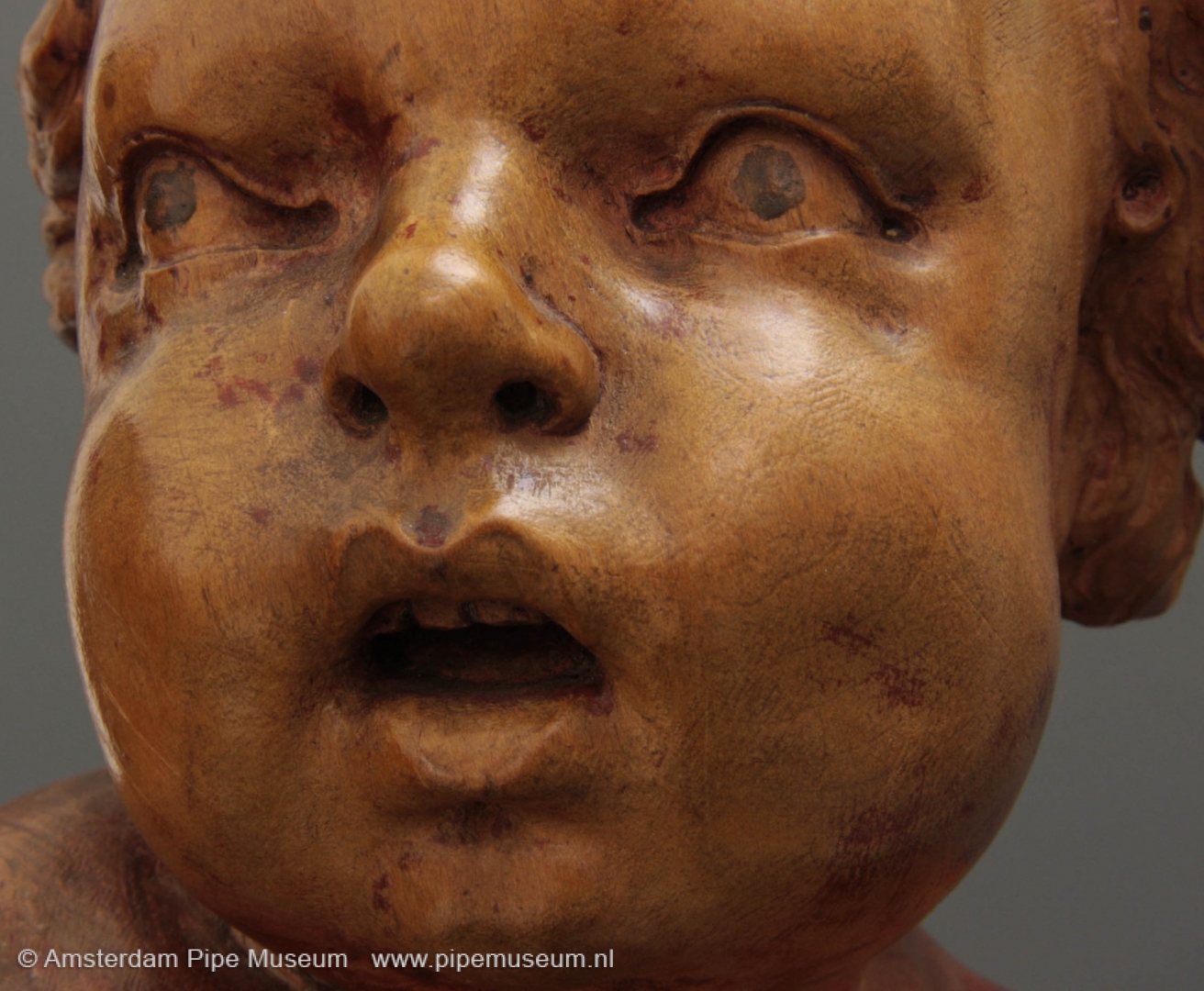
Today is the transfer of the Douwe Egberts collection to our museum. After we had already drawn up a list of wishes, this is the hour of truth. We can come to see what has been allocated to us and will receive it after cash payment. In fact, it is not so much a museum transfer, but rather a sale, with as a bonus a number of objects in the form of a donation. It is a pity that the takeover of the entire tobacco collection was not negotiable, we made that known from the first moment as our wish. The National Collection of the Netherlands is well endowed with the coffee and tea collection that will be well housed in various Dutch museums, but that is different with the tabacological objects. Douwe Egberts prefers to permanently erase the traces of their tobacco past, they eventually will continue as a coffee and tea company. Upon arrival, the group of purchase appears to have been properly selected, although it is not as large as we hoped for. After payment we can pack. When the work was done, we had a chat with Douwe Egberts' archivist, who enthusiastically shows us the digitization of their packaging collection. This care and dedication contrasts sharply with the scarce attention to the tobacco history and the limited pieces that we were allowed to buy from the museum collection. We learn that our subject is coming under increasing pressure.
_______________________________________________________________________________________________________________________________________________________
Diary excerpt 43: November 18, 2003
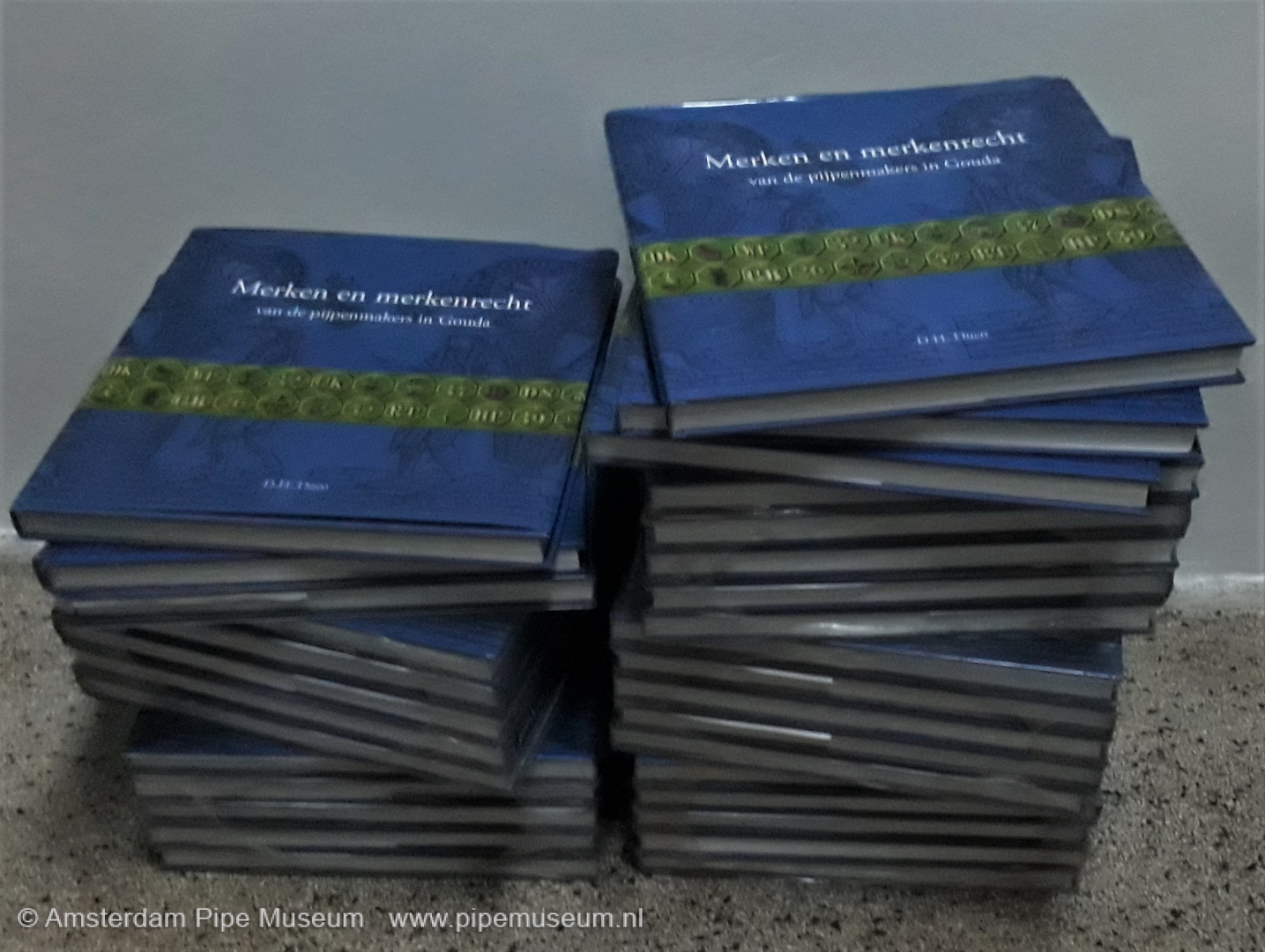
An immense transport truck marks the delivery day of the large book on Gouda pipe makers marks. Printer Koninklijke de Swart arrives and from the tailgate five pallets of books are placed in front of our warehouse, the sixth goes to the Prinsengracht. How big the book has become and moreover heavy, the total delivery is over 3000 kilos! The supplier deftly manoeuvres the pallets from the street into the warehouse, but the size is so large that after that our car no longer fits. Later, we’ll pack it more economically. It is a triumph to see the result so beautifully printed and bound after numerous years of hard work. For many evenings, with the help of Martien for the technical side, I worked on the layout of the book: meticulously listed all 1047 marks including all pipe maker names. This opus magnum should become a source of information for archaeologists in the coming decades. How many times will it be cited in the time to come? And, whatever you produce as a writer, inevitably corrections will come up in future! How many? Time will tell.
_______________________________________________________________________________________________________________________________________________________
Diary excerpt 44: September 21, 2004
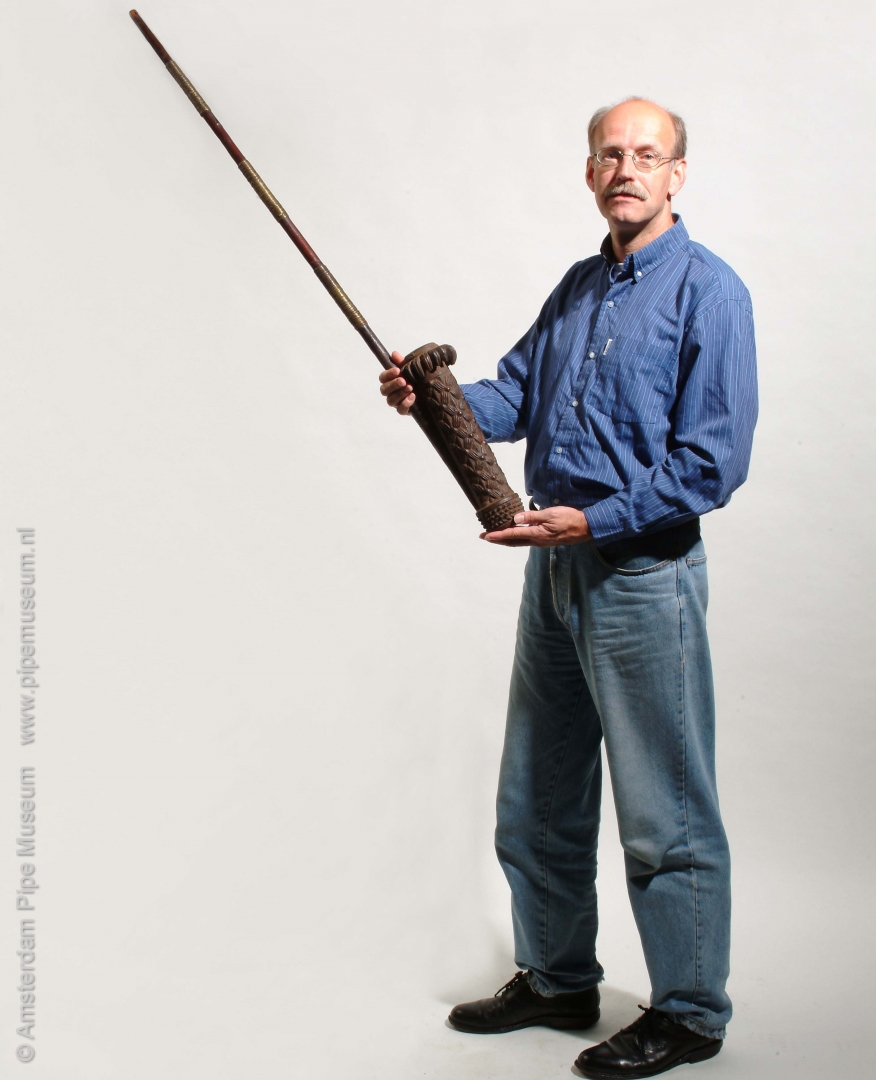
The idea of Savings Station Love for Items comes from the brain of Paul Spies, founder and director of Bureau D’Arts. Place of action: Open Air Museum Arnhem. We are invited to put forward our theme in the central room of the pavilion of special collections, right in the middle of the set-up. For ten years this will be the permanent focal point of the presentation, together with the collection of piggy banks that was the inspiration for the whole plan and is exhibited at the end of the pavilion. Six other rooms will have a changing content so that the dynamics remain: fountain pens, Swarovski crystal, statues of saints, you name it. Today is photo day. The showcases are set up and filled with a variety of pipes from all over the world, the interior is finished with fine Chesterfield sofas to enjoy the cosy smoking room, smoker's pictures hang along the bright red walls. The video is installed in which I provide expert commentary on eight remarkable pipes from the exhibition. Now a life-size portrait photo for the entrance. As for me, posing with an enormous Pipe-du-Chef from Cameroon in hand.
_______________________________________________________________________________________________________________________________________________________
Diary excerpt 45: November 18, 2004
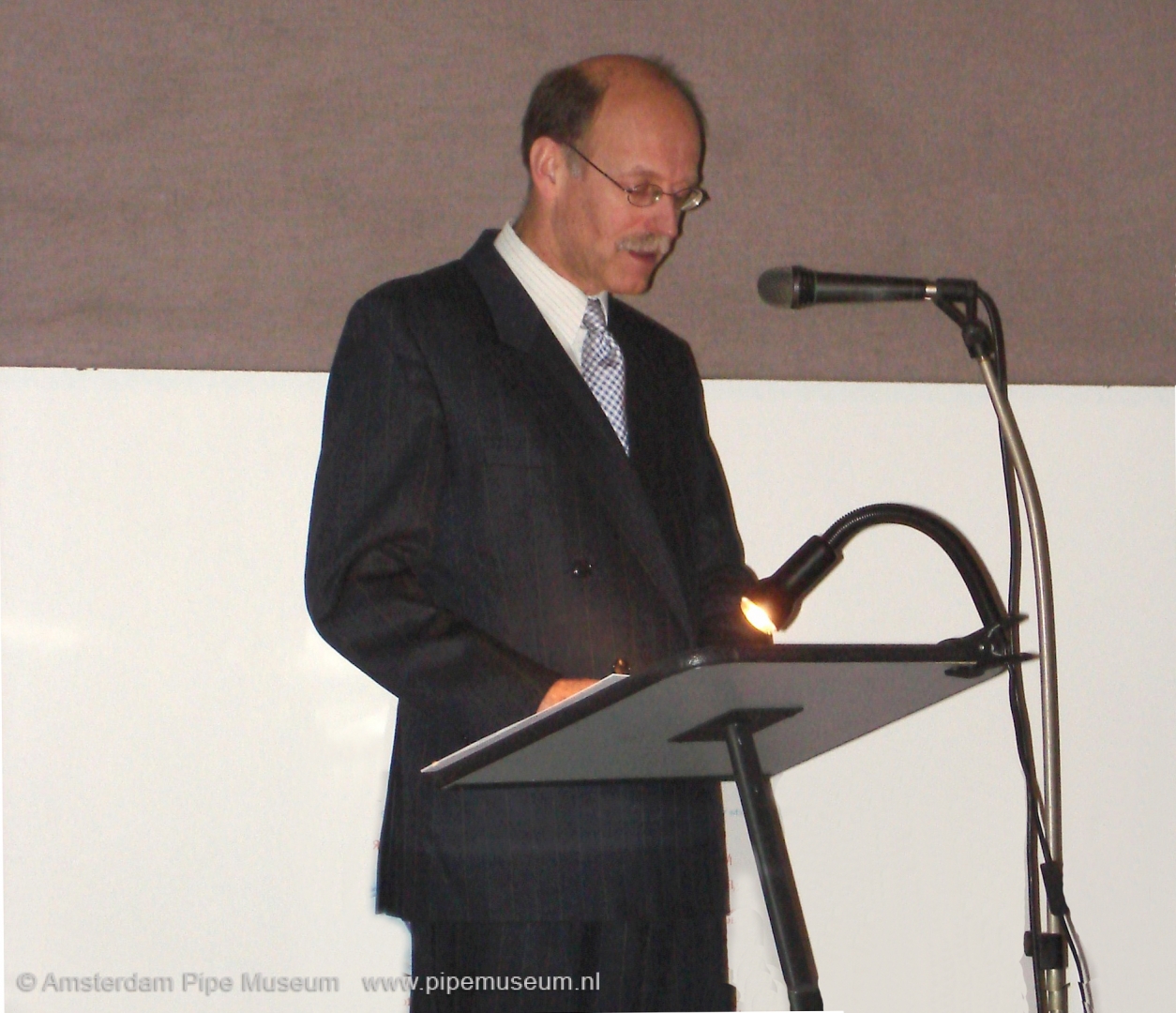
The Reuvensdagen are a major annual event where Dutch archaeologists meet and share their expertise. It is also the perfect place to give a presentation about the clay pipe, the neglected child of historical archaeology. Today, on Reuvens day 1, my lecture is scheduled. The research in Alkmaar, under the inspiring leadership of Peter Bitter, in which pipe finds from seventy find locations were compared, coincidentally matched with the publication of Century of Change, a book about the fashion sensitivity of the tobacco pipe. Reason for a lecture that I am happy to give. The largest audience ever with more than five hundred in the main hall of theatre De Vest. What a triumph if you can convince them of the importance of the clay pipe for archaeology and, in doing, also get them to laugh. When you are approached later in the corridors, you understand that the message has landed. The clay pipe has gained new prestige as an archaeological object.
_______________________________________________________________________________________________________________________________________________________
Diary excerpt 46: April 29, 2005
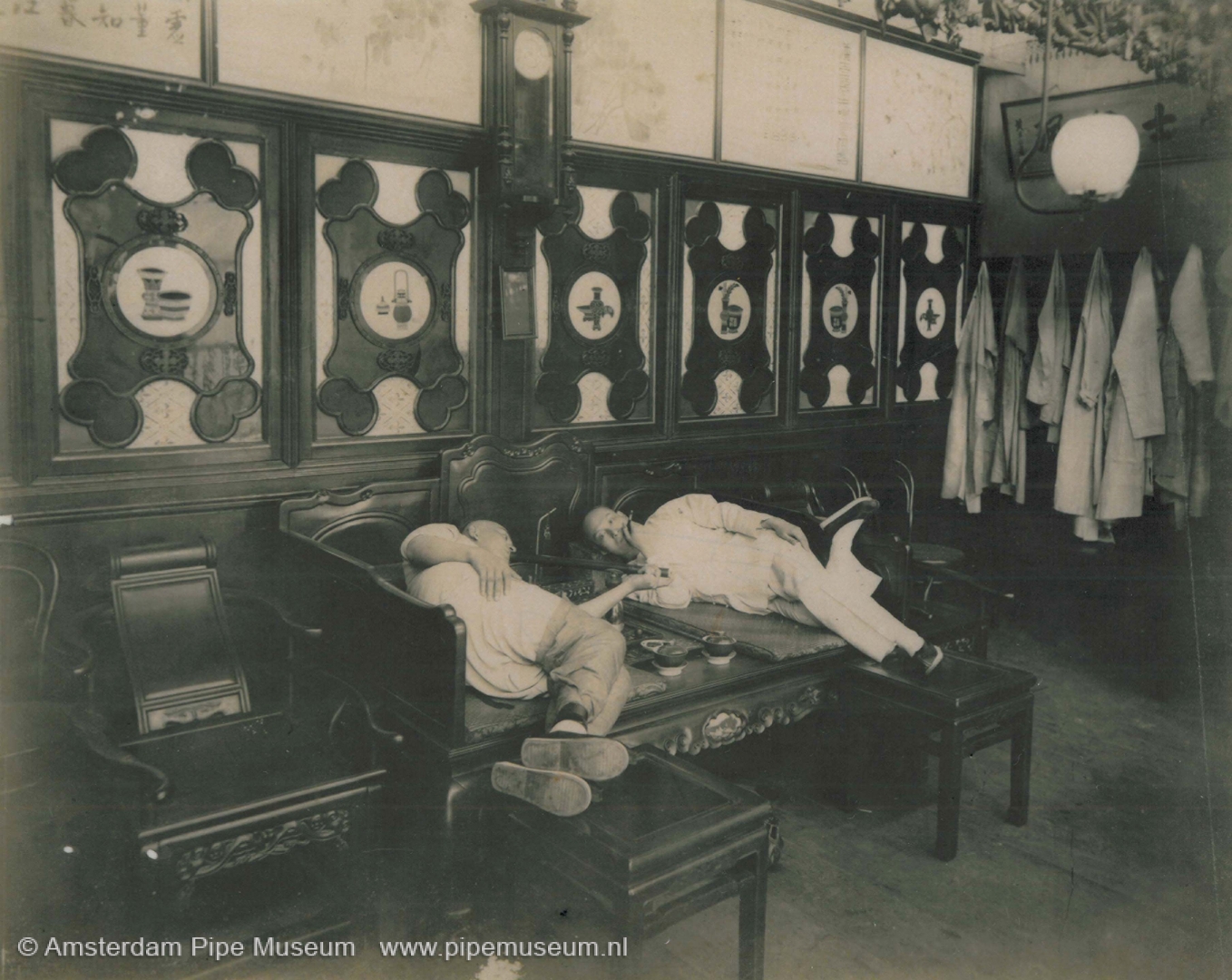
We even came up with an acronym for it: GOA or the Global Opium Association. No secret meetings as one might think, but simply the exchange of ideas among enthusiasts about collecting opium objects, including beautiful antique ones! Not without a wink to its background. Wolf Koslowki, Marbot Wiesbach, Ewald Vanvugt, Cees Hoogendoorn and more, united from half of Europe. Of course, in addition to the chatting, this also includes actual use. You hear so much about it, but of course nobody really used opium and if that is the case, it ends more often wrong than well. In addition to the opium, one should have the right instruments, the procedure is not that easy. But today is the day. We smoke opium in Amsterdam, led by an opium master initiated in Paris. Lying on a Chinese bamboo mat, a bit uncomfortable, with such a half-meter long pipe and burning oil lamp. Anyway, if you don't pay attention, you blow out the lamp. What a shame! But the experience is unique, you realize that when you wake up hours later out of the sensation of the dream and feel the benefits of an absolutely painless body. I have to think about whether this is suitable as a daily routine.
_______________________________________________________________________________________________________________________________________________________
Diary excerpt 47: February 18, 2006
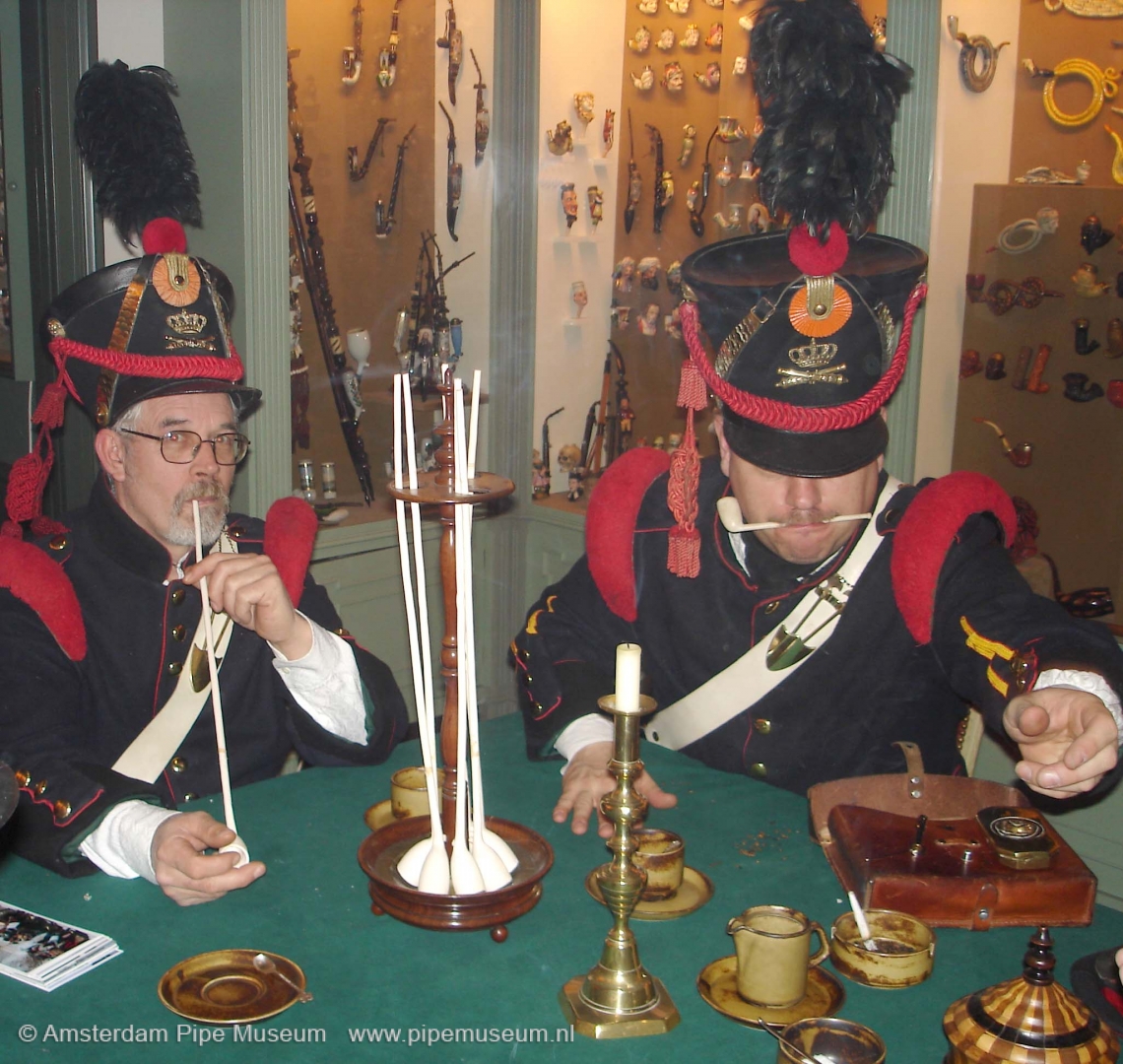
Gradually the days lengthen while the light brightens. Spring is in the air. The highlight of the visit in the past winter period was the Battery Batallion RA from Naarden. This special company consists of Napoleonic soldiers in authentic costumes. You really look out your eyes because those costumes are made by the members themselves with the utmost precision and an attention for detail. Beautiful materials applied with unmatched expertise. In the Pijpenkabinet these gentlemen and a few ladies got a tour focused on smoking in the Napoleonic era. Ultimately, they often perform in their outfit in the setting of living history. Obviously this should include a correct story about the importance of smoking in soldiers' circles. In passing we also paid attention to the countless Napoleon pipes displayed in our showcases. As usual, after the tour a lively Q&A. The visit was ended while enjoying a glass and smoking a pipe of tobacco. Even the non-smokers among the soldiers got a bit of practical experience on how to smoke a pipe.
_______________________________________________________________________________________________________________________________________________________
Diary excerpt 48: April 7, 2007
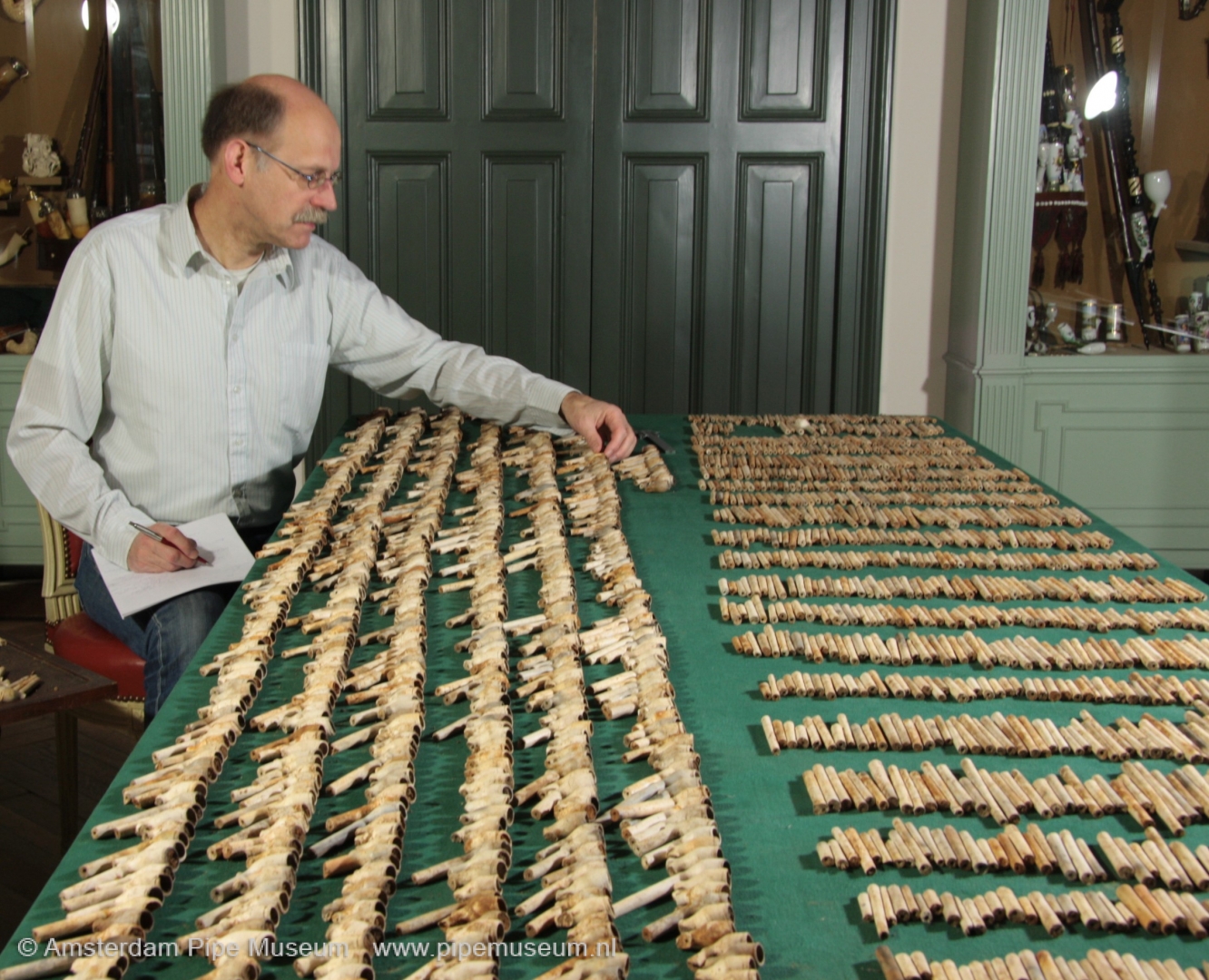
Today an appointment in Grootebroek to look at a collection of pipes recently found in Westeinde, a hamlet near Hoorn. It seems like a tip of interest because the material has a narrow time frame and can be an ideal study subject as a user group. Anyway, as is often the case with these private diggers, you are not received at their home but in the shed. Not even a chance for a drink to be offered. In short the offer is take it or leave it and at a high price the content is not convincing. Anyway, after some haggling the entirety is bought, paid for and taken with the ardent hope that the material will yield a good story. My goal is to better illustrate the phenomenon of the user group: a group of excavated pipes that have been used by one smoker or a fixed group of smokers and hopefully with a certain cohesion of pipe types that will reveal the social background of smokers and the commercial distribution pattern of yesteryear. Whether it is a good buy will only show after cleaning and putting the pieces in order. I am really curious!
_______________________________________________________________________________________________________________________________________________________
Diary excerpt 49: September 18, 2009
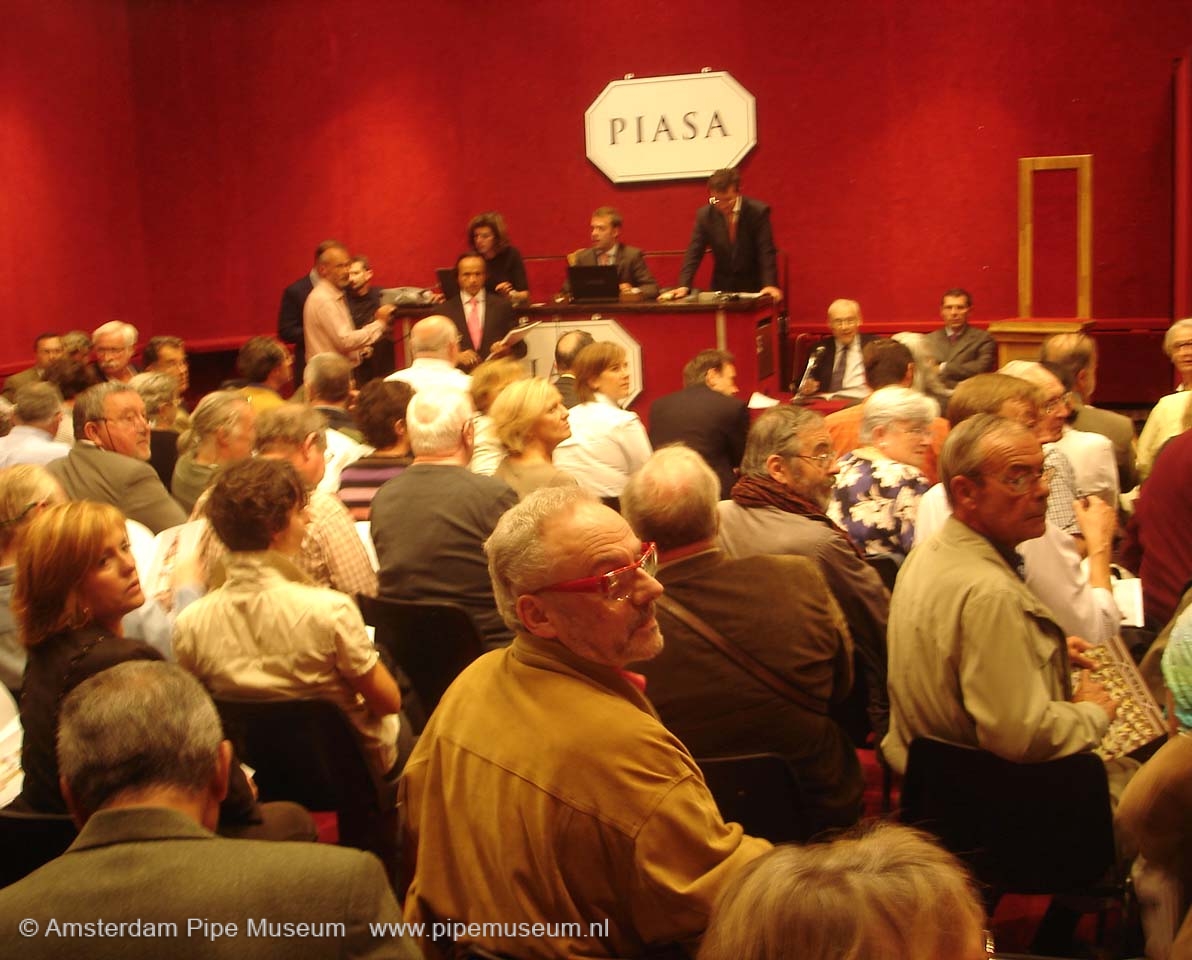
It is sweltering hot at Drouot’s, the large auction house in the centre of Paris, this afternoon when the masterpieces of the famous collection of the former Seita tobacco museum are put up for sale. The hall is packed, Felix van Tienhoven next to us, in the row behind Wolfgang Cremer, and many other important private collectors. But there are also many unfamiliar faces, probably trade. Everyone is bidding, it is not a happy auction in that respect. Especially not because of one particular individual in the front row who no one knows. He bids endlessly on everything that is good. Felix quickly renounces what he hoped for, Cremer leaves broke after his first purchase. We keep it up a bit longer and can still score a bit here and there. For the future, this is a day that will be recorded, since our purchases will already be in the database next week and will become the tangible reminder of the renowned Seita collection that preached tobacco history in Paris for sixty years. Although this day did not yield any real triumphs, our collection has increased again in quality as well as in variety.
_______________________________________________________________________________________________________________________________________________________
Diary excerpt 50: January 18, 2011
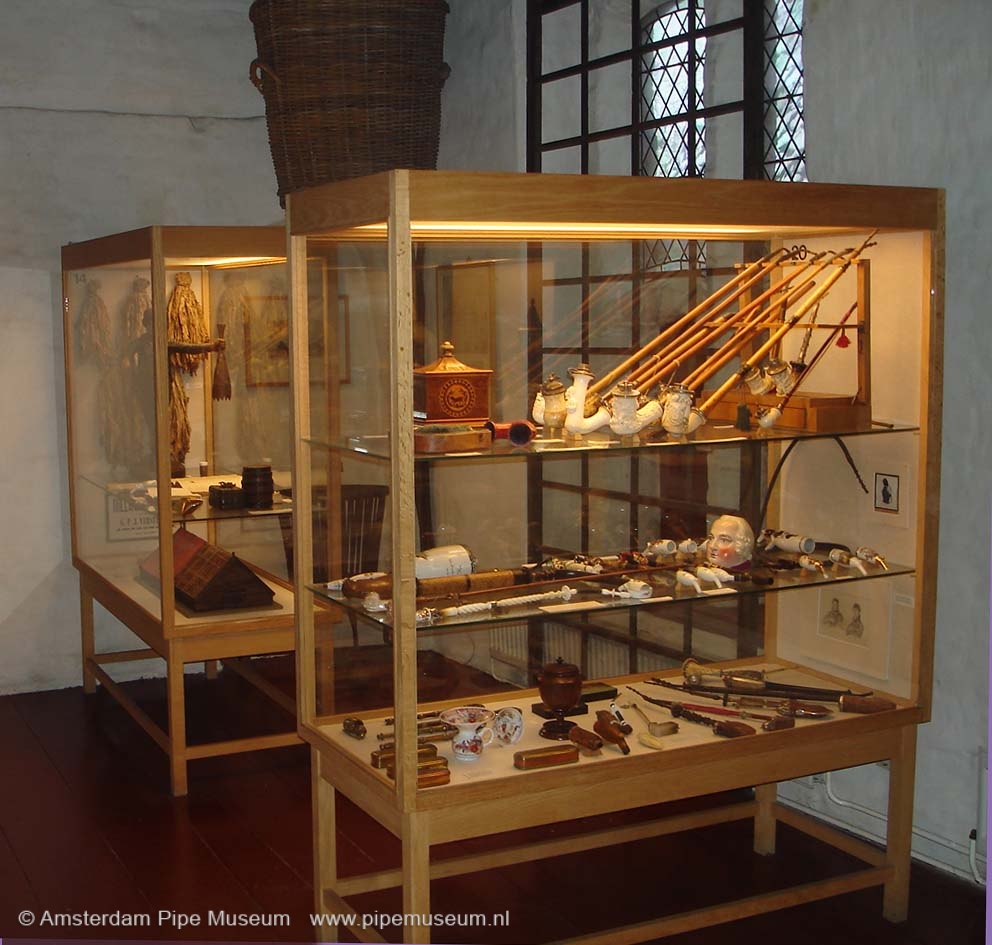
On the way to Groningen we remembered how unreal the situation is. As a boy I visited the Niemeyer Tabacological Museum on the Amsterdam Amstel, an established institution supported by a powerful firm. Today I am on the train to view the collection, prior to its auction. Niemeyer wants to get rid of it! In the morning I drew up a list of objects that are important to our collection in the Brug Street at the museum premises, in the afternoon I did the same in the museum depot behind the factory building. I am doing this together with the other interested parties for the acquisition of objects, ranging from the Rijksmuseum to an antiquity room on a Wadden Island. All in all, no more than twenty people. Well, Dutch museums are not really active in collecting. And the list that I drew up is long, there is a lot to see and a lot of material that should not escape the Collection of Dutch Heritage. It is really annoying that currently there is no valuation fixed by Christie’s, the auction house that makes out the final takeover price. By five o'clock my head is dizzy; I was allowed to write a little longer until I was thrown out at 5:30. That should be enough. Tomorrow we will send our wish list to the museum, what will be the outcome?
_______________________________________________________________________________________________________________________________________________________
Diary excerpt 51: March 3, 2015
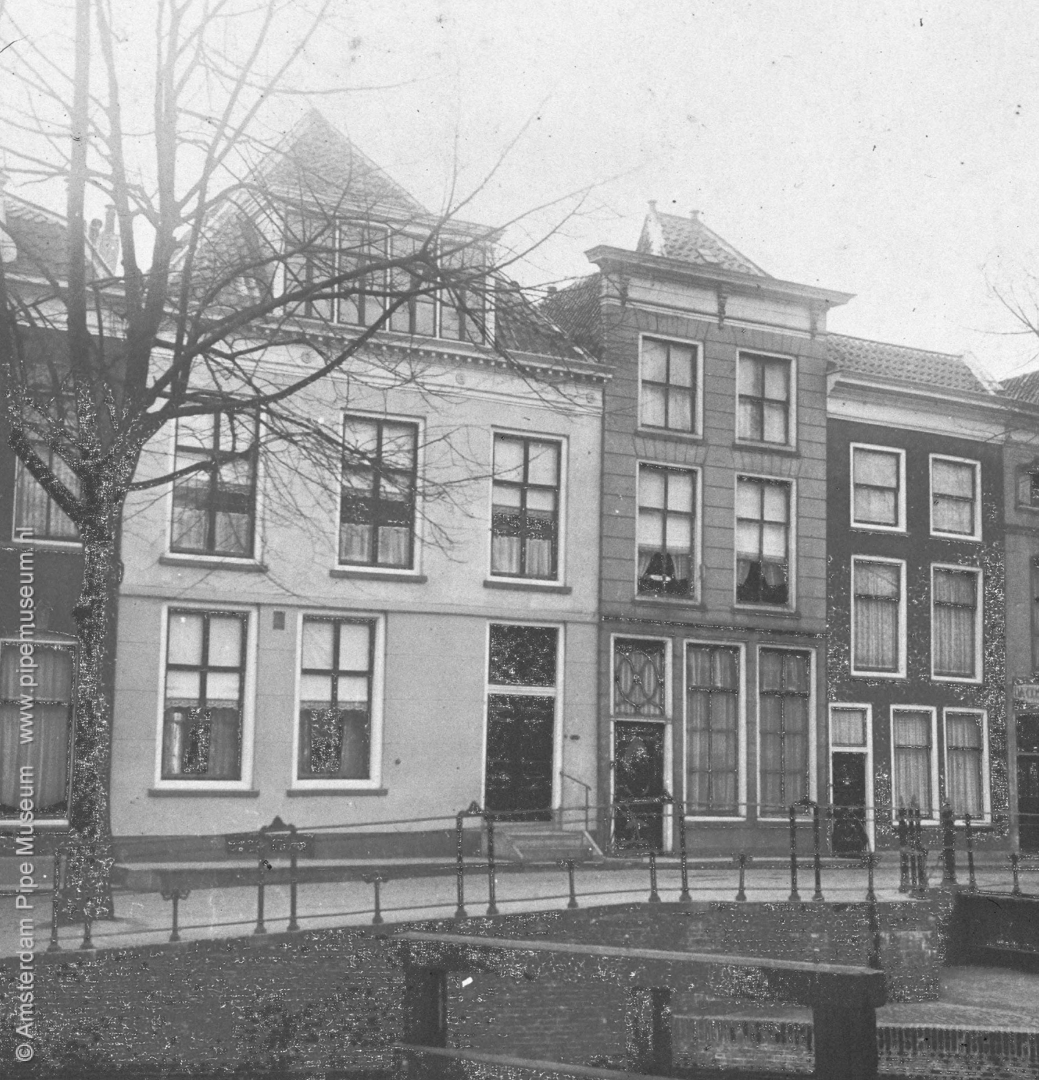
Today's program: two friendly invitations from monument owners in Gouda to visit their house. At the agreed time we ring the bell at Leon, Gouwe 99, who lives in the building where Abraham Goedewaagen established his pipe making workshop in 1823. This building remained in the Goedewaagen family until well into the twentieth century. Never before have I had the opportunity to take a look inside. The current owner is sensitive to the history of the house and has had it professionally restored, taking into account the historical details. Most impressive are the beautiful beams in the back house, now the master of the house’s study. How unexpected that this small-looking house offers so much space! In any case, you understand that a family could unite living and working here. After a tour we were introduced to the neighbour Jaap, resident of Gouwe 97, better known as the house with the stairs. Also this building was once owned by the Goedewaagen family, well into the last century. What a breath-taking hallway with beautiful brick arches! A wide building with magnificent proportions with a serene historical atmosphere. We took a moment to reflect on the stairs to the basement that changed the life of Nelly Goedewaagen forever in the post-war years. And who is not curious about the studio of the same artist Nelly in the attic, where the right incidence of light was provided by a large dormer window for unvarying northern light. Well, that room is now a great surprise: a professional music room. Our host turns out to be an connoisseur. In the catacombs we drink an excellent wine and chat, on the spot where the clay used to be rotting. We were very impressed by both special encounters. Not only for the insight into the residential culture of the Goedewaagen's, but also for the care taken by the current residents for the cultural heritage.
_______________________________________________________________________________________________________________________________________________________
Diary excerpt 52: December 21, 2016
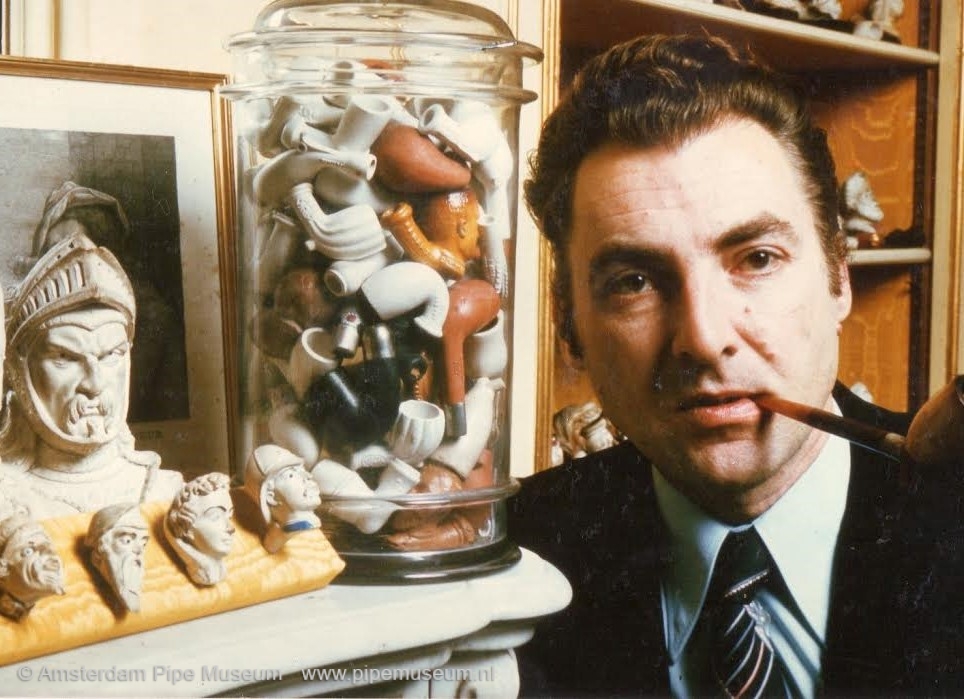
I cherish fond memories of the encounters with Alain and Elisabeth. Alain Demoly is such a sympathetic Parisian collector who has enjoyed collecting French figural pipes for a lifetime. On Saturdays he roamed the Marché-aux-puces. We were guests with him and his wife Elisabeth countless times, very pleasant evenings. However, times change, Alain fell ill and passed away, today his collection comes under the hammer. Drouot is the place of sale, Thomasson the expert. The 150 lots pass quite smoothly. A lot has changed since years. Where in the past everything was fought over, now there is only interest in high grade and top quality. You can see that in the revenues. The most beautiful pipes are sold for amazing prices, the usual good in lots of five or ten pieces at a time for little money. Although we try to avoid the madness of extreme prices, there is still enough for us to buy in rare materials or special designs. Ultimately, some fifty objects will be taken to Amsterdam. In that respect, Alains life's work will partly remain visible in future in our hands.
_______________________________________________________________________________________________________________________________________________________
Diary excerpt 53: March 2017
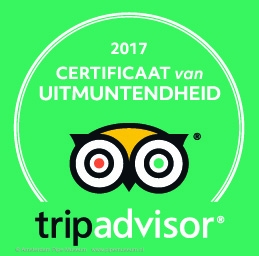
What a wonderful way of advertising it is, this Tripadvisor on the internet. Anyway, after we gradually got used to Facebook, there is now this new phenomenon. Tripadvisor, a place where you can find tips from travellers who have rated your attraction. It is such a thing that apparently everyone uses, but for us it is still a phenomenon to get used to. Nice to see that visitors can be so enthusiastic to take the trouble to write a positive review. They express themselves about the beautiful entourage or special pipes they have seen. The praise of the guides is also a frequently heard flattering comment. Apparently, their visit exceeds expectations. Fortunately, the number of reviews from visitors who come with the completely wrong expectation remains restricted, we are simply not Efteling or any other theme park and you cannot smoke weed here. Yes, we are happy not to comply with that. Fortunately, most museum visitors turn out to be overwhelmed by the unexpected richness and quality that the Amsterdam Pipe Museum offers. For those people we unbar the museum and we are proud of that.
_______________________________________________________________________________________________________________________________________________________
Diary excerpt 54: March 21, 2018
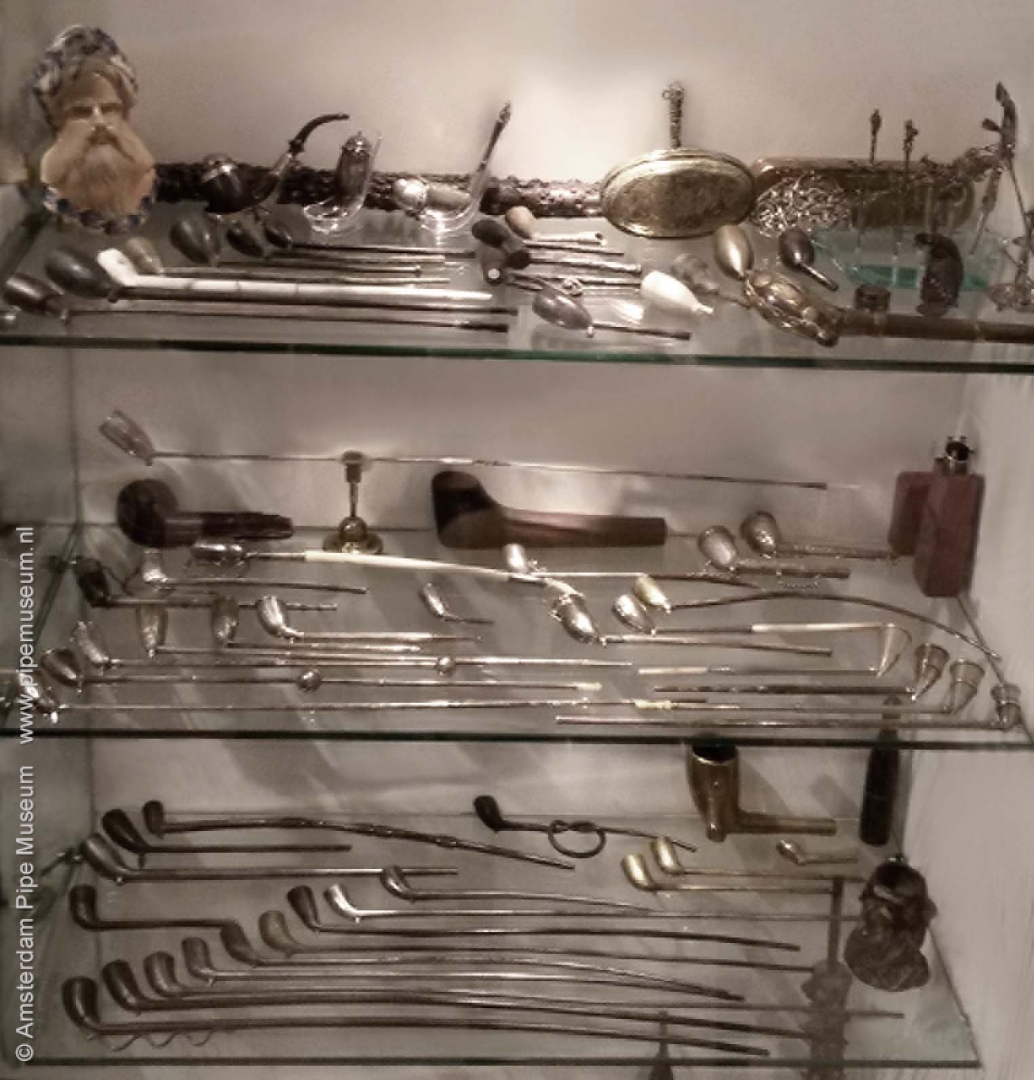
One of the most specialized collectors of pipes was Felix van Tienhoven. In his spacious bungalow in the Villa Park of Geldrop he had set up a real pipe room for his collection. His specialty was displayed in a wall-length full glass display case: smoking pipes made of metal. As a dedicated pipe smoker, he had a lifelong interest in the history of the tobacco pipe. He built up a collection, but over the last twenty years he developed as a collector in this quirky specialty. It is not certain whether this was prompted by his long stay in Japan. In any case, he and his wife Wijntje bought pipes for the collection on their frequent trips to all conceivable places. Later they also had objects brought in by antique dealers. On his death, the Pijpenkabinet Foundation turned out to be the beneficiary of the collection. Today the relocation of the collection took place. With us in Amsterdam, the material will be included in our database and thus be visible to the world. Also there will be a special presentation of this material in the hall of our museum.
_______________________________________________________________________________________________________________________________________________________
Diary excerpt 55: August 26, 2018
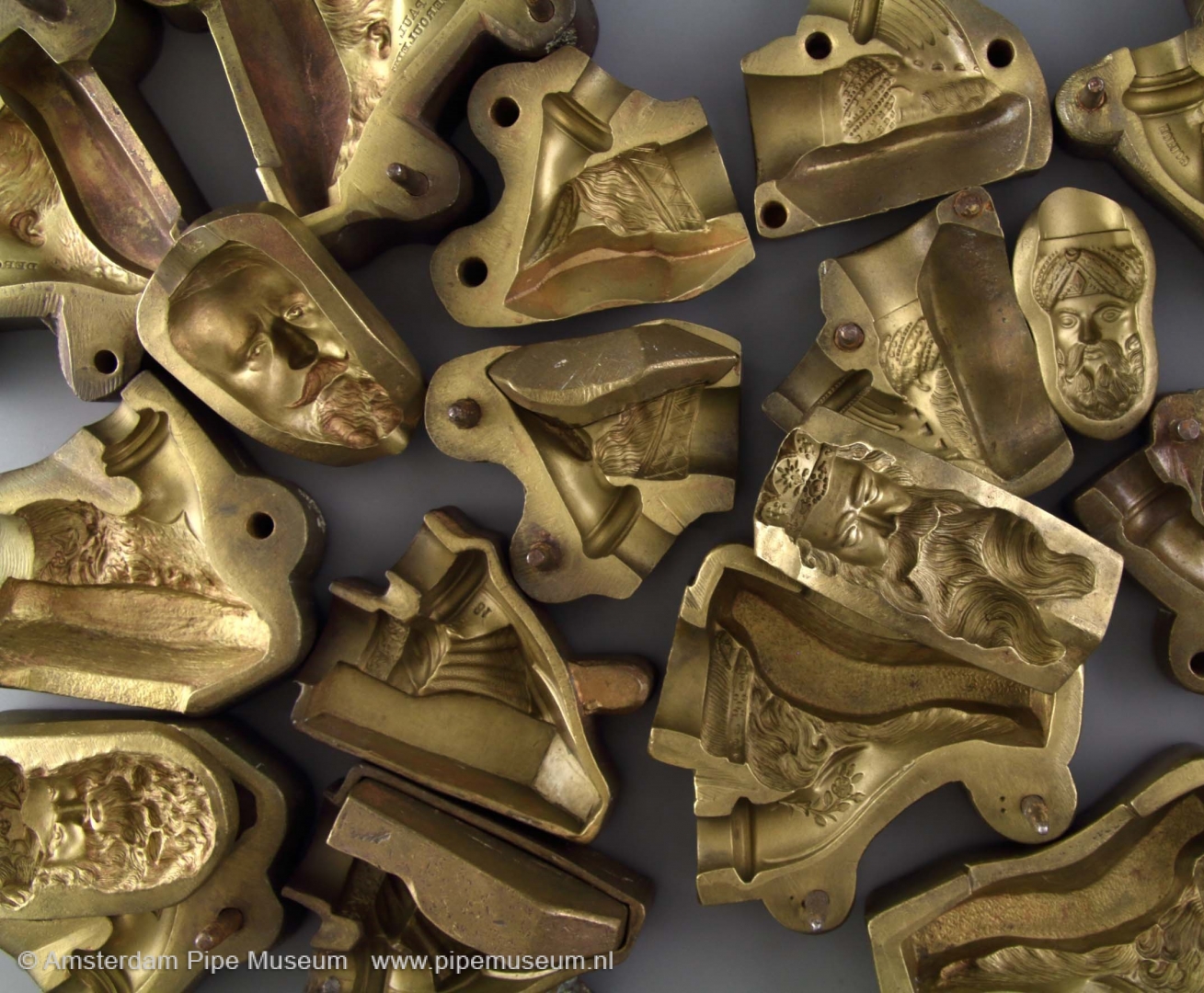
After the Hilson pipe factory was taken over by Koninklijke Gubbels from Roermond in 1979, parts of the historical archive and inventory moved to Roermond. Since then it has been well managed by Fons Gubbels, now retired director, who particularly cherished the historical tools of the firm Jean Knoedgen, a predecessor of Hilson. Nevertheless, today is the time to say goodbye to this material and move it for safekeeping to Amsterdam. An appointment in Limburg is of course accompanied by the traditional fruitcake, not just a slice, but a choice of flavours. While drinking coffee, Fons tells about the takeover of the factory at the time, his memory is still razor sharp. A little later we descend to his cellar where the material is stored in boxes. We quickly agree on the price, an ex-businessman is not difficult about it. This is how we become the owner and load the 150 press moulds into our car. Taken into account that the car can hardly handle the weight, we drive home carefully in moderate speed. Doubtlessly with a wealth of new historical information.
_______________________________________________________________________________________________________________________________________________________
Diary excerpt 56: February 5, 2019
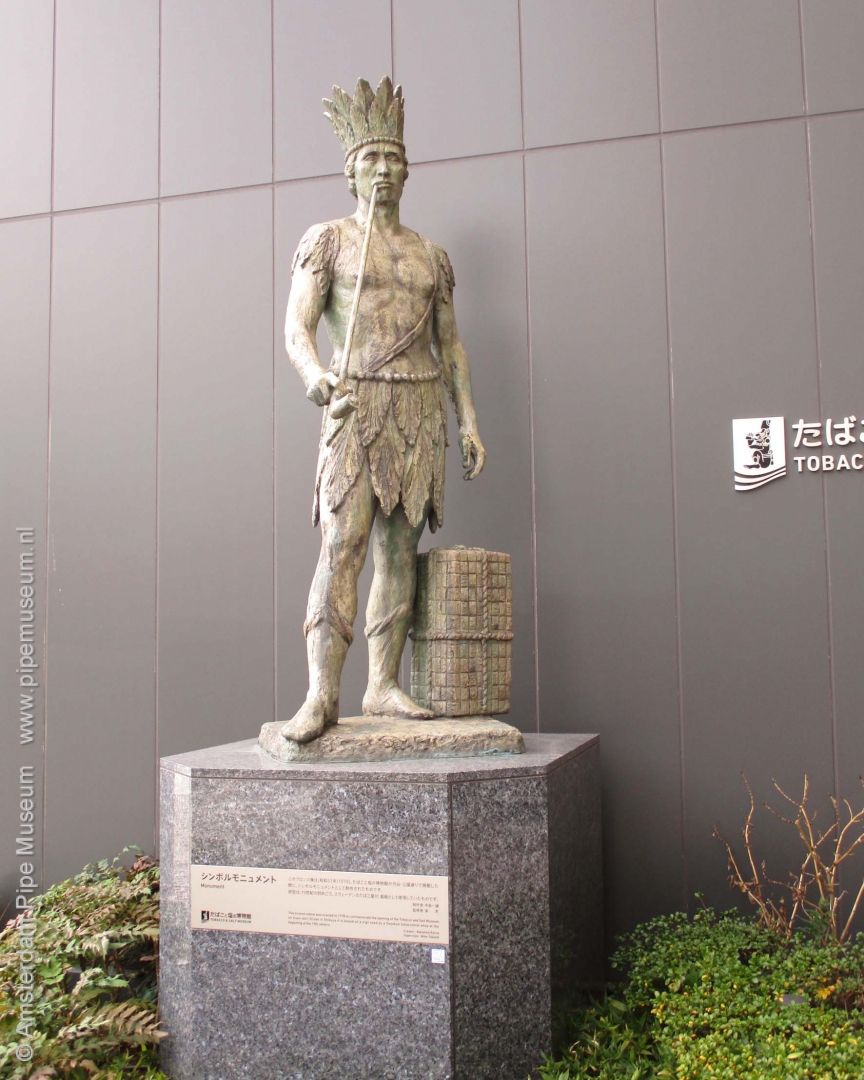
Today the long-cherished wish is being fulfilled: a visit to the Tobacco and Salt Museum in Japan. Located in the Sumida district, in the shadow of the immense Skytree Tower. Adjacent to gigantic buildings of the tobacco industry, the monumental museum building proudly stands there, fresh and new and above all megalomaniac. Inside everything is efficient and streamlined, of course fully air conditioned, the high floors connected by escalators. Nevertheless, the building is more of an industrial palace than a museum building, according to our Western taste experience. The tobacco presentation is on the second floor, the museum shop is downstairs, and the exhibition about salt and salt production is on the first floor. The Tokyo tobacco museum produces a collection catalogue in a series of books, in a range that is still expanding. Most of them are already in our library, so I know what to expect. The museum is impressive, with a spacious lay-out like the Japanese do. It turns out to be a permanent showcase of smoking around the world, with even a display case of clay pipes. It is most remarkable that the number of Japanese kiserus - the elegant pipes with a minimal bowl - is so poorly represented. The museum should have hundreds of them. Unfortunately, this sub-collection is not the cream of the crop because the really beautiful, artistic examples are missing.
_______________________________________________________________________________________________________________________________________________________
Diary excerpt 57: June 18, 2020
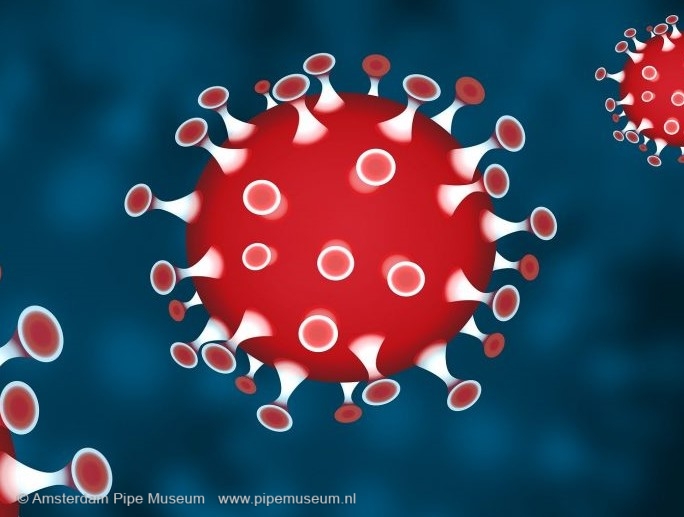
And then there is an unexpected incident during the celebration of the fiftieth anniversary. While we are preparing for a spring party, an unpredictable virus comes in from China: Covid-19. Society is screwed up, museum visits are over. In March all museums were closed due to the corona virus, first for a few weeks, soon for longer. Man withdraws into himself. How long will this take, what will it change? Also our museum has closed and when it will open again, the flow of visitors might be over. One individual is afraid of the other, social interaction is disturbed. We will have to adjust to a new normal and a new morality. The role of the museum must be reconsidered.
_______________________________________________________________________________________________________________________________________________________
Diary excerpt 58: August 2020
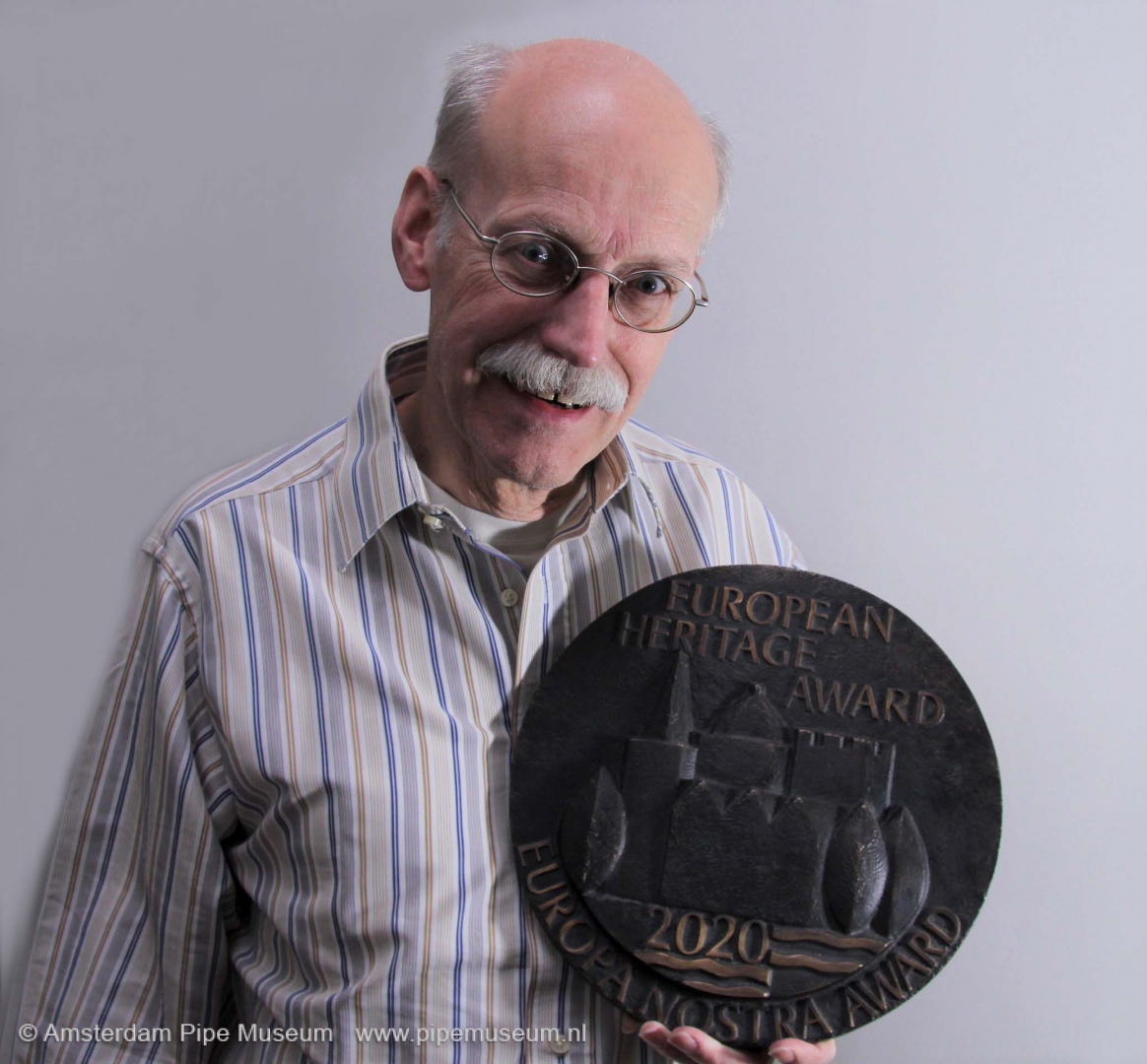
A better end to 50 years of collecting and research is hardly imaginable: I received the European Heritage Award from Europa Nostra, an honourable award presented by the European Commission. Unfortunately, Mrs. de Commissioner has to address me via Zoom, I will receive the gigantic medal with certificate separately by courier. So, maybe I can keep credit on a solemn ceremony with a festive drink another year. In any case, the plaque is impressive, we still have to find a place on the wall for that. The prize is really intended for long-term commitment to cultural heritage, in English simply formulated as Dedicated Service. That is absolutely a recognition for what I have done: committing myself to the museum, even to some sort of aspersed and maligned heritage. Because of the collection, the museum and my publications, the pipe really is now a mirror of society, as the jury report so beautifully states.
_______________________________________________________________________________________________________________________________________________________
Diary excerpt 59: epilogue
And then suddenly, while you have entertained yourself, kept yourself busy, learned a lot, experienced everything, the activities turn out to have last for half a century. You have lived fifty years through all those different events and activities, always with the pipe as the central theme. One thing passed into the other smoothly, and it was all inspiring in its own way. And what is so special: the work is still just as challenging, stimulating and innovative. There are always unexpected things to experience, things to discover and facts to be recorded. The more you do and the longer you work, the more intense your interest becomes, the better your understanding and connection with the subject. On the other hand, everything also becomes more relative, because in the end time overtakes everything. Publications are aging, museum presentations are being cut short, people's morality and mentality are shifting, the world needs other things. Anti-smoking and disinterest are today's threats, but the personal motivation behind the challenge seems indestructible and is still there. I can no longer say on to the next fifty years, but to stop is certainly no option.